
Title: Around the world in eighty minutes
Author: William S. Walsh
Release date: December 14, 2022 [eBook #69543]
Most recently updated: October 19, 2024
Language: English
Original publication: United States: Henry Altemus, 1894
Credits: Tim Lindell, Charlie Howard, and the Online Distributed Proofreading Team at https://www.pgdp.net (This file was produced from images generously made available by The Internet Archive/American Libraries.)

Transcriber’s Note
The photographs in this ebook always follow their descriptions, even if the reading device places a photograph at the top of a page, above the description of the next photograph.
Larger, higher-resolution versions of the illustrations may be seen by right-clicking them and selecting an option to view them separately, or by double-tapping and/or stretching them.
Photographic Reproductions of the Most Magnificent Edifices, the Most Interesting Remains and the Most Beautiful Scenes on the Earth’s Surface
WITH DESCRIPTIVE TEXT
BY
WM. S. WALSH
PHILADELPHIA
HENRY ALTEMUS
1894
Copyrighted, 1894, by Henry Altemus
Altemus’ Bookbindery, Philadelphia
3
TRAVEL is the greatest of educators, the greatest of civilizers. To come in contact with men and manners different from those to which we have been accustomed by birth is to broaden the mind; to teach it forbearance, sympathy, wisdom; to rob it of its philistinism; to make it cosmopolitan and not provincial. To come face to face with the great monuments of the past and of the present, to see what man has done and is doing, is to get a new idea of the vastness, the imaginative strength, the creative power of the human mind, to renew your respect for your kind and for yourself, because you belong to that kind. It may teach you your own littleness, indeed, in itself a useful lesson. But it also teaches you the greatness of that aggregate of little individuals to which we give the generic name of man. And to learn this lesson of reverence for man is to kin yourself with what is best and holiest in man.
4
Horse-power, sails, steam, electricity are all at your bidding to-day, ready harnessed to transport you where you will. If you wish to travel, the world is yours to command. Fictitious heroes have circled it in eighty days; real men and women have accomplished the feat in less time. A little leisure and a little money will enable you to do what a century or so ago would have been impossible to the greatest potentate on earth, with twenty-four hours of leisure every day, and the wealth of Indies at his beck and call.
But if you have not the little leisure, if you have not the little money, you can travel without them. You can travel without passing out of your room, without quitting your chair. The resources of modern science are inexhaustible. Mahomet, though a prophet, had to go to the mountain because the mountain would not come to him. But you need not go to the mountain; modern science will make it come to you. You have but to say the word.
Here, in this book, for example, are one hundred photographs of one hundred of the most famous sights, scenes and monuments in the whole world. To see these sights, these scenes, these monuments, is to attain a liberal education. Now what is seeing? Seeing, the philosopher will tell you, is to have certain waves of light strike your eye and create an impression on your retina of the objects that are in front of you. The retina, in other words, is nothing but a natural camera obscura. And what is a photograph? A photograph is a modern invention whereby, by means of an artificial camera obscura, the sun, the author of all light, is cunningly induced to bind upon paper forever5 the impression made by the actual waves of light set in motion by certain objects. Remember it is not a picture of that object formed by some individual man and blurred by the personality of the individual who made it. It is the actual sight, the actual scene, the actual monument, or what not, just as it would have met your natural retina if you had been there, and simply reflected from the artificial retina into your natural one. The sun is the true realist—faithful, literal, exact. Would we not cheerfully exchange Giotto’s portrait of Dante for a photograph by Sarony, had Sarony and his camera existed in Dante’s day; or Wagner’s Chariot Race for an instantaneous photograph of the great Colosseum, with its surging crowds of humanity? The men and women in Wagner’s masterpiece are vivid and life-like; as types they are faithful and exact, but the instantaneous photograph would give you the very outer form and semblance, the body and almost the soul, of individuals who had once lived, who are now once again living before you. Savages are said to shrink from being photographed, deeming that a part of themselves passes into the picture, and the superstitions of savages are metaphors in which civilized men read a poetical hint of the truth.
Here, then, are one hundred of the greatest of human monuments and the most magnificent of earthly scenes brought into your very presence by the witchery of modern science. The selection has been made with the greatest care so as to be truly representative of all ages, people and climes. Each photograph is accompanied by a pains-taking and accurate description which6 briefly but succinctly sums up the information that the reader needs for his guidance. Here, therefore, is a trip round the world with the services of a guide thrown in, and that trip can be accomplished pleasantly and without fatigue at an expense which is too ridiculously small to mention.
Well may the modern laugh at Mahomet and his mountain, and snap his fingers at Phineas Fogg and Nelly Bly. Eighty days quotha! Seventy? Sixty? Nay, eighty minutes will suffice.
7
| PAGE | |
| The Statue of Liberty | 12 |
| The Tower of London | 14 |
| Westminster Abbey | 16 |
| St. Paul’s Cathedral | 18 |
| Houses of Parliament, London | 20 |
| Bank of England, London | 22 |
| Mansion House, London | 24 |
| London Bridge | 26 |
| Trafalgar Square, London | 28 |
| Thames Embankment, London | 30 |
| Kenilworth Castle, England | 32 |
| Warwick Castle, England | 34 |
| Windsor Castle, England | 36 |
| Shakespeare’s House | 38 |
| Osborne House, Isle of Wight | 40 |
| Blarney Castle, Ireland | 42 |
| The Lakes of Killarney, Ireland | 44 |
| Giant’s Causeway, Ireland | 468 |
| Edinburgh Castle, Scotland | 48 |
| Holyrood Palace, Edinburgh | 50 |
| Melrose Abbey, Scotland | 52 |
| Abbotsford, Scotland | 54 |
| Fingal’s Cave, Scotland | 56 |
| Forth Bridge, Scotland | 58 |
| Balmoral Castle, Scotland | 60 |
| Loch Katrine, Scotland | 62 |
| North Cape, Norway | 64 |
| The Kremlin, Moscow, Russia | 66 |
| The Church of St. Basil, Moscow | 68 |
| Royal Museum, Berlin, Germany | 70 |
| Brandenburg Gate, Berlin | 72 |
| Cologne Cathedral, Germany | 74 |
| Heidelberg Castle, Germany | 76 |
| Ehrenbreitstein, Germany | 78 |
| The Cathedral, Antwerp, Belgium | 80 |
| Palais de Justice, Brussels, Belgium | 82 |
| Field of Waterloo, Belgium | 84 |
| Notre Dame Cathedral, Paris | 86 |
| Place de la Bastille, Paris | 88 |
| Place de la Concorde, Paris | 909 |
| Place Vendome, Paris | 92 |
| Garden of the Tuileries, Paris | 94 |
| Arc de Triomphe, Paris | 96 |
| Napoleon’s Tomb, Paris | 98 |
| Chamber of Deputies, Paris | 100 |
| Grand Opera House, Paris | 102 |
| Eiffel Tower, Paris | 104 |
| The Trocadero, Paris | 106 |
| Chateau de Fontainebleau, France | 108 |
| Garden and Fountains, Versailles, France | 110 |
| Grand Trianon, Versailles | 112 |
| A Bull Fight, Seville, Spain | 114 |
| The Alhambra | 116 |
| Cordova, Spain | 118 |
| Rock of Gibraltar | 120 |
| Monte Carlo | 122 |
| Lake Lucerne, Switzerland | 124 |
| Mont Blanc, Switzerland | 126 |
| Mer de Glace, Switzerland | 128 |
| The Matterhorn, Switzerland | 130 |
| Rigi-Kulm, Switzerland | 132 |
| Thun, Switzerland | 13410 |
| Jungfrau from Interlaken | 136 |
| Cursalon, Vienna, Austria | 138 |
| Cathedral, Milan, Italy | 140 |
| Panorama of Venice, Italy | 142 |
| St. Mark’s, Venice | 144 |
| Grand Canal, Venice | 146 |
| Doge’s Palace, Venice | 148 |
| Cathedral and Leaning Tower, Pisa, Italy | 150 |
| Ponte Vecchio, Florence, Italy | 152 |
| Palazzo Vecchio, Florence | 154 |
| Cathedral of Florence | 156 |
| The Capitol, Rome, Italy | 158 |
| Castle of St. Angelo, Rome | 160 |
| St. Peter’s, Rome | 162 |
| The Colosseum, Rome | 164 |
| The Pantheon, Rome | 166 |
| Tomb of Cecilia Metella, Rome | 168 |
| The Forum, Rome | 170 |
| The Bay of Naples, Italy | 172 |
| Pompeii, Italy | 174 |
| The Acropolis, Athens, Greece | 176 |
| The Bosphorus, Constantinople, Turkey | 17811 |
| The Mosque of St. Sophia, Constantinople | 180 |
| The Sphinx, Egypt | 182 |
| The Pyramids of Gizeh, Egypt | 184 |
| Ruins of the Temple of Amenophis, Karnak | 186 |
| Church of the Holy Sepulchre, Jerusalem | 188 |
| Garden of Gethsemane, Jerusalem | 190 |
| Ruins of Baalbek, Syria | 192 |
| Taj Mahal, Agra, Hindostan | 194 |
| The Pearl Mosque, Hindostan | 196 |
| Yosemite Valley, California | 198 |
| Big Trees, Mariposa Grove, California | 200 |
| Geysers, Yellowstone Park, Wyoming | 202 |
| Grand Canon, Yellowstone Park | 204 |
| Cliff Dwellings, New Mexico | 206 |
| Masonic Temple, Chicago | 208 |
| Niagara Falls | 210 |
| The Thousand Islands | 212 |
| Victoria Bridge, Montreal | 214 |
| The Capitol, Washington, D. C. | 216 |
| The White House, Washington, D. C. | 218 |
| Independence Hall, Philadelphia | 220 |
| The Brooklyn Bridge | 222 |
12
THE STATUE OF LIBERTY. This colossal statue, by Auguste Bartholdi, stands on Bedloe’s Island in New York harbor. It is distinguished, not only by its immense height (three hundred and five feet six inches from foundation to torch), but by the elegance of its proportions and its imposing dignity. At night, especially, when the torch is lighted by electricity, its effect is unique and commanding. The statue was presented to the American people by France, the cost being defrayed by public subscription. The sculptor himself took no remuneration. Public subscription here put up the pedestal. The statue was formally handed over to the President of the United States by the French delegates on October 28th, 1886.

14
THE TOWER OF LONDON, ENGLAND. In all the world there is no more famous fortress than this ancient citadel of London. Situate in the oldest portion of the city, on the north bank of the Thames, it at once arrests the attention of every stranger in the English metropolis. Tradition ascribes its erection to Julius Cæsar, but tradition is unsupported by historical evidence, and at the most it is only conjectured that the Romans had a fortress on this site. It may be stated authoritatively, however, that the Keep or White Tower (so named because it was formerly whitewashed), which is now the oldest extant portion of the citadel, was built by William the Conqueror. As the council chamber of the ancient kings of England, and subsequently as a prison of state for political offenders, its glory and its shame are part and parcel of the glory and the shame of all England. Some of the most momentous events in the history of the country were enacted within its walls. From an early period it has been the depository of the ornaments and jewels of the crown.
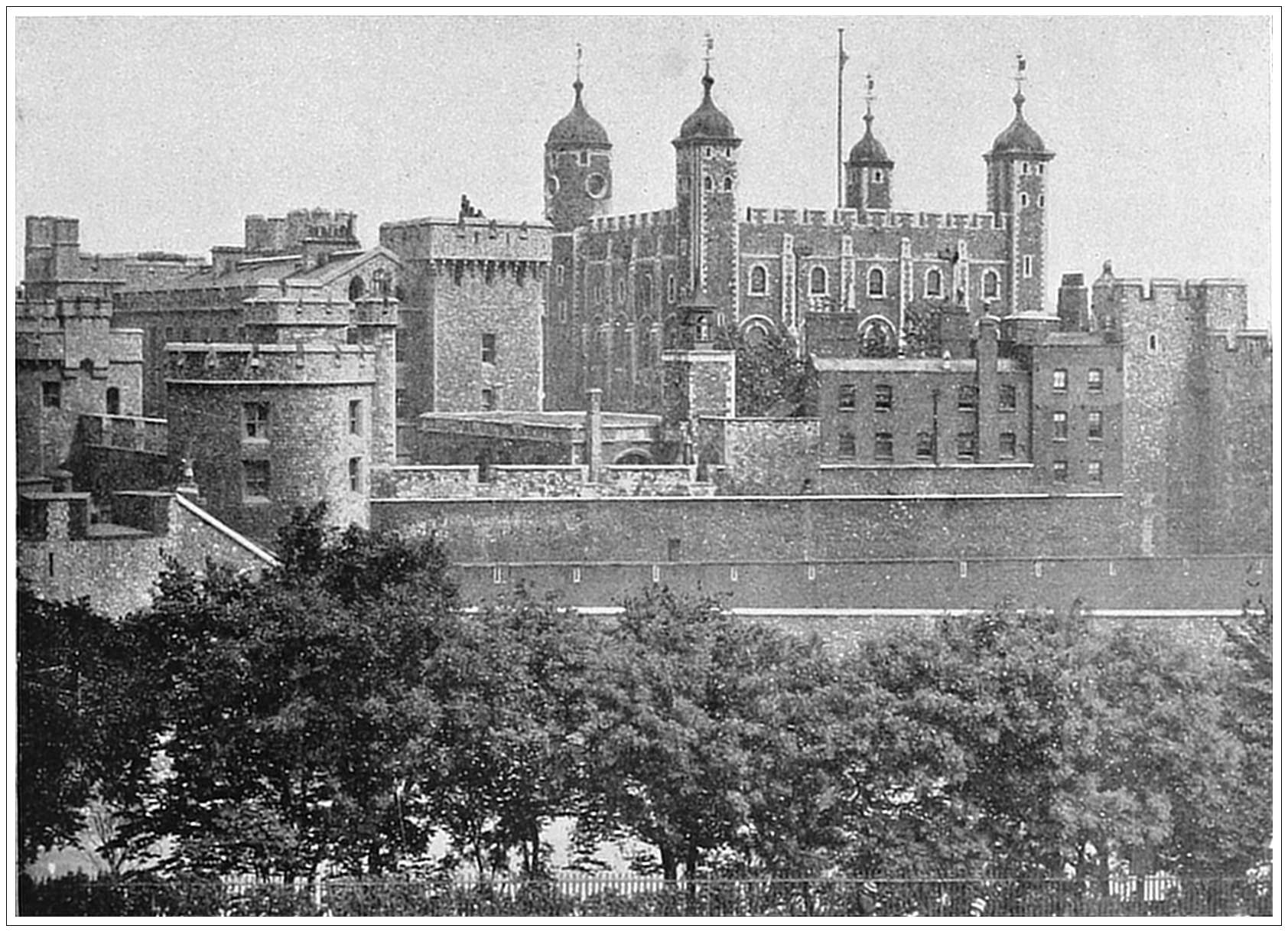
16
WESTMINSTER ABBEY, LONDON. This is the supremely interesting spot in all London. Its exquisite architecture would alone ennoble it. But as the sepulchre of sovereigns, heroes, statesmen, authors and poets, as the scene of some of the most hallowed events in English history, it makes an even more serious appeal to the imagination. Its very history is involved in becoming mystery. Tradition asserts that on this site Sebert, King of the Saxons, built a church and dedicated it to St. Peter. More authentic history ascribes its inception to Edward the Confessor, who designed it for his own burial place. Hence, other royal interments followed. William the Conqueror was crowned here within a few yards of the Confessor’s tomb, and every succeeding sovereign of England has followed his example. It also has continued to be the favorite spot for royal weddings and funerals. As it now stands the Abbey was for the most part rebuilt by Henry III. Henry VII added the famous chapel which bears his name, and the two towers on the front were placed there by Christopher Wren. The Poet’s Corner in the south transept contains tombs or monuments in honor of many of the most famous of English literary worthies.
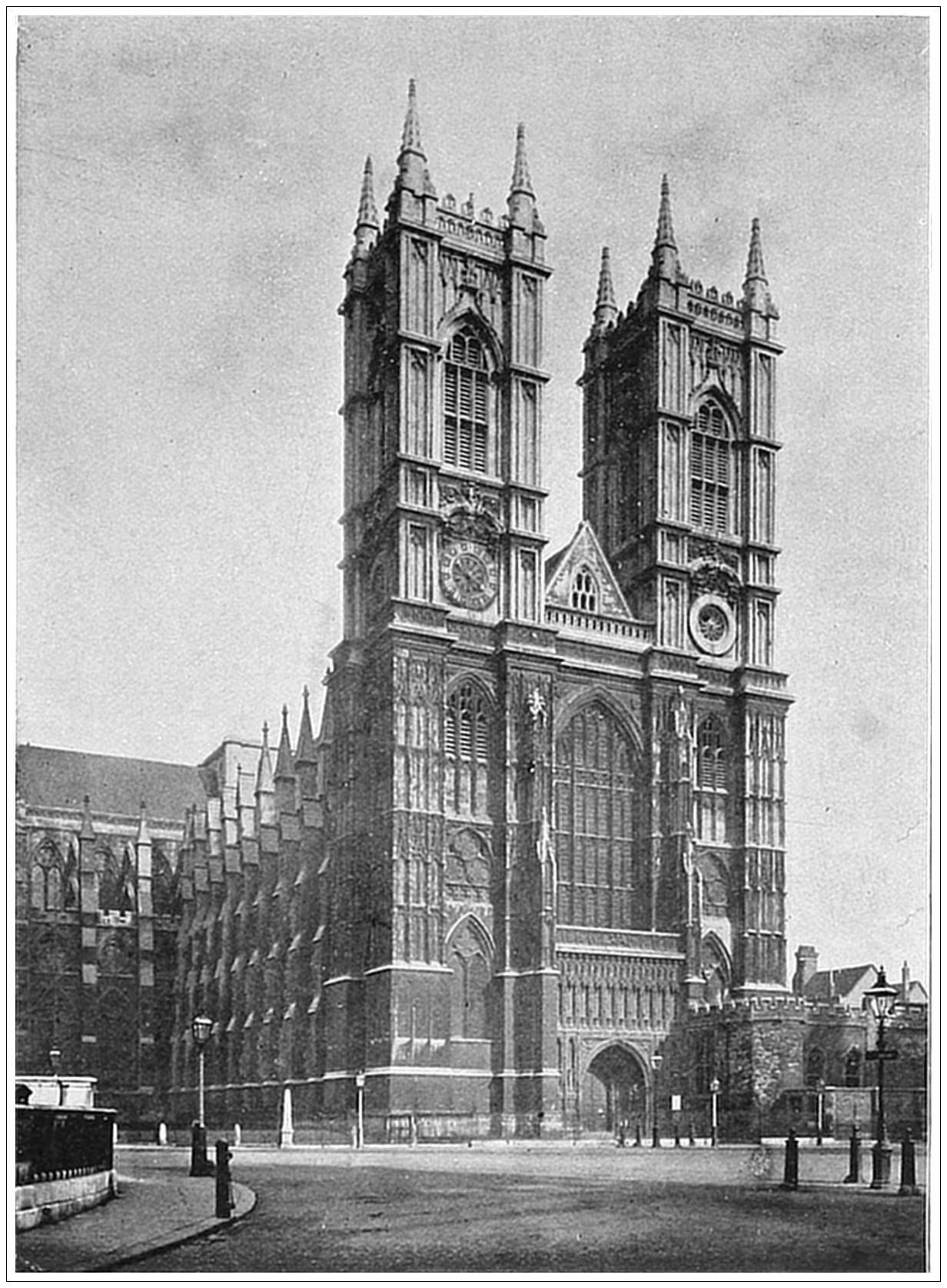
18
ST. PAUL’S CATHEDRAL, LONDON. This, the metropolitan church of London, is one of the largest and, without exception, the most conspicuous of its edifices. Built on a slight eminence, which is said to have been anciently occupied by a temple to Diana, it is the last of a series of Christian churches that succeeded to the Pagan temple. The first, founded about 610, was destroyed by fire in 1087. The second succumbed to the Great Fire of 1666. The present church was begun June 21st, 1675, and was finished in thirty-five years, under one architect, Sir Christopher Wren. The whole cost, £747,954 2s. 9d., was paid by a tax on every chaldron of coal brought into London. The structure is five hundred and fifty feet from east to west by one hundred and twenty-five feet in width; the front is one hundred and eighty feet wide, and the top of the cross is four hundred feet from the crypt floor. Carlyle said of it that it was the only edifice that struck him with a proper sense of grandeur.

20
HOUSES OF PARLIAMENT, LONDON, ENGLAND. This is the largest, and in some respects the most imposing, of all the public edifices in England. Gothic in style, in size, at least, it surpasses any other Gothic building in the world. And in respect to its equipments and the excellent adaptation of every part to the purposes for which it was erected and for the transaction of the business to which it is consecrated it is absolutely unrivaled. Both Houses, Lords and Commons, meet within its walls. Yet it is a comparatively modern structure. Occupying the site of the Royal Palace, dwelt in by every English monarch from the time of Edward the Confessor to Queen Elizabeth, the corner-stone of the present building was not laid until April 27th, 1840. It covers about eight acres of ground, and has four fronts, the longest and most effective of which, facing the river Thames, is nine hundred and forty feet long. The Victoria Tower at the south-west angle, which is about three hundred and forty feet high and admirably proportioned, is one of its most effective features.

22
BANK OF ENGLAND, LONDON. This, the most celebrated moneyed institution in the world, is situated on Threadneedle Street. Hence, it is sometimes facetiously alluded to as “The Old Lady of Threadneedle Street.” It has a branch in the West End of London and nine branches in the provinces. It was founded July 27th, 1694, as a joint stock association, with a capital of £1,200,000, which was lent at eight per cent. interest to the government of William and Mary. And as it began as a servant of the government so it has continued. At the present moment it has the management of the public debt and the paying of interest thereon, it holds the deposits belonging to government and aids in the collection of the public revenue. It is the bank of all the other banks in England. Its notes are legal tender, and are convertible into coin. Its credit and reputation have been absolutely unequaled by any other establishment of the sort. Hence, the recent discovery of a deficit of £5,000,000 shook the financial world to its centre. But the bank has been able to meet the emergency.
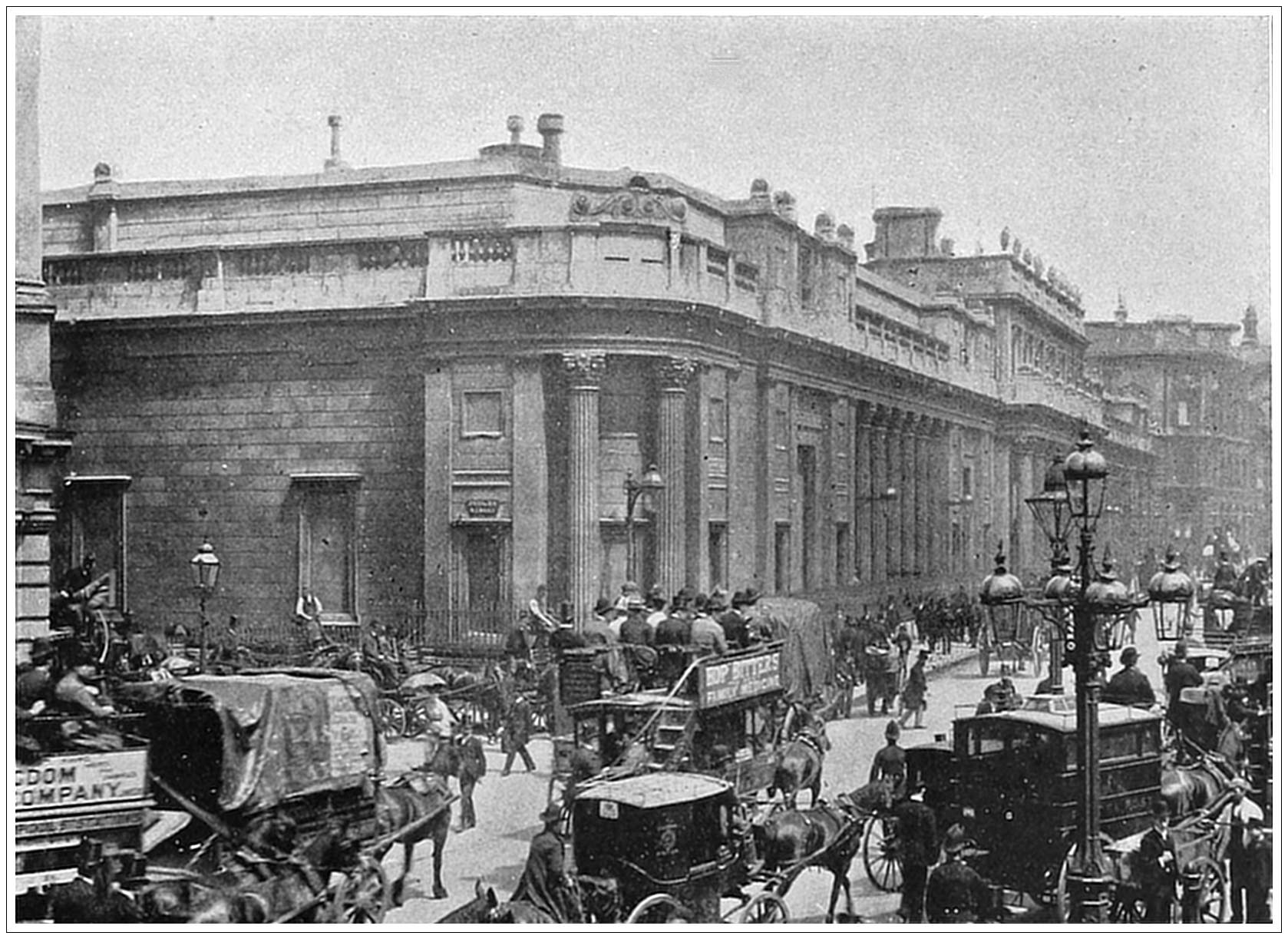
24
MANSION HOUSE, LONDON, ENGLAND. The Lord-Mayor of London has his official residence at the Mansion House. It is situated nearly opposite the Royal Exchange, on the site of the ancient Stock’s Market; was begun in 1739 and finished in 1741. In its great banqueting hall, known as the Egyptian Hall, are given the state banquets. Formerly it was the ambition of every great London merchant and banker to become Lord-Mayor, but since the district actually under his jurisdiction has come to be a very small part of what is known as London, the importance of this functionary has greatly diminished in the eyes of all save foreigners. As the dispenser of civic hospitality he receives £8000 a year, with the use of the Mansion House, furniture, carriages, &c.

26
LONDON BRIDGE, LONDON, ENGLAND. This is not the London bridge of Shakespeare’s time, for that was a wooden structure, lined with houses on either side. The present London bridge is substantially built of granite on the site of the older one. It cost £2,566,268, and was opened to the public on August 1st, 1831, by King William IV. There are five arches, the central one having a span of one hundred and fifty-two feet. The entire length is nine hundred and twenty-eight feet and the width fifty-four. A curious interest attaches to the lamp posts along the side, which are cast from the metal of French cannon captured in the Peninsular War. The constant stream of traffic that pours across this bridge is prodigious. It is estimated that every twenty-four hours no less than twenty thousand vehicles and one hundred and seven thousand pedestrians are borne along in the opposing currents.
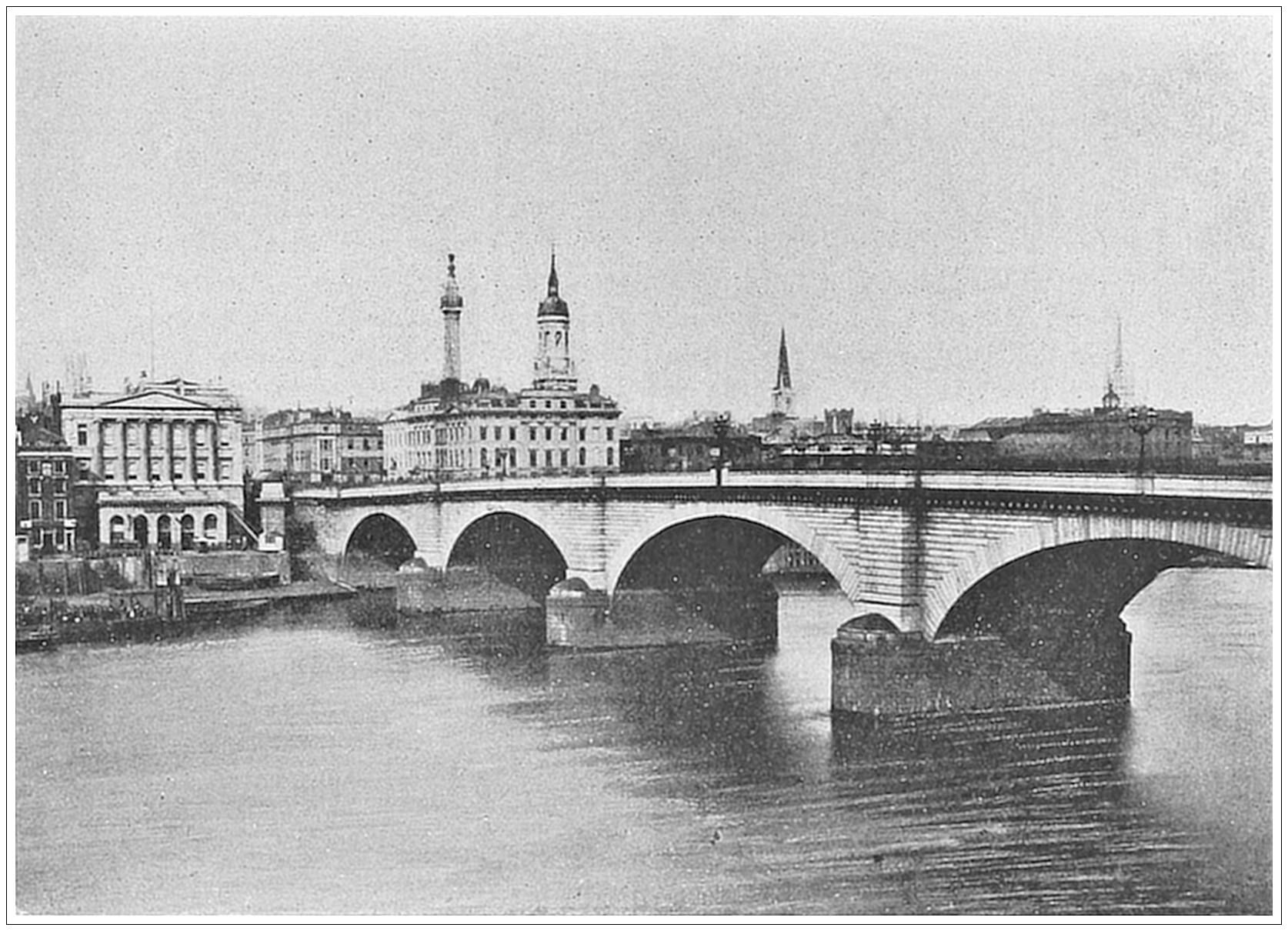
28
TRAFALGAR SQUARE, LONDON. The battle of Trafalgar (22d October, 1805) was won over the combined French and Spanish fleet by the English, under Lord Nelson, who lost his life at the very moment of victory. One of the finest open places in London is named after the conflict. In the centre a massive granite column, one hundred and forty-five feet in height, rises to the memory of the great admiral, whose statue surmounts it. The pedestal is adorned with reliefs in bronze, cast with the metal of French captured cannon, and representing scenes in the career of Nelson. Four colossal bronze lions, modeled by Sir Edwin Landseer, in 1867, crouch upon pedestals running out from the column in the form of a cross. The square is paved with asphalt. Statues of Sir Henry Havelock, of Sir Charles James Napier and of George IV are distributed around it. Towards the north side are two fountains, and on the terrace to the north rises the National Gallery, with the interesting old church of St. Martin in the Fields by its side.

30
THAMES EMBANKMENT, LONDON, ENGLAND. At an early period the banks of the Thames River had many wide stretches of marsh land, covered by shallow lagoons. From time to time embankments have been erected, some of them dating from the time of the Romans. The greatest of all these works is the new Victoria Embankment, leading from Blackfriars Bridge towards the west, along the north bank of the Thames as far as Westminster. Built in 1864–70, under the direction of Sir Joseph W. Bazalgette, it cost nearly $10,000,000. It consists of a macadamized carriageway about two thousand three hundred yards in length and sixty-four feet wide. The foot pavement on the land side is sixteen feet broad and on the river side twenty feet. This entire area was formerly covered by the tide twice a day. A granite wall eight feet thick protects it on the side next the Thames. Rows of trees have been planted along the sides of the Embankment, which will eventually make it a shady and delightful promenade. At intervals are large openings, with stairs leading to the floating steamboat piers. It is illuminated at night by electricity.
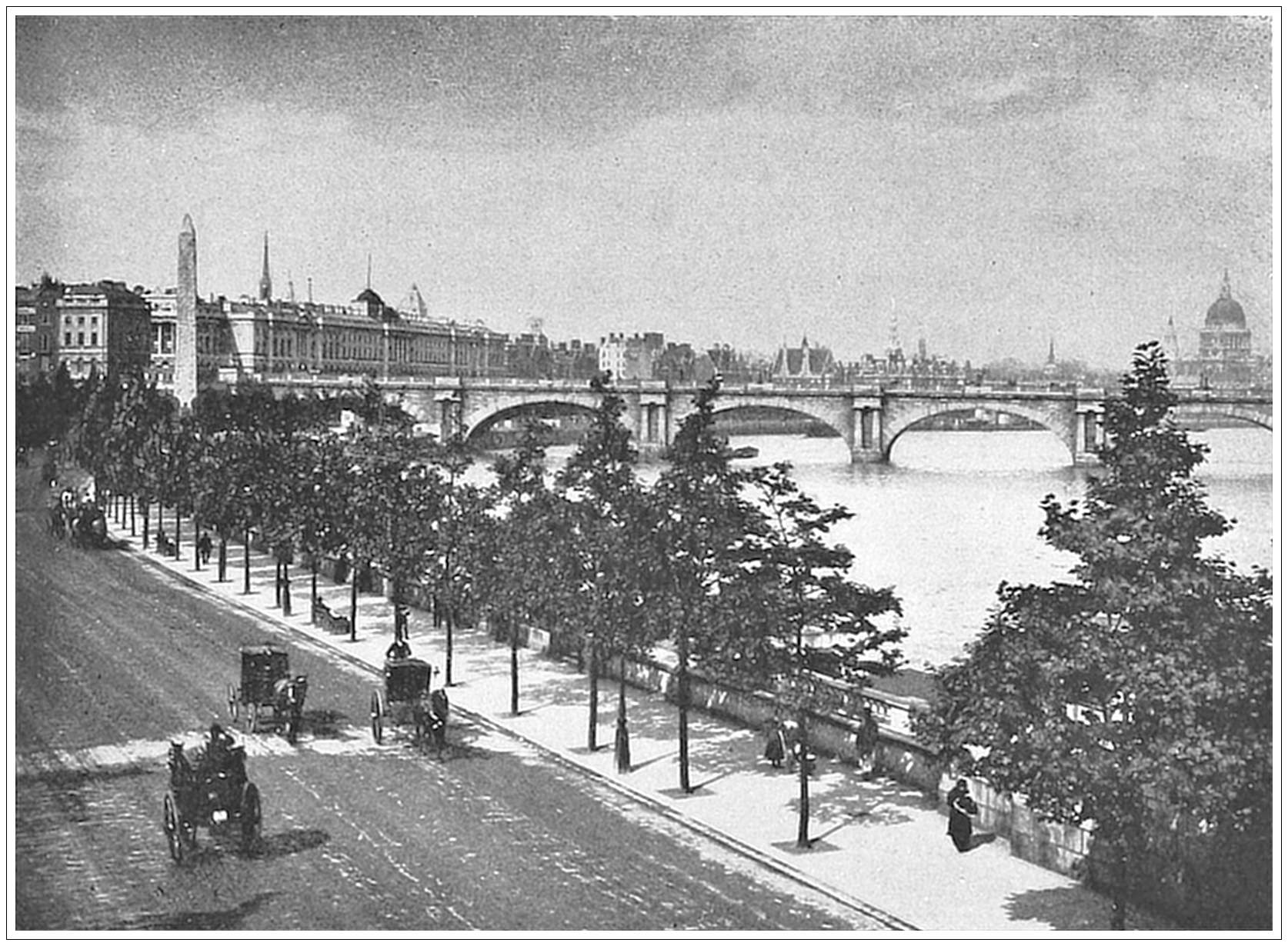
32
KENILWORTH CASTLE, ENGLAND. One of the stateliest of feudal remains in all England is this ruined castle, situated on rising ground to the west of the village of Kenilworth. Picturesque in itself, famous as it is in history, it yet derives its chief charm from the glamour thrown over it by Walter Scott in the novel which he has named after it. Kenilworth Castle first takes a prominent position in history as one of the strongholds of Simon de Montfort, Earl of Leicester, in his rebellion against Henry III. Subsequently it passed into the possession of John of Gaunt, who enlarged and beautified it. But its highest fame results from the fact that Queen Elizabeth bestowed it upon her favorite, Robert Leicester, Earl of Dudley, and it was here that Amy Robsart ended her unhappy life. Cromwell dismantled the castle. Since his day it has suffered much from the ravages of time, but even in ruins it retains a potency to delight and to impress.

34
WARWICK CASTLE, ENGLAND. Beautiful in itself, famous as the residence of the Earls of Warwick, and especially of him who went by the title of the King-maker, Warwick Castle is one of the most notable edifices in England. Nothing could be more picturesque than its situation on a rock washed by the Avon. Its two towers are surpassingly beautiful. The one known as the Clock Tower is here represented. Its battlements and turrets are full of quaint interest. The grounds which surround it are a triumph of landscape gardening. And the castle itself is almost a thousand years old. Legend declares that it was founded in 915 by the daughter of King Alfred, Ethelfleda. In the war with the barons in the reign of Henry III it was partially destroyed. In the reign of Edward III it was restored and strengthened. Additions and improvements have successively been made. In the reign of James II it passed into the hands of the Grevilles, and has remained their property ever since.
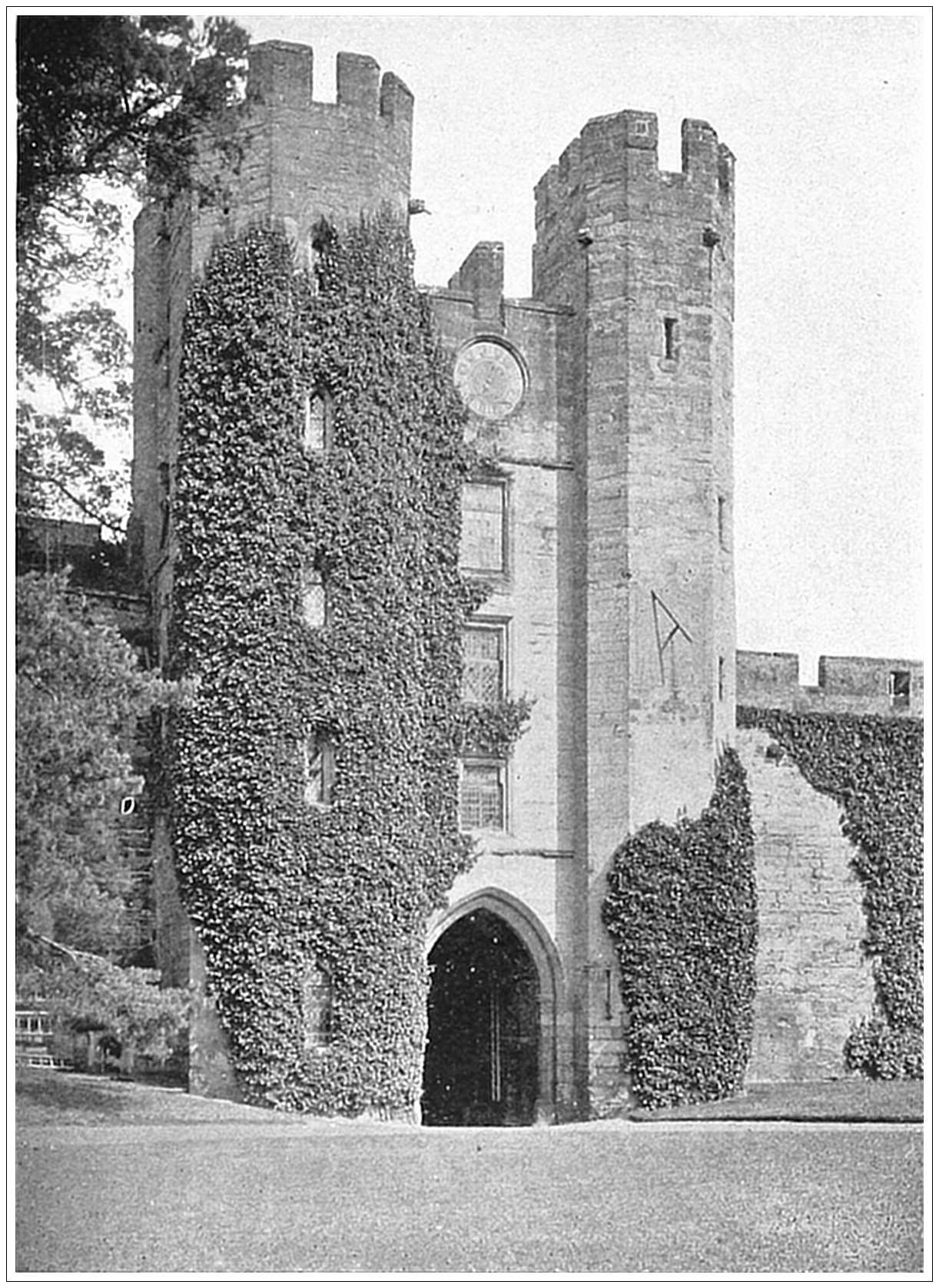
36
WINDSOR CASTLE, ENGLAND. The favorite residence of the English sovereigns, which distinction it merits through its own beauty, the beauty of its surroundings and its opulence of historical and legendary associations. Long before the Normans landed in England it was the seat of the Saxon Kings. But William the Conqueror founded the present castle; it was rebuilt by Edward III, was extended by successive sovereigns, and, finally, in the reign of Queen Victoria, was brought to its present perfection. The town of Windsor is some twenty miles from London. On a promontory, overlooking the Valley of the Thames, stands the castle. Its chapels and its terrace are among the noblest in Europe. The interior is lavishly decorated, and contains valuable paintings, statuary, furniture, tapestries and plate. In its vaults lie the bodies of the Kings and Queens of England.
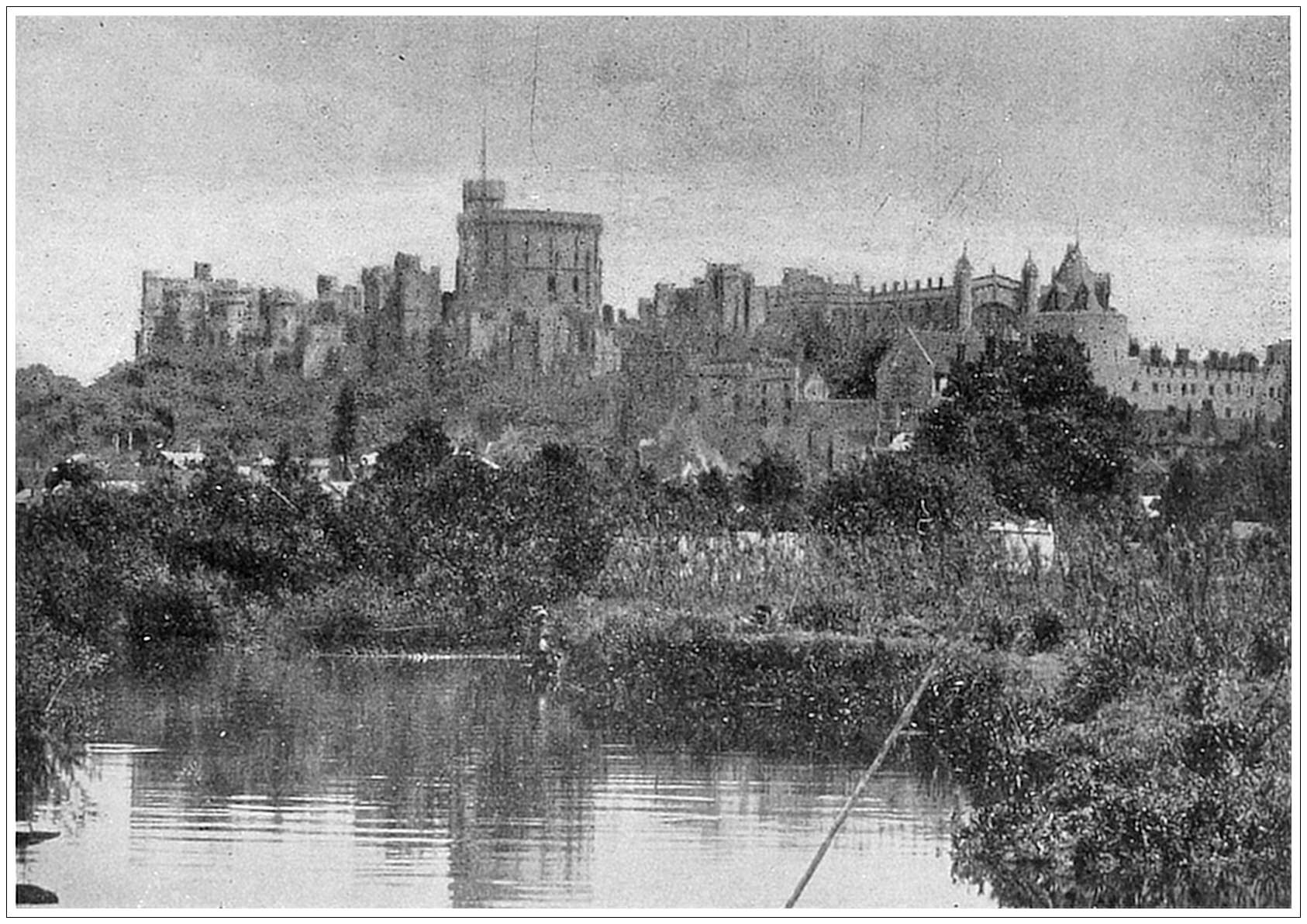
38
SHAKESPEARE’S HOUSE, STRATFORD-ON-AVON, ENGLAND. The birth-place of genius must always be full of interest to his fellow-men. How great then must be the interest in the birth-place of the greatest of geniuses! That interest is attested by the fact that the walls of the small, mean-looking edifice in which Shakespeare was born are scrawled all over with the names of potentates, princes, statesmen, poets and other great and little men. These, indeed, form a not insignificant part of the curiosities of the place. The house became the property of the English nation in 1847, and has been carefully restored. The actual room which witnessed the birth of the poet is shown, and is in substantially the same condition as when that event took place. In another room there is a small museum of Shakespearean relics.

40
OSBORNE HOUSE, ISLE OF WIGHT, ENGLAND. This is the seaside residence of Queen Victoria. Even in the Isle of Wight, a place famous for its magnificent private residences, it occupies a pre-eminent position. Situated in the immediate neighborhood of East Cowes, almost opposite to the mouth of Southampton Water, no place could be more favored by nature in its surroundings, and art has come to the assistance of nature. The grounds, though not large, are exquisite specimens of that princely art of landscape gardening in which the English have achieved the highest success. The palace itself is in excellent taste. A high tower in one corner is a conspicuous object for miles around. From its summit a magnificent view of the surrounding country may be obtained.

42
BLARNEY CASTLE, IRELAND. This imposing ruin of an ancient fortress is situated in the village of Blarney, about four miles from Cork. It was built in the early part of the fifteenth century by Cormac McCarthy, Prince of Desmond. Little now remains of it but the massive donjon tower, one hundred and twenty feet high. Its main celebrity arises from the famous Blarney stone, which endows whoever kisses it with the gift of flattery, palavering rhodomontade or wheedling eloquence. No one exactly knows the origin of the stone, nor whence it derived its mysterious powers. The date 1703 is carved upon it. It is preserved and held in place by two iron girders between huge mertons of the northern projecting parapet nearly one hundred feet above the ground. To kiss it has been the ambition of many generations who laboriously climb up to its dangerous eminence. But the lip service of so great a multitude is gradually wearing it away.

44
LAKES OF KILLARNEY, IRELAND. These are three connected lakes in County Kerry, of extraordinary beauty and interest. The largest, known as Lough Leane, is fifteen miles long by three broad. It contains some thirty islands, the chief of which is Innisfallen, celebrated in history and story. On the sides of these lakes rise the loftiest mountains in Ireland, intersected by the wildest ravines, and full of the boldest cascades. The beauty of the scenery is enhanced by the varied coloring of the thickly-wooded shores, the gray rock forming an effective contrast to the dark firs, the brown mountain heath, the light green arbutus and other features in an infinite variety of foliage and verdure. In the immediate neighborhood of Lough Leane is Muckross Abbey, founded by Franciscan monks in 1340, now a most picturesque ruin.

46
GIANT’S CAUSEWAY, IRELAND. A singular mass of basaltic columns, situated on the coast of Antrim, Ireland, has obtained this name from the legend that it was the commencement of a road planned by the giants of old to project across the channel from Ireland to Scotland. And, indeed, it looks almost like a deliberate work of mightier men than we rather than a frolic of nature. It resembles an immense pier jutting out into the sea from the base of a stratified cliff about four hundred feet high, to the length of about seven hundred feet. The pillars composing it are close-fitting, dark-colored and somewhat irregular hexagons, varying in diameter from fifteen to twenty inches and sometimes reaching the height of twenty or even thirty feet. Whinstone dikes separate it into three divisions, known as the Little Causeway, the Middle or “Honeycomb” Causeway and the Larger or Grand Causeway. Altogether, it comprises about forty thousand columns, each consisting of several pieces.

48
EDINBURGH CASTLE, EDINBURGH, SCOTLAND. Picturesquely situated on a rocky eminence, three hundred and eighty-three feet high, in the very heart of the old portion of Edinburgh, is this ancient fortress. The rock is perpendicular on three sides. On the fourth it slopes away gradually so that it can be ascended with ease. The fort is supposed to have been erected in the seventh century, the city gradually growing up around it. In early Scottish history it was frequently captured by and recaptured from the English. In the twelfth century it became a royal residence. By the articles of union it is one of the four fortresses which are to be kept constantly fortified. It contains accommodations for two thousand soldiers, and its armory affords space for thirty thousand stands of arms. The Scottish Regalia are preserved here, and one of the chief objects of interest is the room where Mary, Queen of Scots, gave birth to James VI, in whom the crowns of England and Scotland were united. The picture is taken from the Parade Ground.
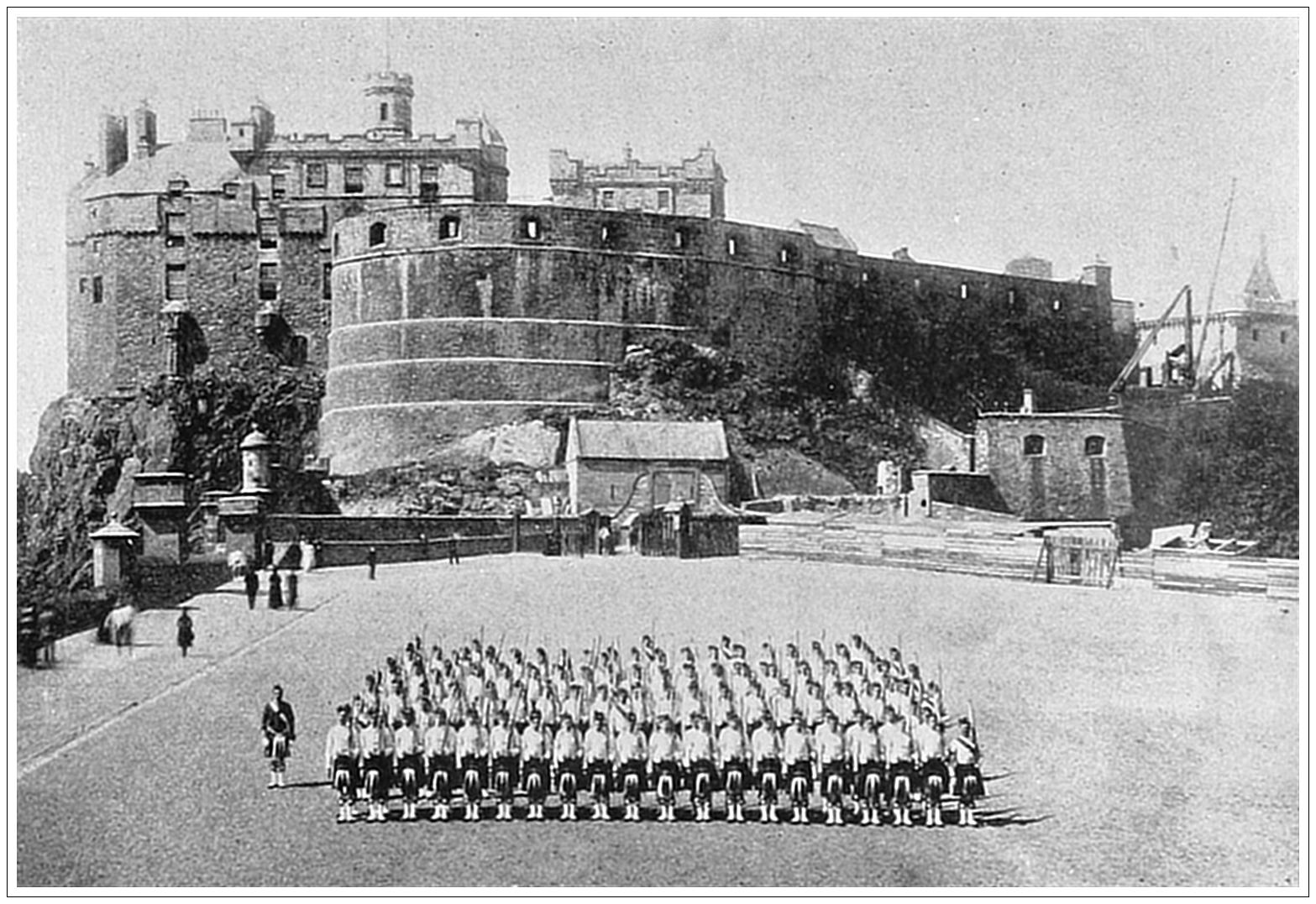
50
HOLYROOD PALACE, EDINBURGH, SCOTLAND. This spacious building occupies the site of an Abbey, founded in A. D. 1128 by King David I, of Scotland. The palace itself was begun in the reign of James IV, was nearly destroyed by Cromwell in 1650, and was rebuilt by Charles II. But the chief interest of the place centres upon its associations with Mary, Queen of Scots. Luckily her apartments are preserved in almost their original condition. The royal chapel, where she celebrated mass to the indignation of the Protestants, is almost intact. So is the audience chamber in which she disputed with John Knox. And even to this day is pointed out a deep stain at the foot of the private stairway to her apartments which is said to be the blood of the murdered Rizzio. In recent times the palace has been seldom used as a place of residence. It stands on the top of a huge rock four hundred and forty-three feet above the sea, and is built in the shape of a quadrangle with a court in the centre.
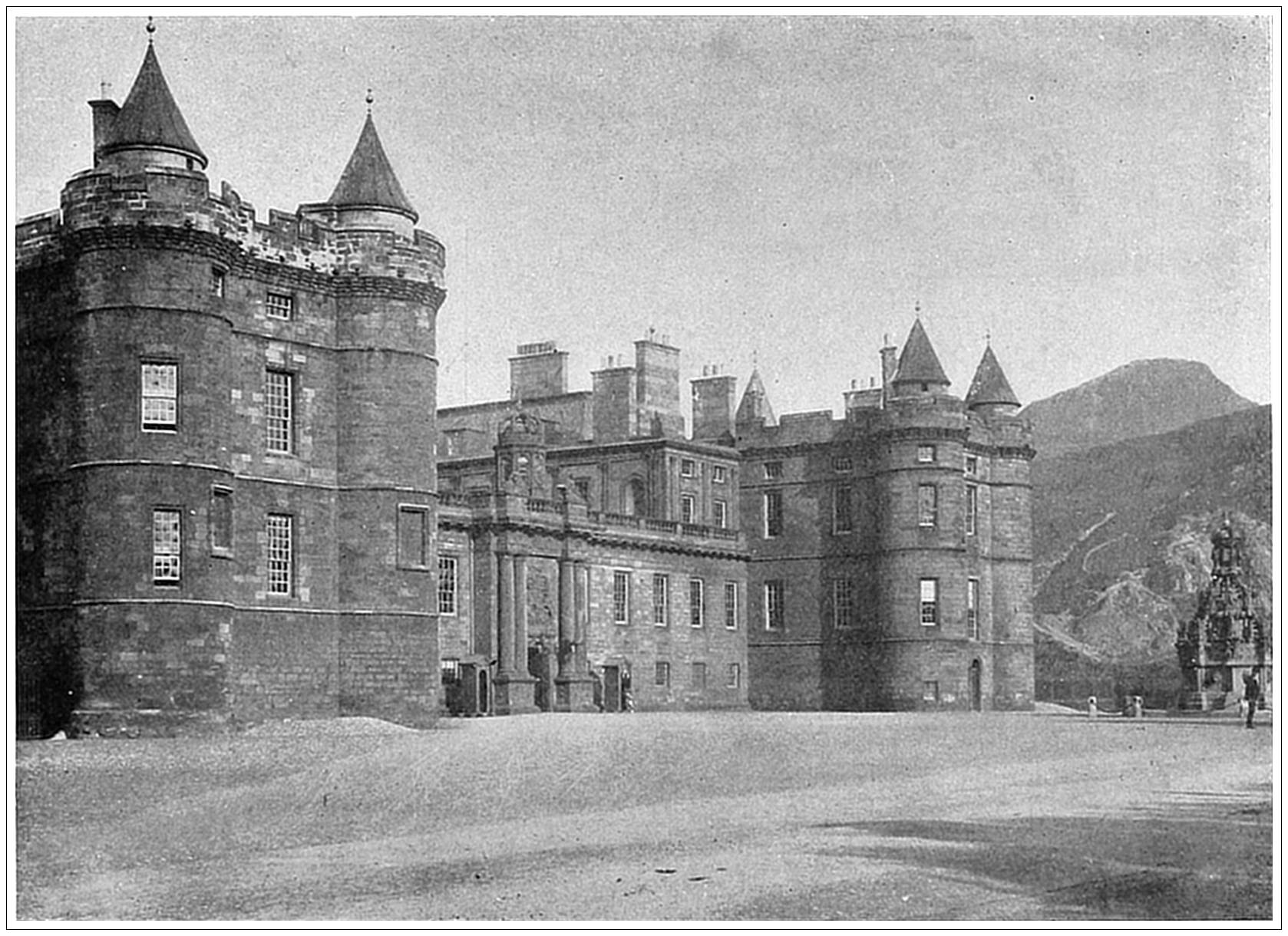
52
MELROSE ABBEY, MELROSE, SCOTLAND. This is the most famous and the most picturesque ruin in Scotland—indeed in all Great Britain. Originally founded for the Cistercian monks by David I, of Scotland, in the twelfth century, it was nearly destroyed by the English—Edward II—in 1322, and shortly after was rebuilt by Robert Bruce, whose heart is fabled to be buried under the east window. The abbey was again burned by Richard II in 1385, and though again restored it was considerably altered after the Reformation to suit the demands of Presbyterian worship. Later it was plundered by builders to secure ornaments for houses, and is now in utter ruin. As it stands, therefore, it belongs mainly to the middle of the fourteenth century and the first half of the fifteenth, with a good many portions of much later date. Even in ruins it is one of the noblest exemplars of the Middle-pointed style of Gothic architecture. Sir Walter Scott made it the scene of his novel of “The Monastery,” and also celebrated it in some well-known lines in “Marmion.”
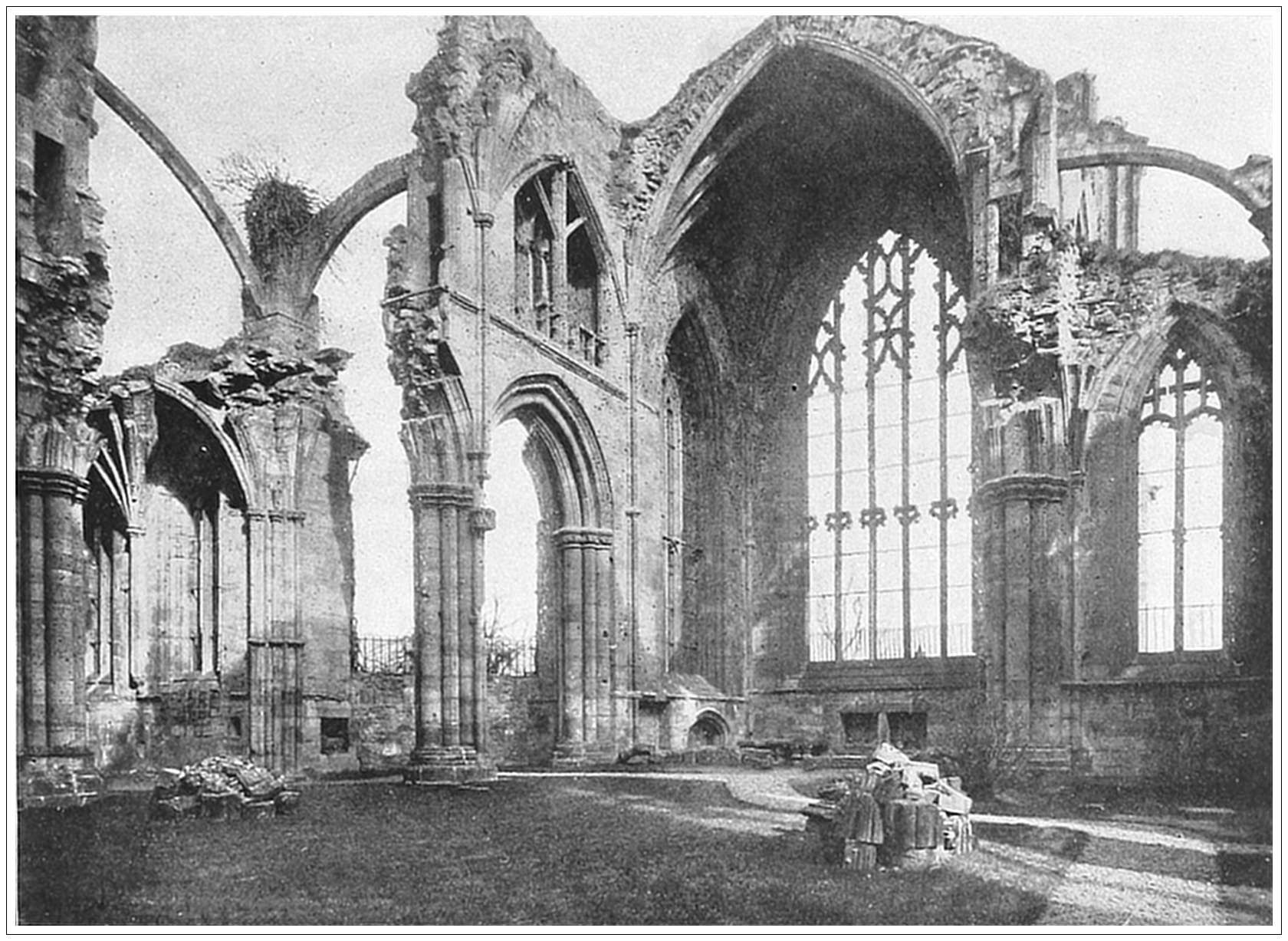
54
ABBOTSFORD, SCOTLAND. As the residence of Sir Walter Scott, who erected it in the days of his greatest financial success, and as the scene and the cause of his eventual ruin, the castle of Abbotsford must ever retain a picturesque and pathetic hold upon the lover of literature. It is situated on the south bank of the Tweed, near Melrose Abbey, and about twenty-eight miles southeast of Edinburgh. Scott’s aim was to erect a great mansion on something like feudal principles, where he would dispense a lordly hospitality akin to that of the ancient nobles whom he loved to celebrate. The scheme was too grand to succeed. The kindly baronet was involved in ruin, and spent his last days in a courageous and almost successful effort to battle against terrible odds. At present Abbotsford has passed out of the hands of his descendants and become a boarding-school for young ladies. But it is still a museum of interesting relics, and on account of its associations is much visited by tourists.

56
FINGAL’S CAVE, SCOTLAND, one of the most remarkable of all cave formations. It is situated on the Island of Staffa, seven miles off the west coast of Mull. The entire island is almost entirely encircled by cliffs of columnar basalt, hollowed out here and there into caves. Fingal’s, known also as the Great Cave, is the greatest of these. The entrance is almost like that of a huge Gothic Cathedral. A lofty arch, sixty feet high by thirty wide, is supported by columnar ranges of basaltic rock, whose native blackness is whitened with calcareous stalagmite. The cave is two hundred and thirty-two feet deep. Its floor is the sea, which flashes many colored lights upon the ceiling with its pendant clusters of columns, and on the great cavernous sides, with their countless complicated ranges of gigantic columns, beautifully jointed and of the most symmetrical though varied forms.

58
FORTH BRIDGE, SCOTLAND. The largest and, in many respects, the most magnificent bridge in the world, is that across the Firth of Forth, at Queensbury. Here the estuary of the Forth is divided by the island of Inchgarvie into two channels, whose depth—two hundred feet—precluded the construction of intermediate piers. A design for a gigantic suspension bridge, by Sir Thomas Bouch, had almost been adopted, when the collapse of the Tay bridge, in 1879, led to the abandonment of the project. A new plan was accepted from Benjamin Baker. This was a cantilever bridge of steel. A cantilever is a structure overhung from a fixed base. Work was begun in 1882 and completed in 1889. There are three granite piers, the central one being on the island; and on those piers three double lattice-work cantilevers are poised in line, reaching towards each other, and connected at their extremities by ordinary girders three hundred and fifty feet long, by which the two main spans are completed. These main spans are each seventeen hundred feet long, and the total length of the bridge is eighty-two hundred and ninety-six feet, or a little over one and one-half miles. The under side of the bridge is one hundred and fifty-two feet above high water.

60
BALMORAL CASTLE, SCOTLAND, the Highland residence of the Queen of England, situated in Braemer, Aberdeenshire. Its situation is of great beauty. It stands on a natural platform nine hundred and twenty-six feet above sea level, which slopes gently and gradually down to the margin of the River Dee. The castle is in the Scottish Baronial style of architecture. It is entirely of granite, and consists of two separate blocks of buildings united by wings. A tower eighty feet high is surmounted by a turret twenty feet higher. The entire estate, including a deer forest, comprises over twenty-five thousand acres. It was purchased by Prince Albert in 1832 from the Earl of Fife. He pulled down the older castle, finding it not exactly suited to the needs of the royal family, and put up the present imposing structure in its place.
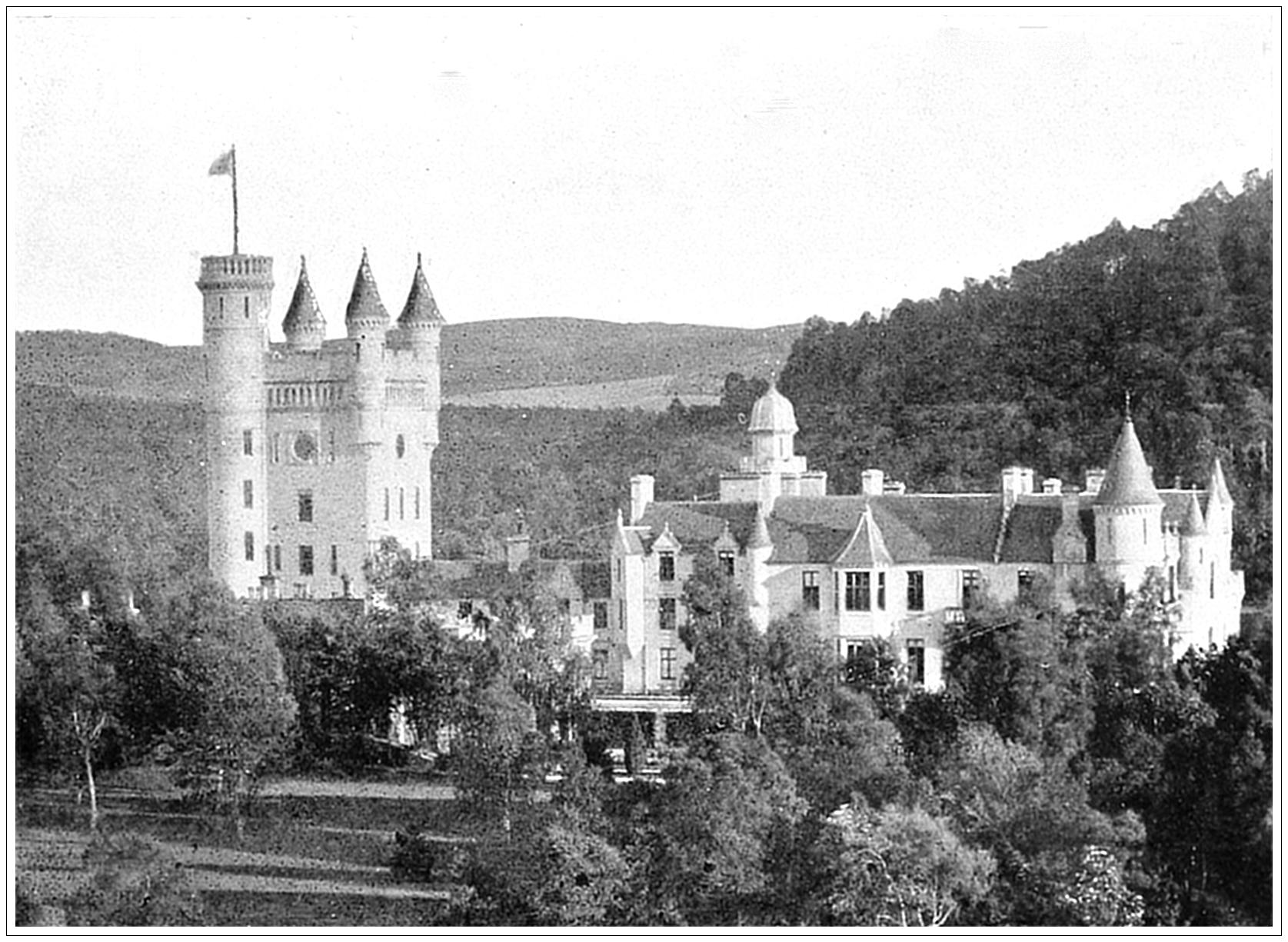
62
LOCH KATRINE (ELLEN’S ISLE), SCOTLAND. The Scotch lakes are famous the world over for their beauty. Loch Katrine is the most famous of them all. It lies in Perthshire; is eight miles in length, and has an average breadth of three quarters of a mile. Ben Venue and Ben An are celebrated mountains on its banks, and it contains a number of exquisite islands. Among the latter is Ellen’s Island, chosen by Sir Walter Scott as the scene of “The Lady of the Lake.” Wordsworth and other poets have thrown the glamour of their genius around Loch Katrine. But it has a more practical use. Its waters, which are remarkably pure, supply the city of Glasgow, twenty-five miles off; being conveyed thither by a series of tunnels, aqueducts and pipes.
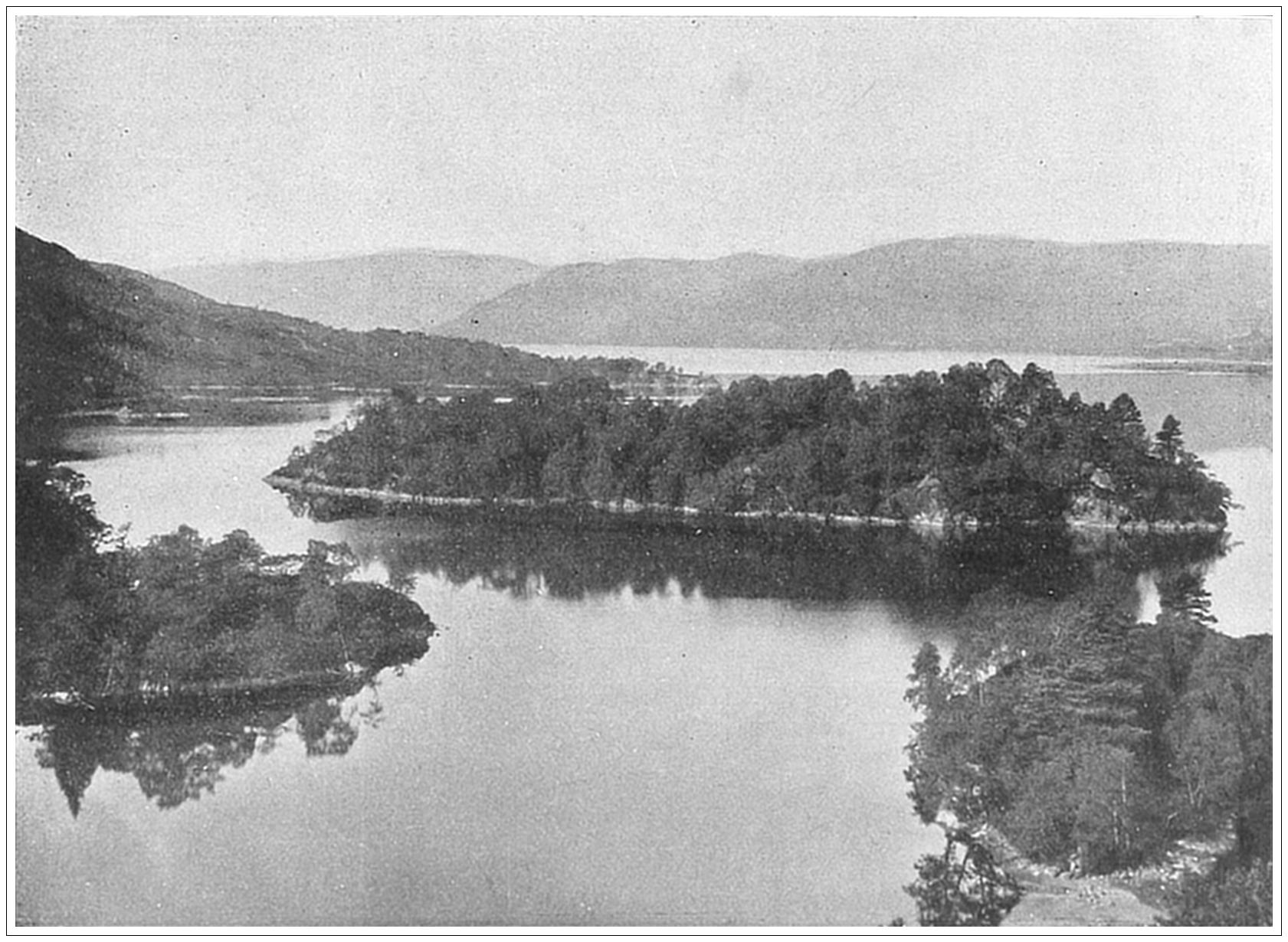
64
NORTH CAPE, NORWAY. A promontory, situated on the north extremity of the Island of Mageroe, which is divided by a narrow channel from the mainland of Norway. It is celebrated, not only for the sombre grandeur of its scenery, but as the northernmost point of Europe. It consists of a precipitous slate rock, fissured with many clefts, which rise to a height of some twelve hundred feet above the sea.

66
KREMLIN AND GREAT BELL, MOSCOW, RUSSIA. The Kremlin is the name given to an inner enclosure or citadel in Moscow crowded with palaces, churches and towers, surrounded by a wall sixty feet in height and two miles in circuit. The Tartar style of architecture, with gilded domes and cupolas, forms the predominant feature. The palace of the Kremlin is the residence of the czars. It suffered much damage in the conflagration of 1812, which drove Napoleon out of the city, and was rebuilt in the reign of Nicholas I in 1838–49. In its restored shape it is rather a mass of buildings, old and new, than a single, harmonious structure. But it is full of historical and immediate interest. The tower of Ivan the Great, whose five stories rise to a height of three hundred and twenty-five feet, is close to the palace. At its foot lies the Great Bell, the largest in the world—cast in 1730. It was broken a few years afterwards by the burning of the wooden tower in which it was suspended. Its height is twenty-six feet four inches, its circumference sixty-seven feet eleven inches.

68
CHURCH OF ST. BASIL, MOSCOW, RUSSIA. This remarkable edifice, standing on the site of an ancient church and cemetery where St. Basil was buried, was built in 1554 by Ivan IV. He is said to have been so much delighted with it that he put out the eyes of its Italian architect, so that it might never be surpassed. It is a bewildering medley of great and little domes and towers, not only of different shapes and sizes, but gilded and painted in all possible varieties of color. There is no main chapel or church, but each dome surmounts its own chapel, dedicated to some particular saint, and services are carried on in each without disturbing the worshipers in any other. Bayard Taylor appropriately styles this church the “apotheosis of chimneys,” and describes it as the product of some architectural kaleidoscope, in which the most incongruous things assume a certain order and system. Relics of St. Basil and of St. John the Idiot are shown to visitors.

70
ROYAL MUSEUM, BERLIN, PRUSSIA. Architecturally, this is the finest building in Berlin. It is an admirable specimen of the Greek style, with its Ionic portico of eighteen columns and its broad flight of steps leading up to the entrance. The central part of the structure, rising above the rest of the building and corresponding with the rotunda in the interior, is adorned at the corners with four colossal groups in bronze. Two other bronze groups are on the steps. This building is usually known as the Old Museum to distinguish it from its annex, the New Museum, by which it is connected with a short passage, crossing the street at the back. The two buildings contain a magnificent collection of antiquities and of ancient and modern sculptures, paintings, etc.
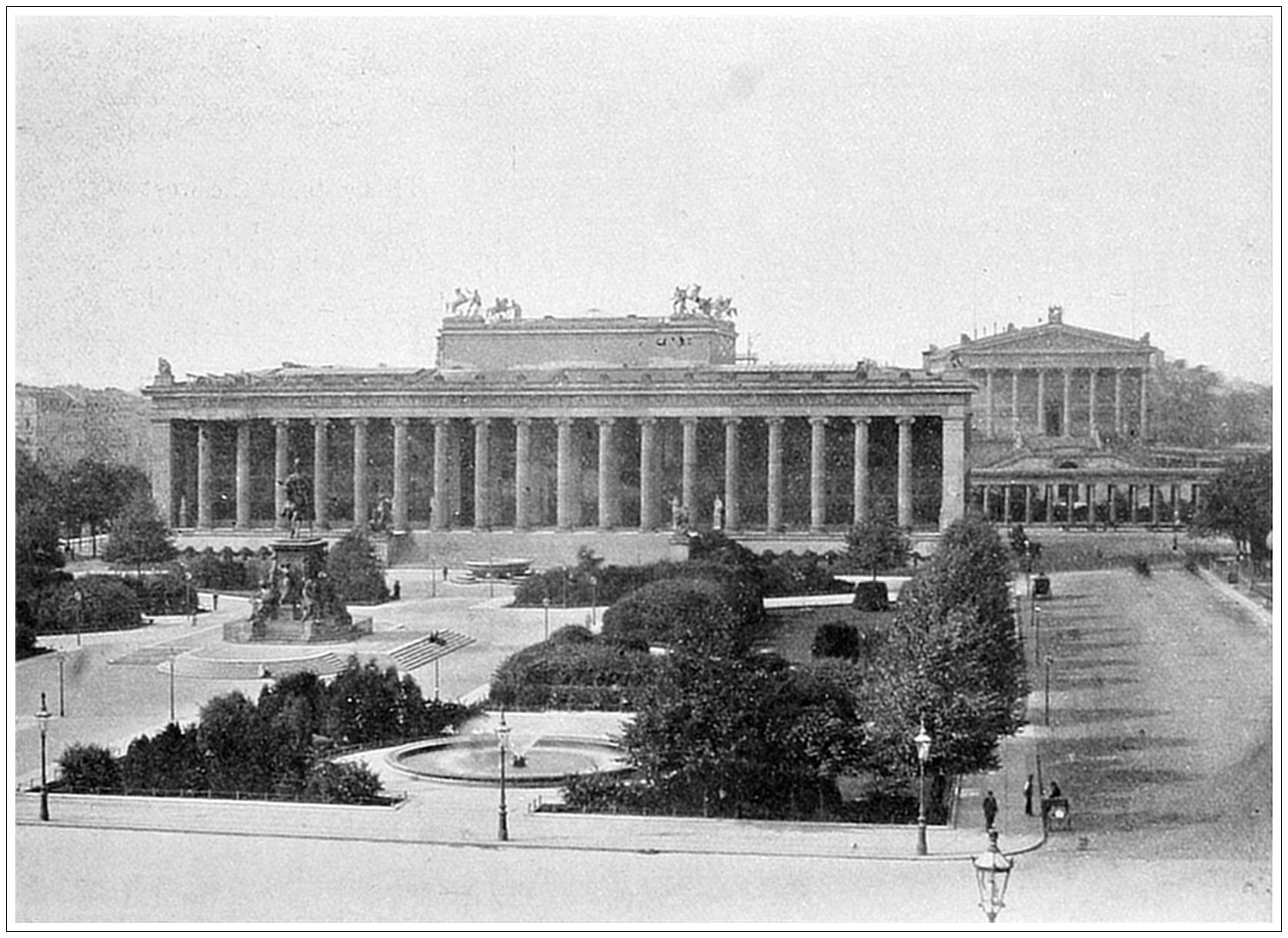
72
BRANDENBURG GATE, BERLIN, PRUSSIA. This gate, at the west end of the famous Unter der Linden, the principal street in Berlin, forms the entrance to the city from the Thier-garten. Next to the Arc de l’Etoile in Paris, this is the most magnificent triumphal arch in the world. It even eclipses the ancient monuments of this kind in Rome. Yet it is not entirely original. It was erected in 1789–93 by C. G. Langhans in imitation, or rather as a glorification, of the model presented by the Propylacum at Athens. The height is eighty-five feet, the width two hundred and five. There are five passages (that in the centre reserved for royal carriages), separated by massive Doric columns. The material is sandstone. A notable feature is the triumphal car on the summit, the Quadriga of Victoria, done in copper. Napoleon carried this to Paris in 1807, but it was recovered in 1814. Adjoining the gate on the side next the town are two wings resembling Grecian temples, of which that on the right or north side contains a telegraph office and a pneumatic post-office, while that on the left is the guard-house.
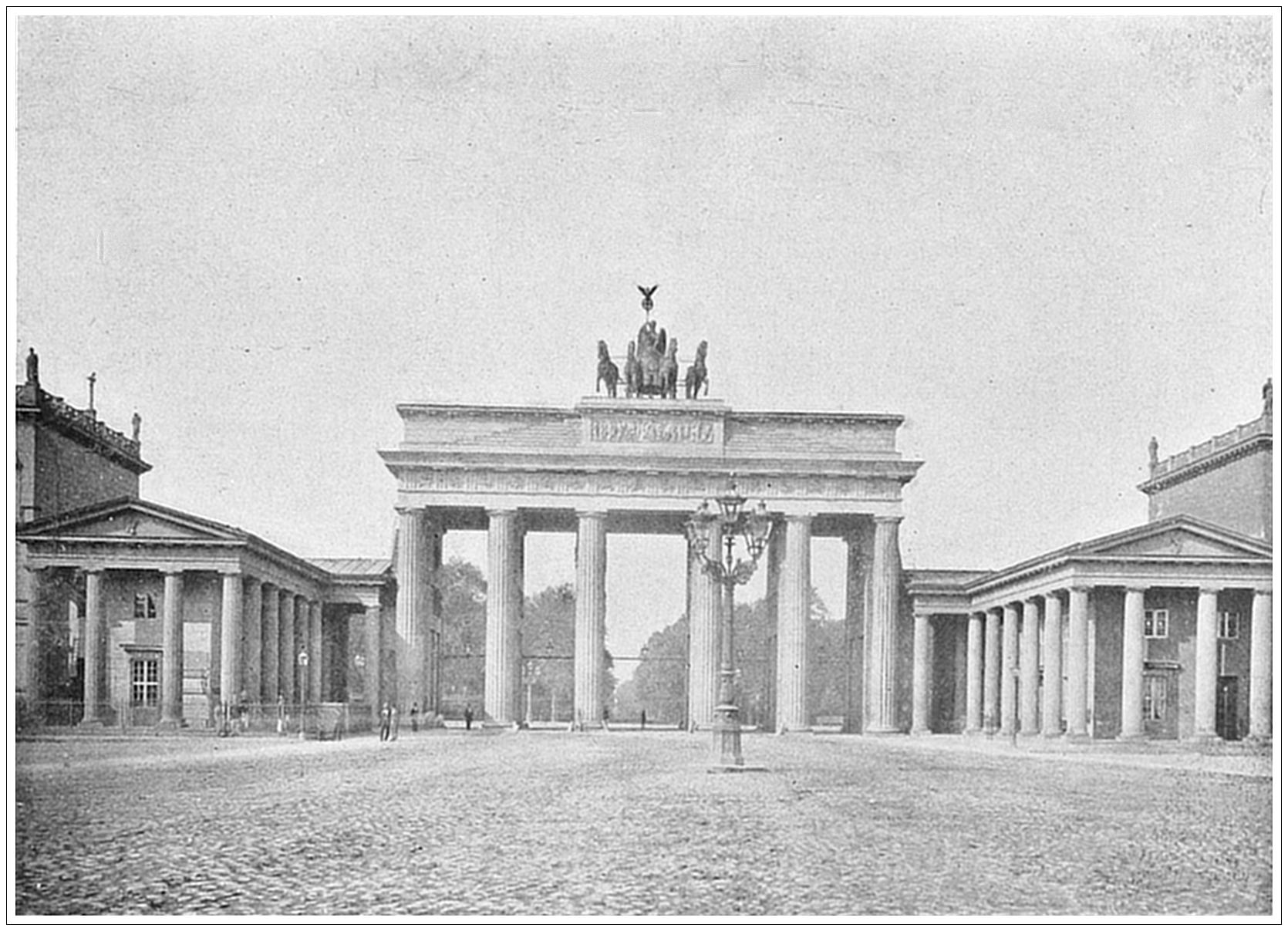
74
THE CATHEDRAL OF COLOGNE, GERMANY. This church, known officially as the Cathedral of St. Peter’s, is, next to St. Peter’s at Rome, the largest church edifice in the world, and is, without any exception, the most magnificent specimen of Gothic architecture extant. Begun in 1248, the work went on very slowly. In 1322 the choir was consecrated. Then the work lagged still more, and at the beginning of the sixteenth century came to a sudden close, not being resumed till 1816, since which time more than two millions of dollars have been expended to bring the edifice to its present state of completion. The spires are five hundred and twenty-one feet high, and before the building of the Eiffel Tower this church was the highest edifice in the world. The height of the roof inside is one hundred and forty-five feet, the length of the building is four hundred and forty-four feet and the breadth two hundred and one. The choir is rich in statues, frescoes and fine carvings. A chapel, known as the chapel of the Three Kings, contains a gorgeous shrine, in which are exhibited the skulls of the three wise men who came from the East with presents for the infant Saviour.
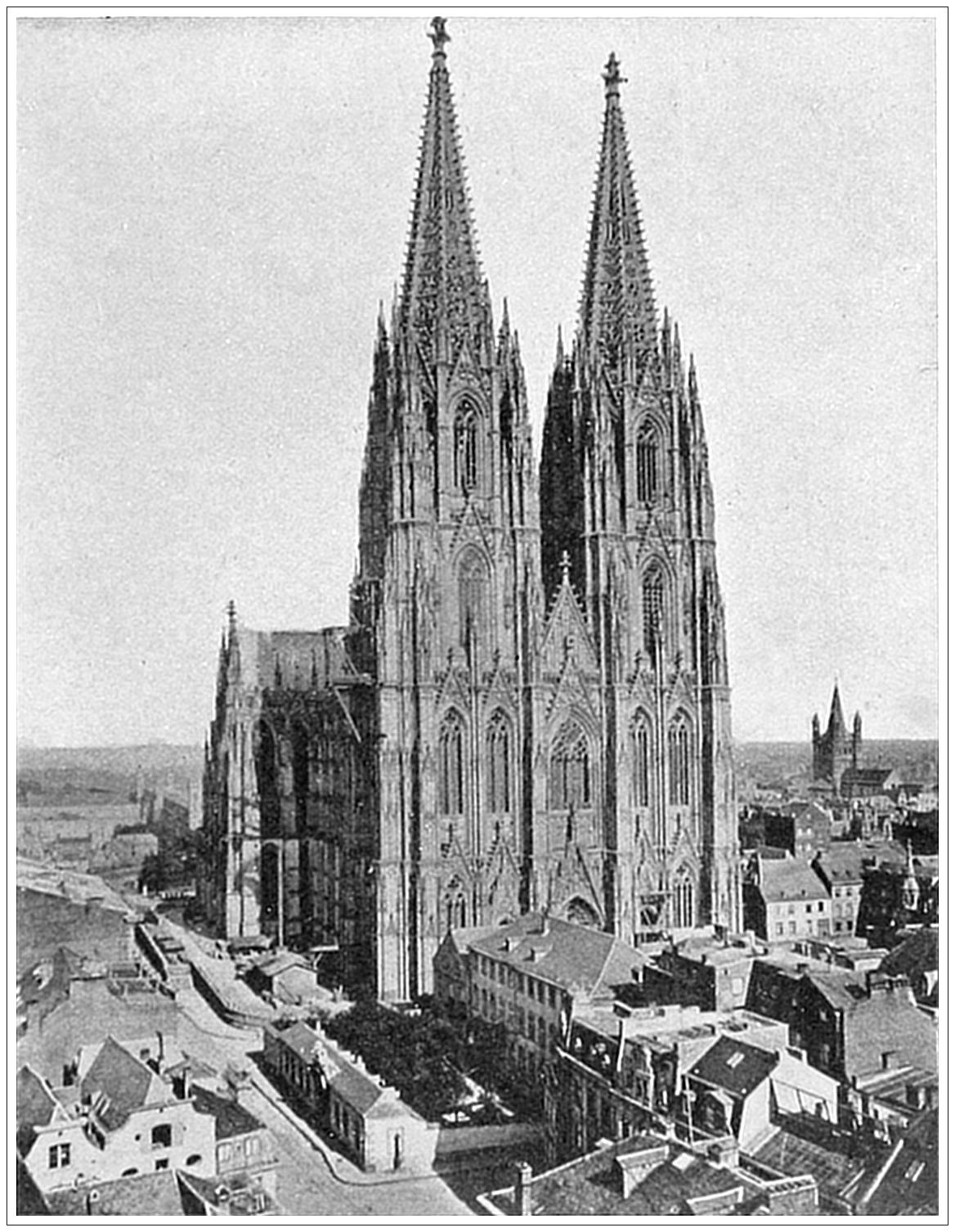
76
HEIDELBERG CASTLE, GERMANY. On a height above the city of Heidelberg are the ruins of this old-time palace and fortress. Founded by the Elector Rudolph in the fourteenth century, and altered and added to by his successors, it partakes of the architectural style of all the three centuries. The French sacked and partially burned it in 1693; it was subsequently restored, but being struck by lightning in 1764, it has since been suffered to remain in ruins. As such it is one of the most magnificent remains of the Middle Ages—a square massive building, roofless, with a round tower at one end and an octagonal one at the other. Some idea of its strength may be gained from the fact that the walls of the round tower are twenty-two feet thick. In one of the cellars is the famous Tun of Heidelberg, a huge copper reservoir, bound with iron hoops, whose capacity is forty-nine thousand gallons.

78
EHRENBREITSTEIN, GERMANY. This fortress, whose name signifies the Broad Stone of Honor, is situated on a precipitous rock three hundred and seventy-seven feet above the Rhine, just opposite Coblentz. The rock is known as the Gibraltar of the Rhine. The ancient Romans recognized its commanding position and erected here a castrum or camp. In 1018 the Franconian king, Dagobert, presented it to the bishops of Treves, who made it their stronghold. It has successfully resisted many sieges, but was twice captured by the French, first in 1631 and again in 1798. After the Peace of Luneville in 1801 they blew it up. Restored to Prussia with the Peace of Paris, the French were forced to contribute 15,000,000 of francs to place it in its former condition. At present it is defended by four hundred cannon, and fifty thousand stands of needle guns are stored in its armory. It is capable of accommodating one hundred thousand men, but five thousand are sufficient to man it properly. The summit of the rock commands a magnificent view of the surrounding country. A bridge of boats connects the village of Ehrenbreitstein with Coblentz.
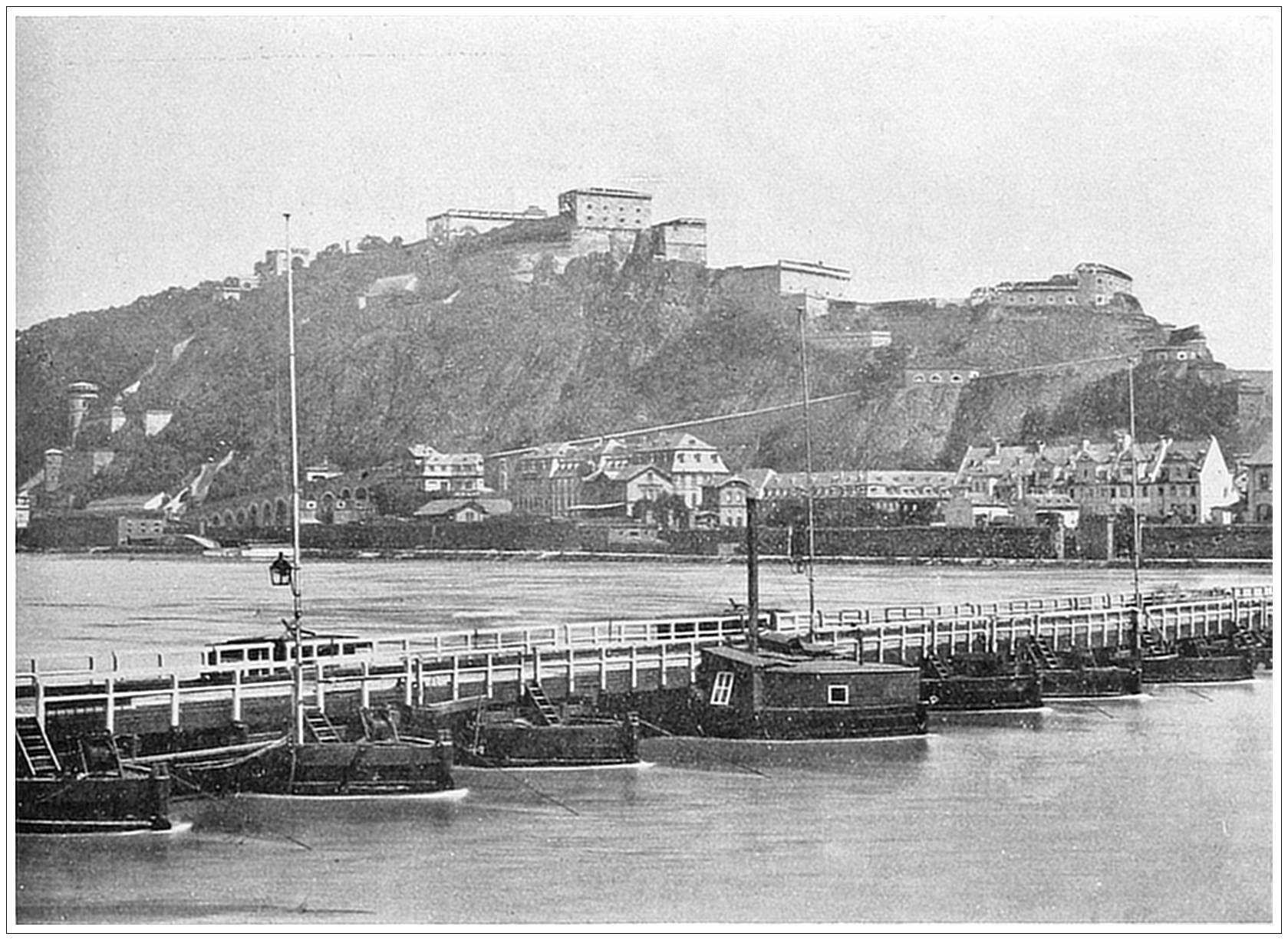
80
THE CATHEDRAL OF ANTWERP, BELGIUM. Though inferior to the great minster at Cologne, the cathedral at Antwerp is an exquisite and notable specimen of Gothic architecture. It is unfortunately situated in a narrow street, just away from the Place St. Antoine, and is hedged in by shops, which are backed up against its very walls. It is unfinished, only one of the towers being complete. The other is but half-way up, where it has been capped over, and has remained so for centuries. Nevertheless, nothing can detract from the majesty of the church itself. Out from the littleness of its surroundings it calmly rears its splendid front. Its solitary tower soars upward to the height of four hundred and three feet, with delicate open arches that look like fretted work, so that Napoleon said: “It looked as if made of Mechlin lace.” The chimes of ninety-nine bells are deservedly famous. The interior is glorified by the presence of Rubens’ two greatest pictures, “The Elevation of the Cross” and “The Descent from the Cross.” Begun about the middle of the thirteenth century, it suffered seriously from fire in the sixteenth century, and the greater part of the present edifice dates from that period. In the foreground of the picture is the monument to Rubens.

82
PALAIS DE JUSTICE, BRUSSELS, BELGIUM. The new Palace of Justice, or Court-house, in Brussels, is the largest architectural work of the present century, and one of the most magnificent. It was begun in 1866 and completed in 1883 at a total cost of $10,000,000. It is splendidly situated on a height commanding a view of the whole city. This massive pile covers an area of two hundred and seventy thousand square feet, considerably more than St. Peter’s, at Rome, and is five hundred and ninety feet long by five hundred and sixty wide. The avowed aim of the artist was to accommodate Assyrian form to modern requirements. Above the main body of the building rises another rectangular structure, surrounded with columns, this, in turn, supporting a columned rotunda, the whole crowned by a dome which is four hundred feet above the pavement. In details the Græco-Roman style has been generally adhered to, with an admixture of rococo treatment.

84
FIELD OF WATERLOO, BELGIUM. The scene of the greatest battle of modern times, if not of all times, is necessarily of perennial interest to the world. It is a matter for rejoicing, therefore, that the field of Waterloo is retained in much the same condition in which it was left on the fateful day of June 18th, 1815, when the power of Napoleon was crushed by Wellington and Blucher. To be sure, Wellington is reported to have said: “You have spoilt my battlefield,” when he saw the artificial mound surmounted by a Belgic lion of cast-iron, which has been raised in the centre of the field. But at least its one hundred and fifty feet of height afford the opportunity for an excellent bird’s-eye view of the entire field. And the old house of Hougemont, whose building and orchard were occupied by the British Guards, and where some of the fiercest fighting of the day was carried on, remains as it was, with the bullet holes in the walls and other damages unrepaired. The monument represented in the foreground is dedicated to the soldiers who fell in the battle.
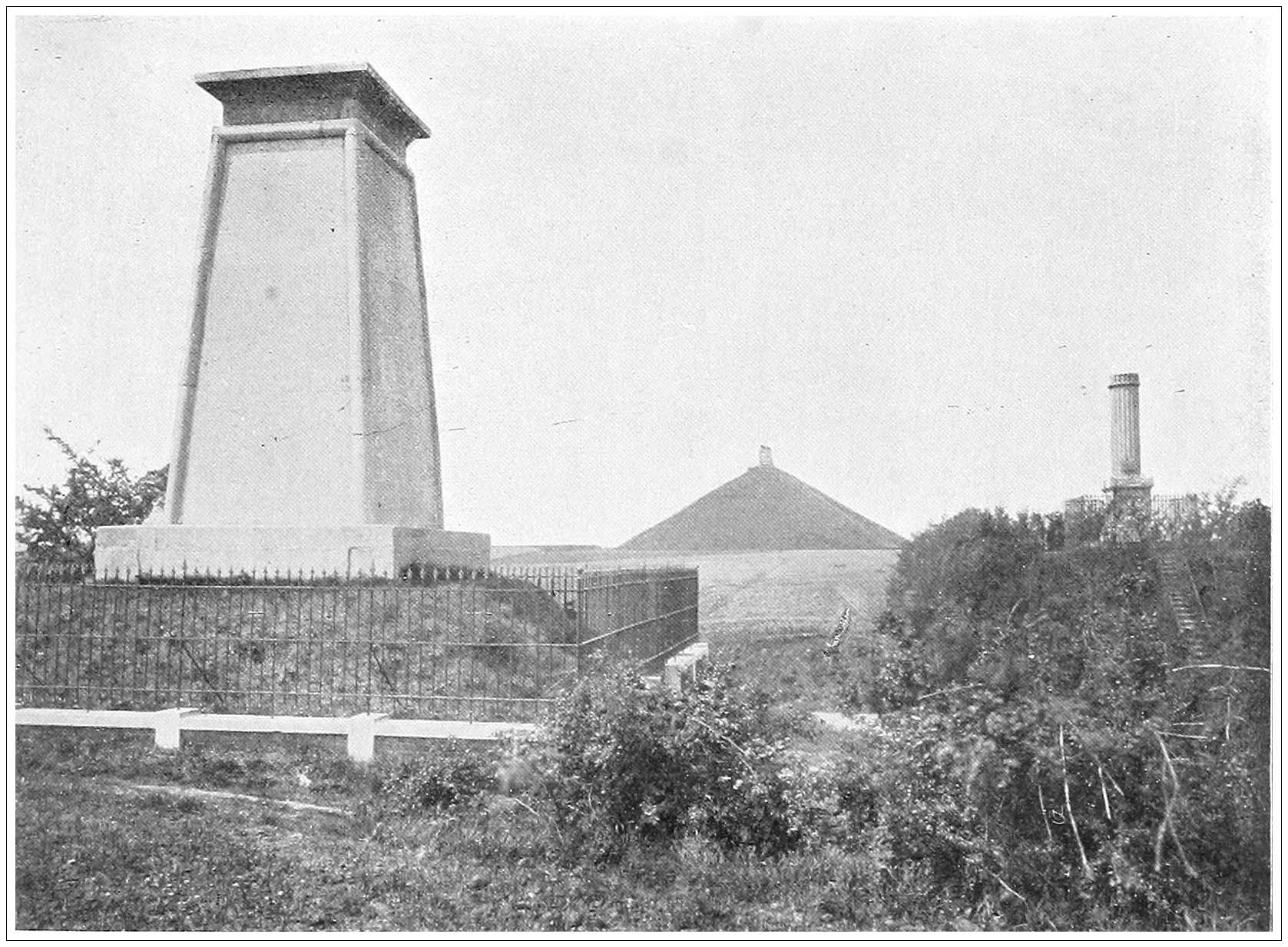
86
NOTRE DAME, PARIS. The cathedral of Notre Dame, one of the great historical churches of the world and one of the most beautiful specimens of mediæval architecture, was founded in 1163 on the site of an earlier church, was consecrated in 1182 and was completed in 1420. It suffered sadly during the Revolution, when it was made a Temple of Reason; was restored in 1845, and during the time of the commune narrowly escaped destruction by fire. The form is that of a Latin cross, with a nave and double aisles, which are continued around the choir, the earliest example known. The façade is one of the most admired pieces of early Gothic. The triple portal is ornamented by rich bas-reliefs. In the second story is a great rose window, flanked by double windows, enclosed in wide-spreading Gothic arches. The third story is an open gallery of slender arches and columns. In one of the towers is a famous bell, weighing thirty-two thousand pounds, which is only rung on state occasions. The interior of the church is adorned with sculptures, bas-reliefs and paintings and magnificent rose windows of stained glass.
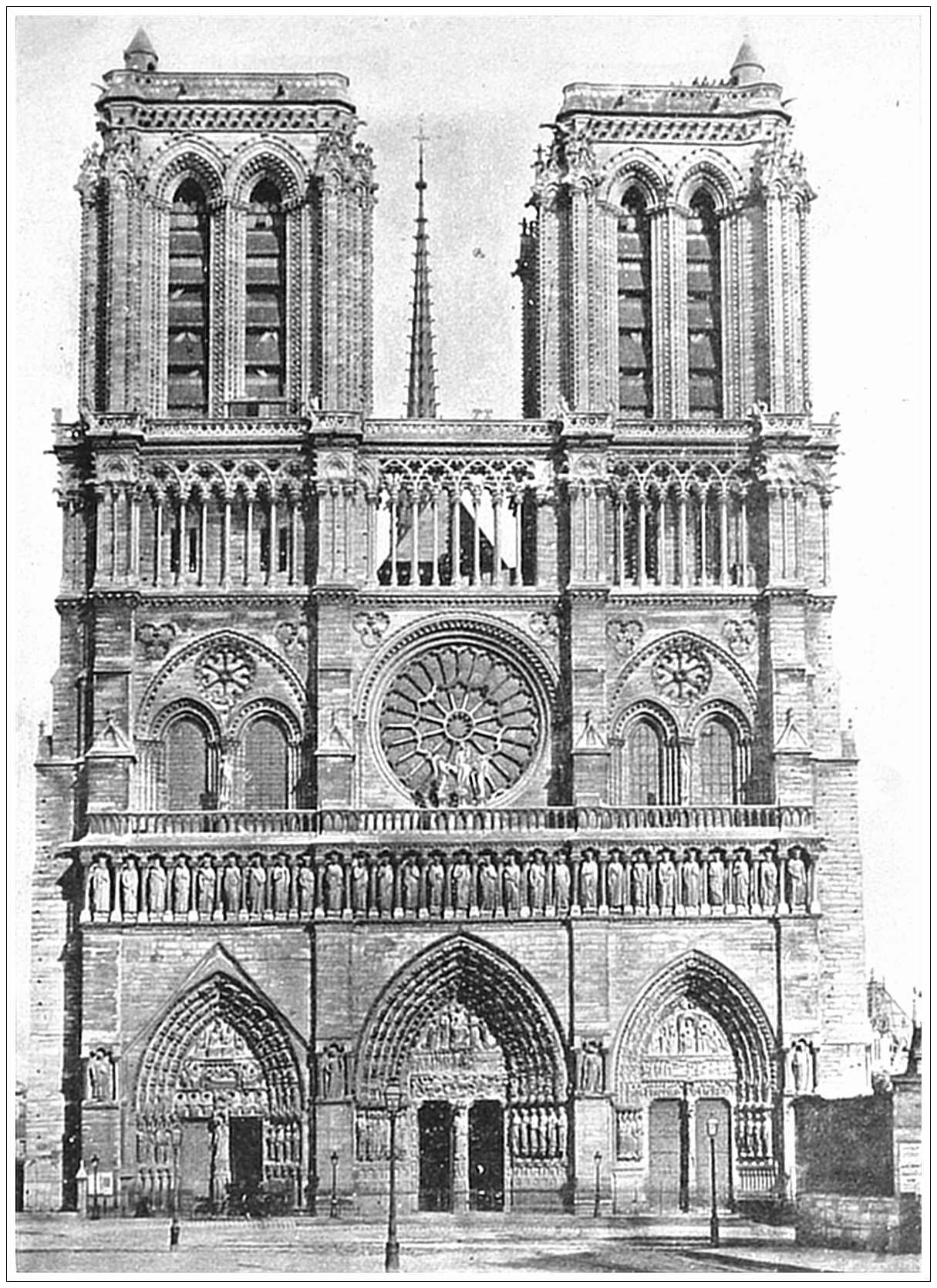
88
PLACE DE LA BASTILLE, PARIS, FRANCE. This square ends the line of the original boulevards, and marks the beginning of the Faubourg St. Antoine. It is historically interesting as the site of the Bastille, the former state prison of France, whose destruction by the Parisian mob on July 14th, 1789, marked the real beginning of the French Revolution. The column in the middle, known as the Colonne de Juillet, was reared in 1831 in honor of the citizens who fell in the revolution of July, 1830, which drove Charles X from the throne and put Louis Philippe in his place. The names of six hundred and fifteen of these are inscribed upon the sides of the column, and their ashes, together with those of combatants in the revolution of 1848, repose in two vast sarcophagi in the vaults below. The column is of bronze, one hundred and fifty-four feet high, and is divided by four collars into five divisions. Bas-reliefs, by Barye, adorn the exterior. Inside there is a spiral stair-case, also of bronze. The top is surmounted by an emblematic figure of Liberty, in gold bronze, the work of Dumont.
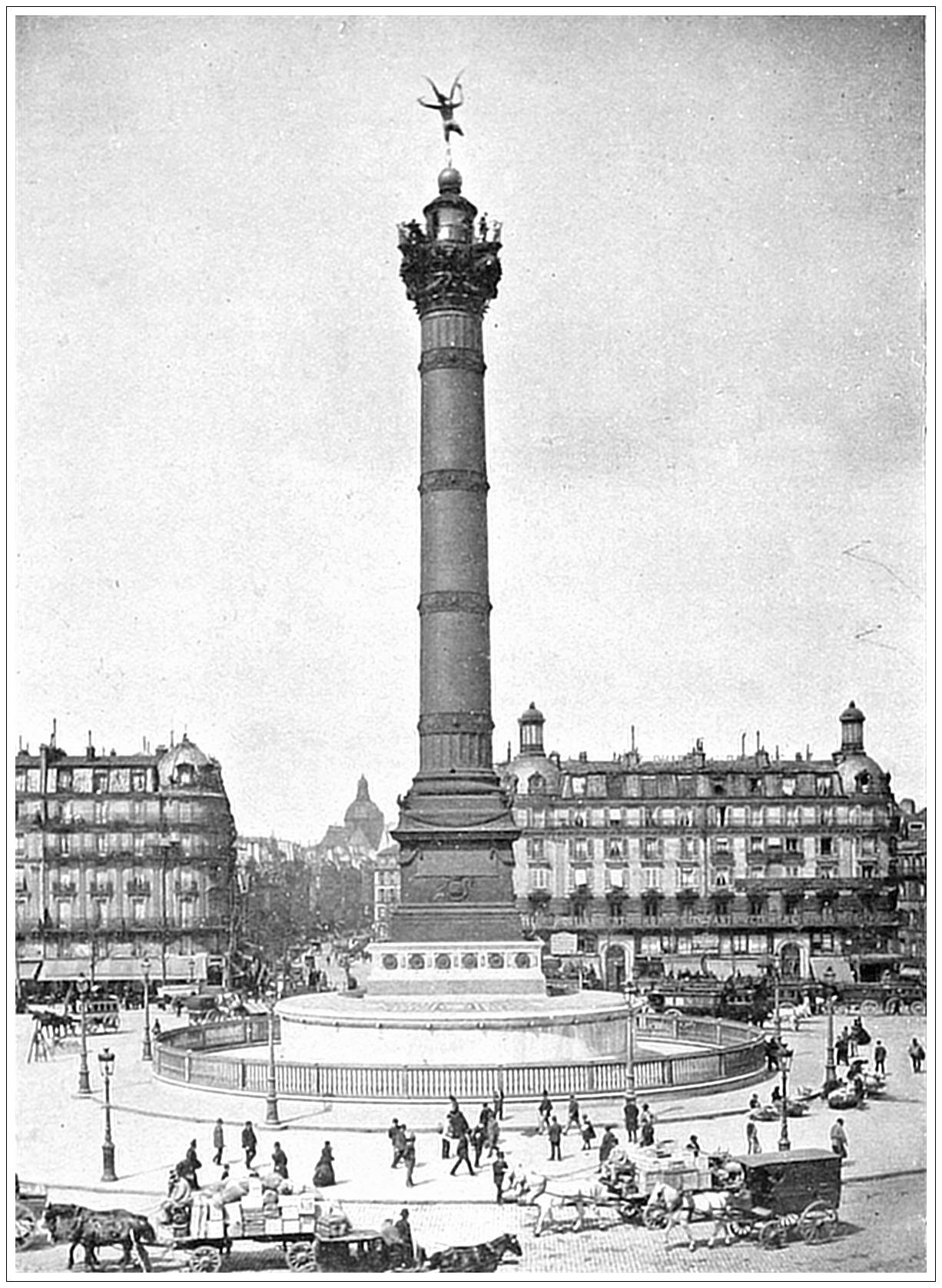
90
PLACE DE LA CONCORDE, PARIS, FRANCE. This square, situated between the Rue Royale and the Pont de la Concorde, is perhaps the most beautiful and effective in all Paris. It dates from the year 1748. Originally it was adorned with a statue of Louis XV, which was pulled down in 1792 to make way for a colossal figure of Liberty. The place was then called Place de la Revolution. It was here that next year the guillotine was erected, upon which perished Louis XVI, Marie Antoinette and nearly three thousand of their adherents. Under the Directory the Statue of Liberty was removed and the great place became the Place de la Concorde. Since then it has undergone many alterations. It was laid out as it now stands by Napoleon III. In the middle is the great Obelisk of Luxor, presented to Louis Philippe by Mehemet Ali, and on each side are two large fountains. At the different corners of the square there are seated figures, representing eight different towns, formerly the chief towns of France. But one of them, Strasbourg, is now a portion of Germany.
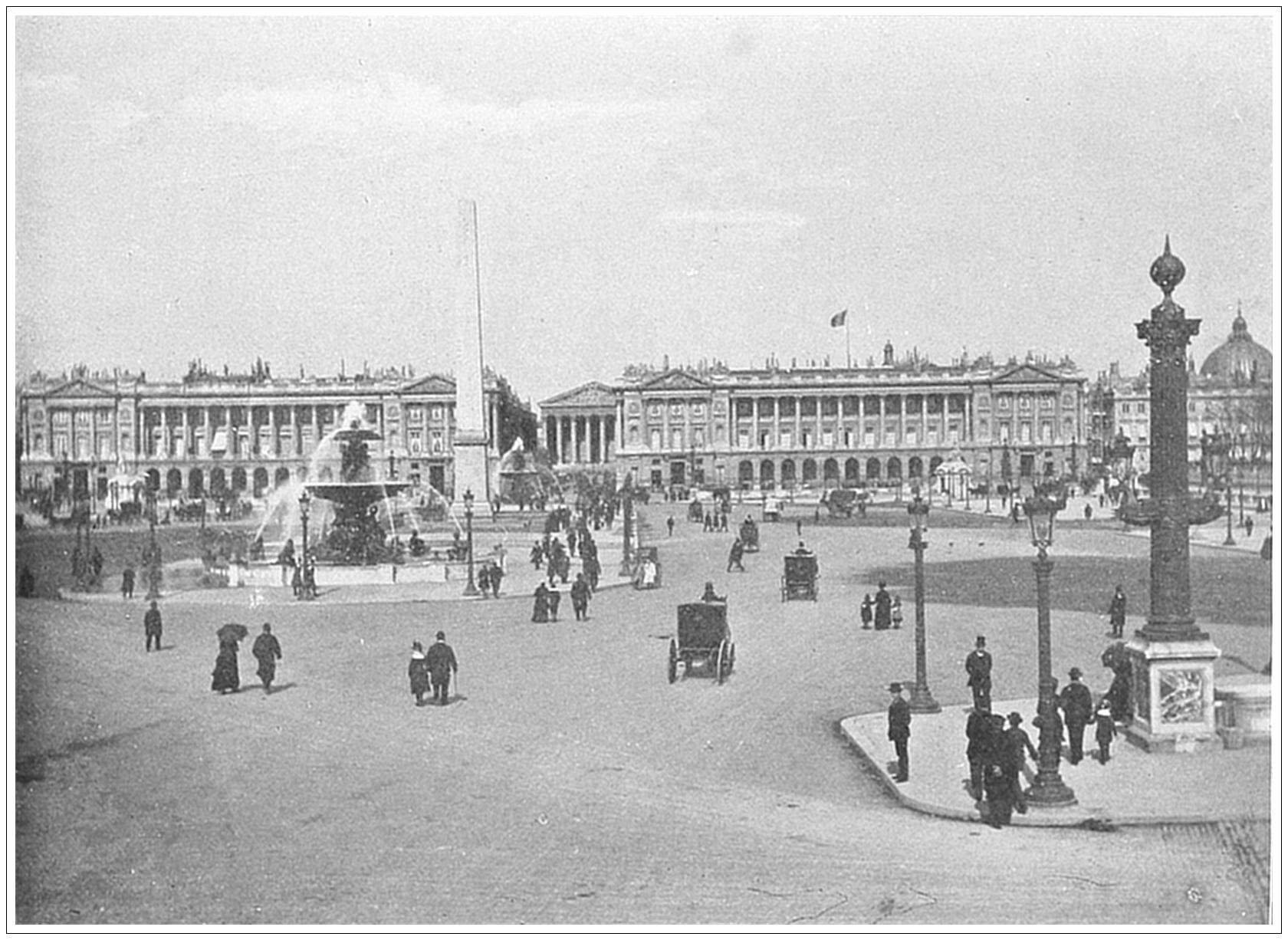
92
PLACE VENDOME, PARIS. A handsome octagonal square, between the Boulevard des Capucines and the Tuileries Gardens. It was designed by Louis XIV, in 1686, to contain public buildings, such as the Mint, the Royal Library, the various academies, &c. This plan was subsequently much modified. The buildings, which are of Corinthian architecture of a severely uniform appearance, are mainly occupied by banks and other fiscal institutions. A grand equestrian statue of Louis XIV once stood in the centre of the square, but it was destroyed in 1792, and in 1806 its place was taken by the famous Vendome column, a stone shaft one hundred and forty-three feet high, covered with the metal of cannon taken from the Prussians and Austrians. It is surmounted by a statue of Napoleon, and is ornamented by bas-reliefs commemorative of that hero’s campaign in 1805. In 1871 column and statue were both pulled down by the Commune, but the Republic under Thiers repaired and replaced them.

94
THE GARDEN OF THE TUILERIES. The Tuileries is but the remains of its former glory. The main front of the building was burned by the Commune in 1871, and after remaining a picturesque ruin for some years was at length removed. The wing nearest the Rue de Rivoli shared the fate of the front, but was rebuilt, together with the Pavillon de Marsan, which formed the angle. The Pavillon de Flore, at the other end, suffered much less, and had only to be restored. Both wings, and, indeed, the entire building, are a marvel of exterior ornamentation. Before the Revolution the Tuileries was only the occasional residence of the French sovereign, but Napoleon made it his principal abode, and his example was followed by his successors. The picture is taken from the exquisite gardens of the Tuileries facing the Place de la Concorde.

96
ARC DE TRIOMPHE, PARIS, FRANCE. This, the distinctive triumphal arch of Paris, is more specifically known as l’ Arc de l’ Étoile, to differentiate it from three other triumphal arches of less celebrity. It stands at the west end of the Avenue des Champs Elysées on the summit of a slope, which makes it visible from all parts of Paris and the environs. It is not only the largest arch in existence, but the most magnificent ever erected. Begun by Napoleon in 1806, to commemorate the wars of the Revolution and of the Empire, it was completed thirty years later by Louis Philippe. The total cost was about $2,000,000. The height of the arch above the ground is one hundred and fifty-two feet, its width one hundred and thirty-eight feet, its thickness sixty-eight feet. The main archway measures ninety feet in height and forty-five in width; the smaller lateral archways are each fifty-seven feet by twenty-five. The bas-reliefs represent the most famous events of 1792–1815. Finest of all are the two colossal groups on each side of the central arch facing the Champs Elysées, cut in full relief and representing the “Departure of the Troops in 1792” and “The Triumph of Napoleon after the Austrian Campaign.”
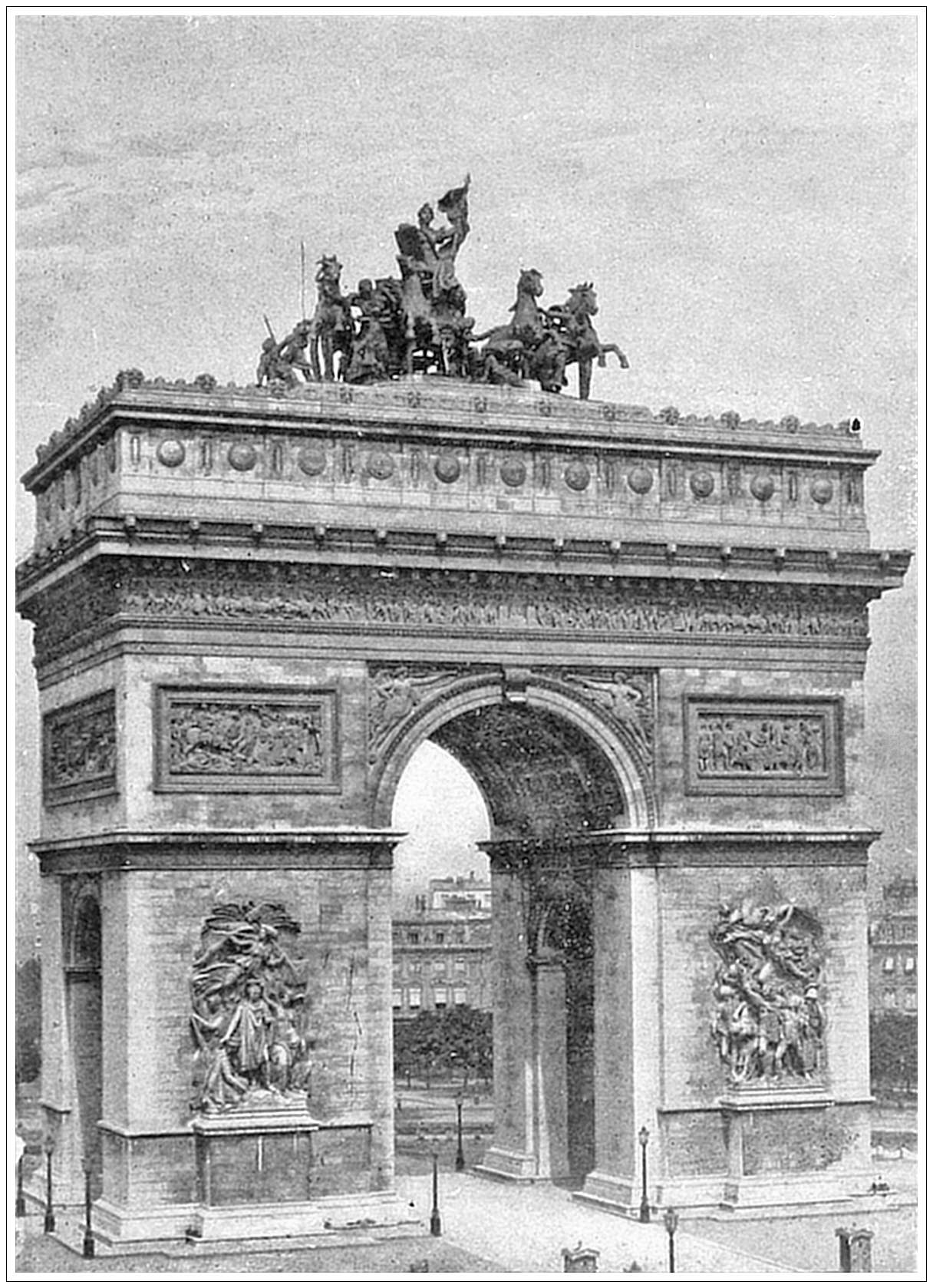
98
NAPOLEON’S TOMB, PARIS, FRANCE. Under the splendid dome of the Church of the Invalides, in a huge circular crypt below the level of the floor, is the tomb of the Great Napoleon I. The sarcophagus, hewn out of a single block of granite brought from Finland, was the gift of the Emperor Nicholas, when in 1841 the remains of the Emperor were brought back from St. Helena by the Prince de Joinville. The crypt is adorned with marble reliefs symbolical of Napoleon’s reforms and with twelve colossal figures of victory and sixty mouldering banners captured from the enemy. There are also monuments to Vauban and Turenne, Napoleon’s most illustrious predecessors in the field. At the entrance to the crypt lie the bodies of Bertrand and Duroc, the near friends and companions of Napoleon. The monuments or the remains of various members of the Bonaparte family are in the upper part of the church.
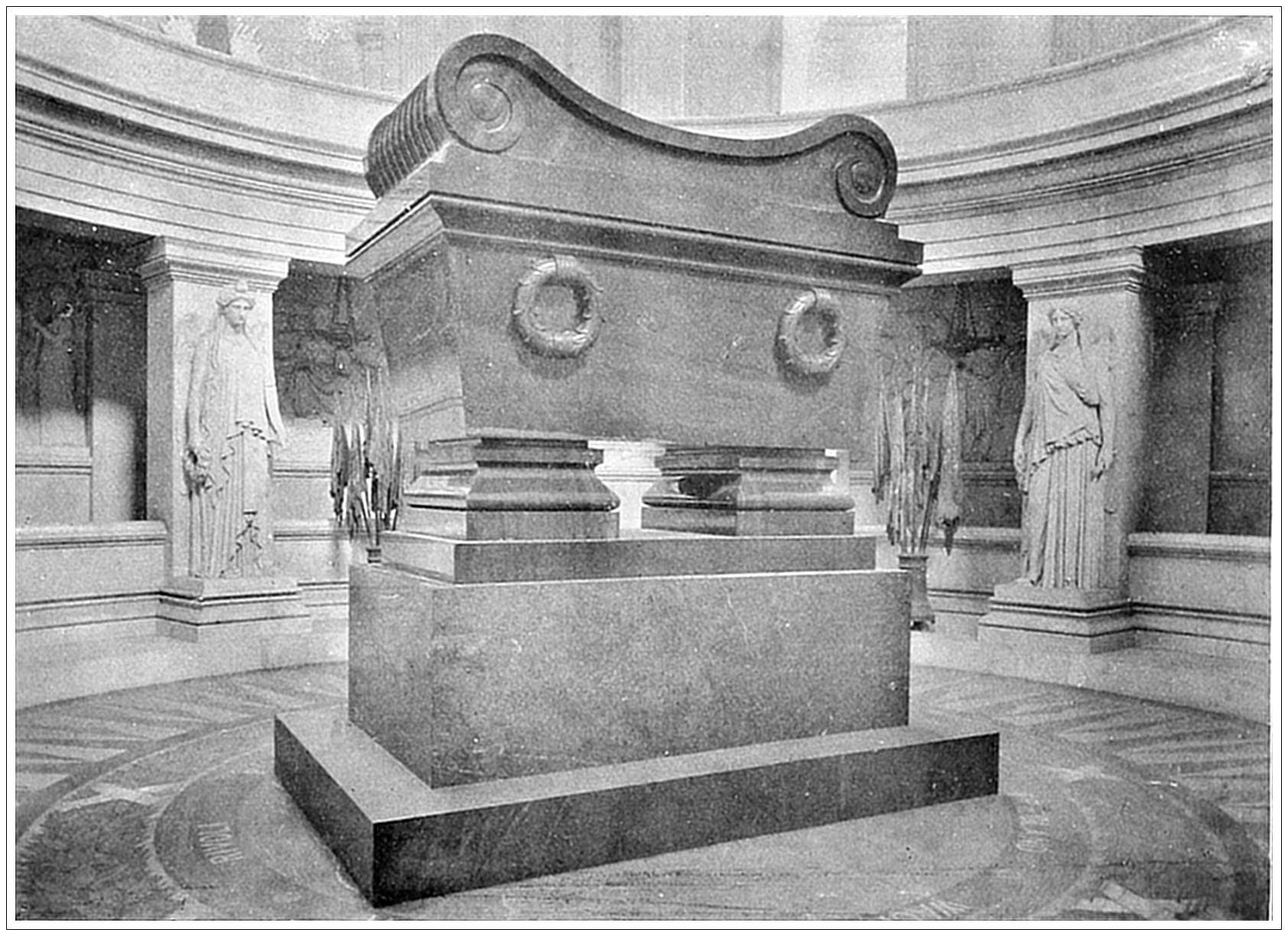
100
CHAMBER OF DEPUTIES, PARIS, FRANCE. This is sometimes called the Palais Bourbon. It is the seat of the French parliament. It is a large classical building on the left bank of the Seine, facing the Pont de la Concorde. The old façade was in the Rue de l’ Université at the back; the new one, with its Corinthian colonnade, was erected in 1804. The hall is a semi-circular room, with the President’s chair facing the extremity of the half circle. Here sat the Council of Five Hundred, Louis Philippe’s Chamber and Napoleon III’s Corps Legislatif, and here at present sit the deputies elected from the various districts of the French republic. Orators address the Chamber from the tribune, which is placed immediately under the President’s chair. Voting is done by means of white or blue cards, placed in tin receptacles that are handed round by the ushers; the white being an “aye,” the blue “nay.”

102
THÉÂTRE DE L’OPERA, PARIS. The new Opera House, in Paris, is the handsomest, though not the largest, temple of amusement in the world. It will hold twenty-one hundred people, while La Scala, in Milan, holds three thousand. The stage, however, in cubic and superficial area, is the largest known. It is equaled by others in depth, but surpasses them all in breadth. The exterior is bewildering in the richness of its decorations. The grand staircase and the foyer are in magnificent keeping with the exterior. This building is one of the creations of the Second Empire. More than one hundred houses were torn down to clear the square on which it stands. It was inaugurated on January 1st, 1875. The total cost is estimated at $8,000,000. The opera is managed by a director, who receives from the State an allowance of eight hundred thousand francs a year. He has to supply what is necessary and run all risks.

104
EIFFEL TOWER, PARIS. This is the highest structure in the world, being three hundred metres or nine hundred and eighty-four feet in height, as against the five hundred and fifty-five feet five and one-eighth inches of the Washington Monument, which comes next in altitude among all the edifices of man. The tower was constructed by Alexander G. Eiffel for the Paris Exhibition of 1878. Its foundations are sunk to a depth of fifty feet in the sandy soil of the Champs de Mars, and the four massive piers, which form the first stage of the tower, are so planted as to distribute the enormous weight of the structure (sixty-five hundred tons) in the best way possible. In spite of this weight the general impression is one of grace and lightness. The summit is crowned by a cupola with an exterior balcony, whence a magnificent panorama of Paris and its surroundings is unveiled. Elevators carry passengers up to the summit, the time consumed by the ascension being from six to seven minutes.

106
TROCADERO, PARIS, FRANCE. The Eiffel Tower is not the sole remaining monument of the French Exposition of 1878. Overlooking the Champs de Mars is the Trocadero, which was begun in 1876 for the same exhibition. It is a fantastic structure in the Byzantine style. The central portion consists of a circular edifice one hundred and eighty feet high and one hundred and eighty-nine feet in diameter, crowned by a dome, and flanked with two minarets two hundred and seventy feet high. On each side extends a wing in the form of a curve, six hundred and sixty feet in length, giving the entire edifice the appearance of an imposing crescent. On a level with the spring of the dome is a terrace adorned with thirty statues. The view of Paris from the terrace or the towers is superb. Below the balcony, in front of the central building, gushes a large cascade, which descends to a huge basin one hundred and ninety-six feet in diameter. Afternoon concerts are often given in the elaborately decorated Salle des Fetes, which seats six thousand persons. There are also collections of sculptures and antiquities.
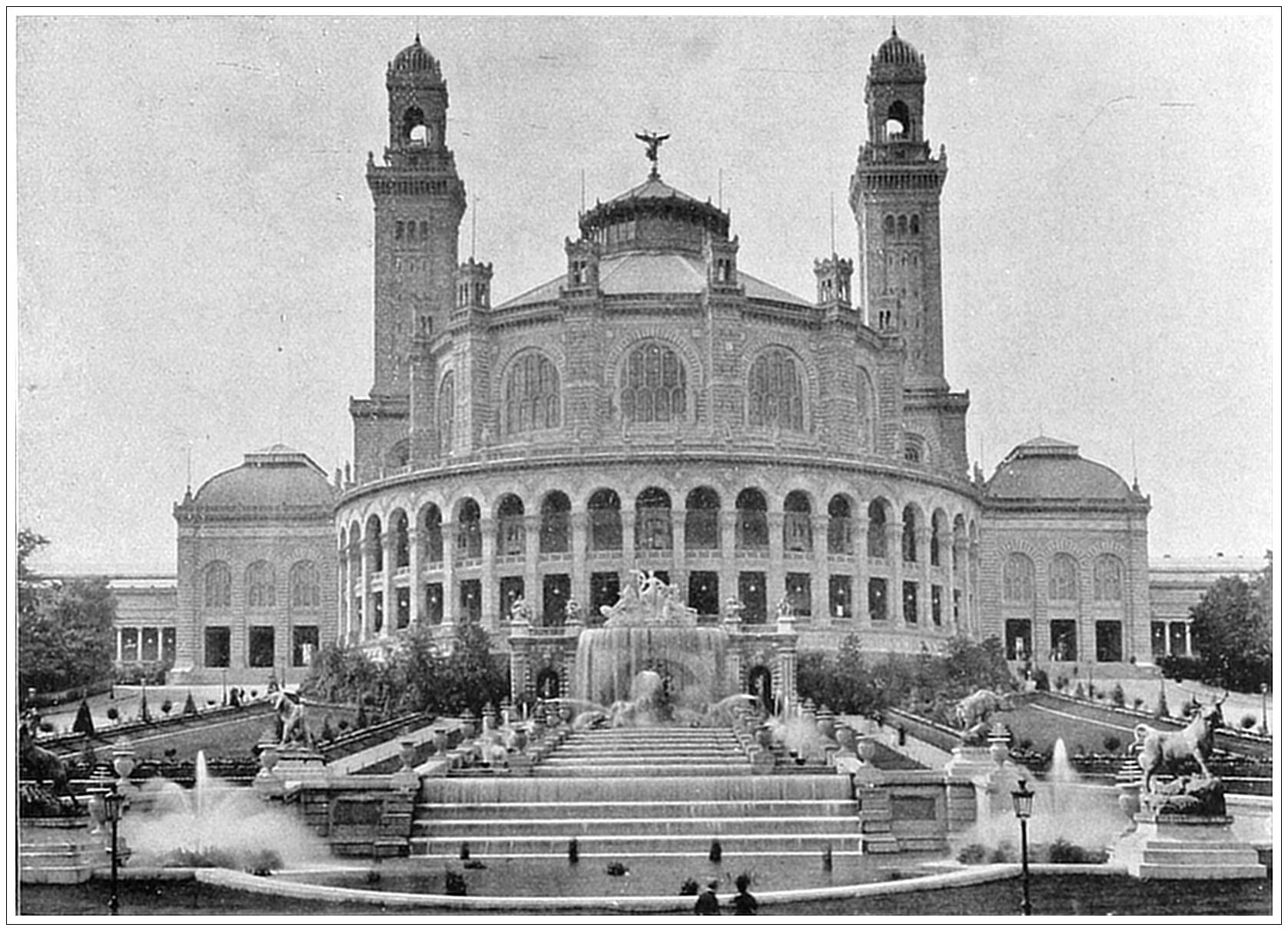
108
CHATEAU DE FONTAINEBLEAU, FRANCE. Fontainebleau is a small town thirty-five miles south-east of Paris. It is famous for the royal palace, which is situated in a magnificent park or forest, fifty miles in circumference, and covering an area of forty-two thousand five hundred acres. The building itself is said to occupy the site of a fortified chateau, built by Louis VII in 1162. But it was Francis I who transformed the mediæval fortress into a palace of almost unparalleled extent and magnificence. Henry IV did much towards its embellishment. Here his successor, Louis XIV, revoked the Edict of Nantes. It was a favorite residence of Napoleon I, whose sentence of divorce from Josephine was pronounced here. Louis Philippe and Napoleon III spent large sums in restoring it. The exterior of the building, with the exception of several pavilions, is only two stories in height. The interior is a splendid example of decorative work. Some of the greatest French and Italian artists of the epoch of its creation were employed upon it. Especially beautiful is the chamber of Anne of Austria, the mother of Louis XIV, and Queen-regent in his minority, who made Fontainebleau her favorite residence, and spent money lavishly in the decoration of her chamber.
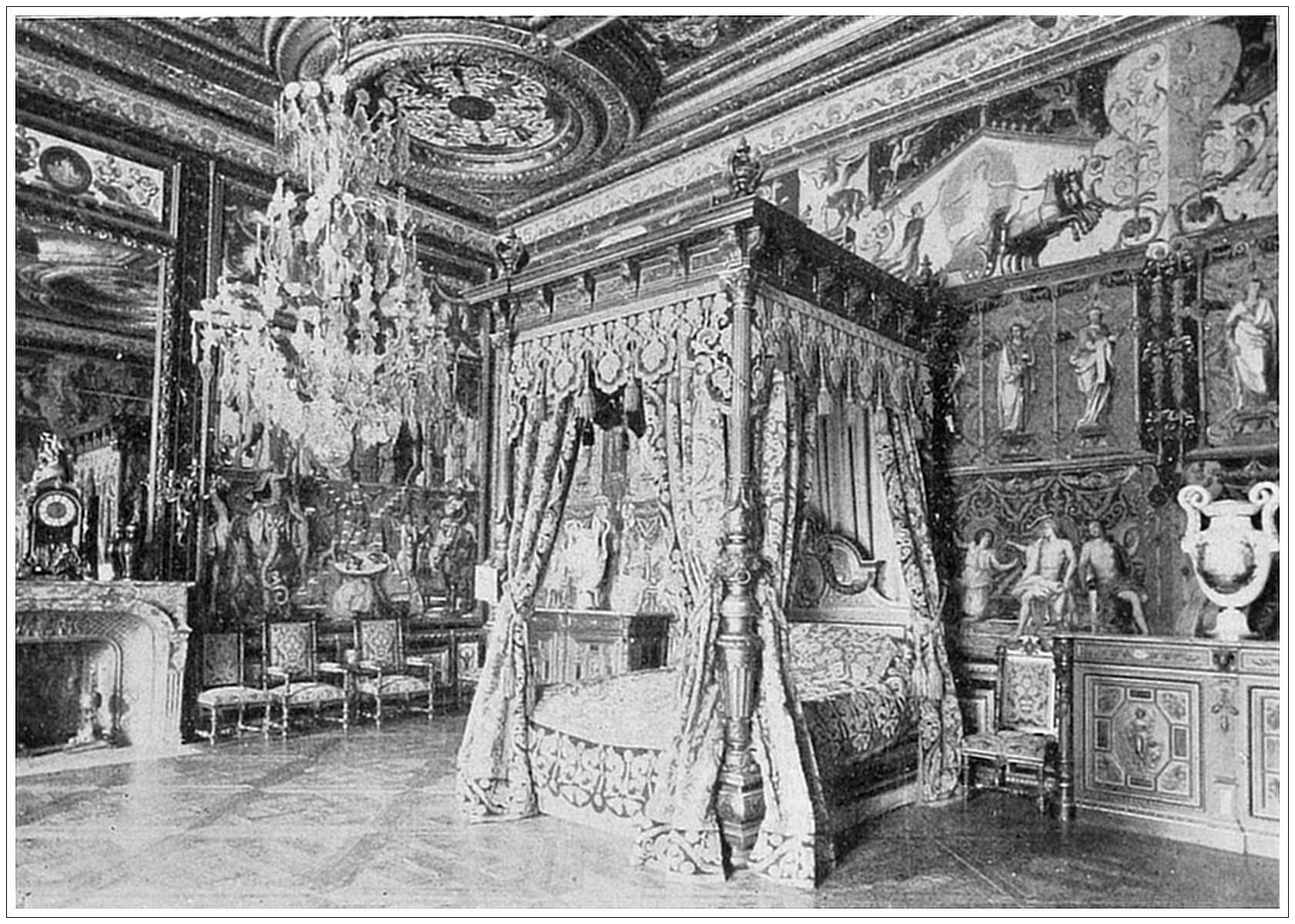
110
GARDEN AND FOUNTAINS, VERSAILLES, FRANCE. The Palace of Versailles is in the town of the same name, ten miles from Paris, was built by Louis XIV in 1661, and became a royal residence in 1681. As such it has held a great place in the history of France. It is now used as a historical museum. The garden which surrounds it is justly celebrated for its extreme beauty. Among its chief marvels are the fountains, richly adorned with bronze statues, and from the centre of each rises a column of water to the height of forty feet, encircled by sixteen inclined jets of water, the whole forming a sort of basket. The water which feeds the fountains is brought from the Seine by the machine of Marly, constructed at enormous expense after the failure of the plan to turn the River d’ Eure from its course.

112
GRAND TRIANON, VERSAILLES, FRANCE. A charming residence near the palace of Versailles, built by Louis XIV in 1688 for Madame de Maintenon, but chiefly interesting for its associations with Marie Antoinette, whose favorite residence it was. Here she amused herself with her Swiss village, and here, as well as in the adjacent Petit Trianon, she and her court played at shepherds and shepherdesses. The Grand Trianon is built in the Italian style, with the rooms all on one floor. The interior is exquisitely furnished and adorned. In the surrounding gardens are cottages and artificial “mountains” (some nearly ten feet high) and glens and grottoes and pebbly-bottomed brooks.

114
BULL FIGHT, SEVILLE, SPAIN. The bull fight is the national sport of Spain. The sport has been described as a tragedy in three acts. First, the bull is let out and goaded to fury by the lances of the mounted picadores. If a picador is thrown or his horse is wounded the chulos rush in and attract the bull by waving their cloaks in front of him, saving themselves, if need be, by leaping over the palisade which encloses the circus. When the bull begins to flag the chulos attack him with barbed darts, called banderillas, which they stick into his neck. The third act introduces the matador, who enters alone. He holds in his right hand a naked sword, in his left a muleta or small stick with a piece of scarlet silk attached. The bull rushes blindly at the muleta. The matador, if he be skillful, plunges the sword into the left shoulder and the animal drops dead. Sometimes, however, he misses his first aim and then he has to try again. Sometimes he is wounded or even killed and then a new matador appears on the scene.
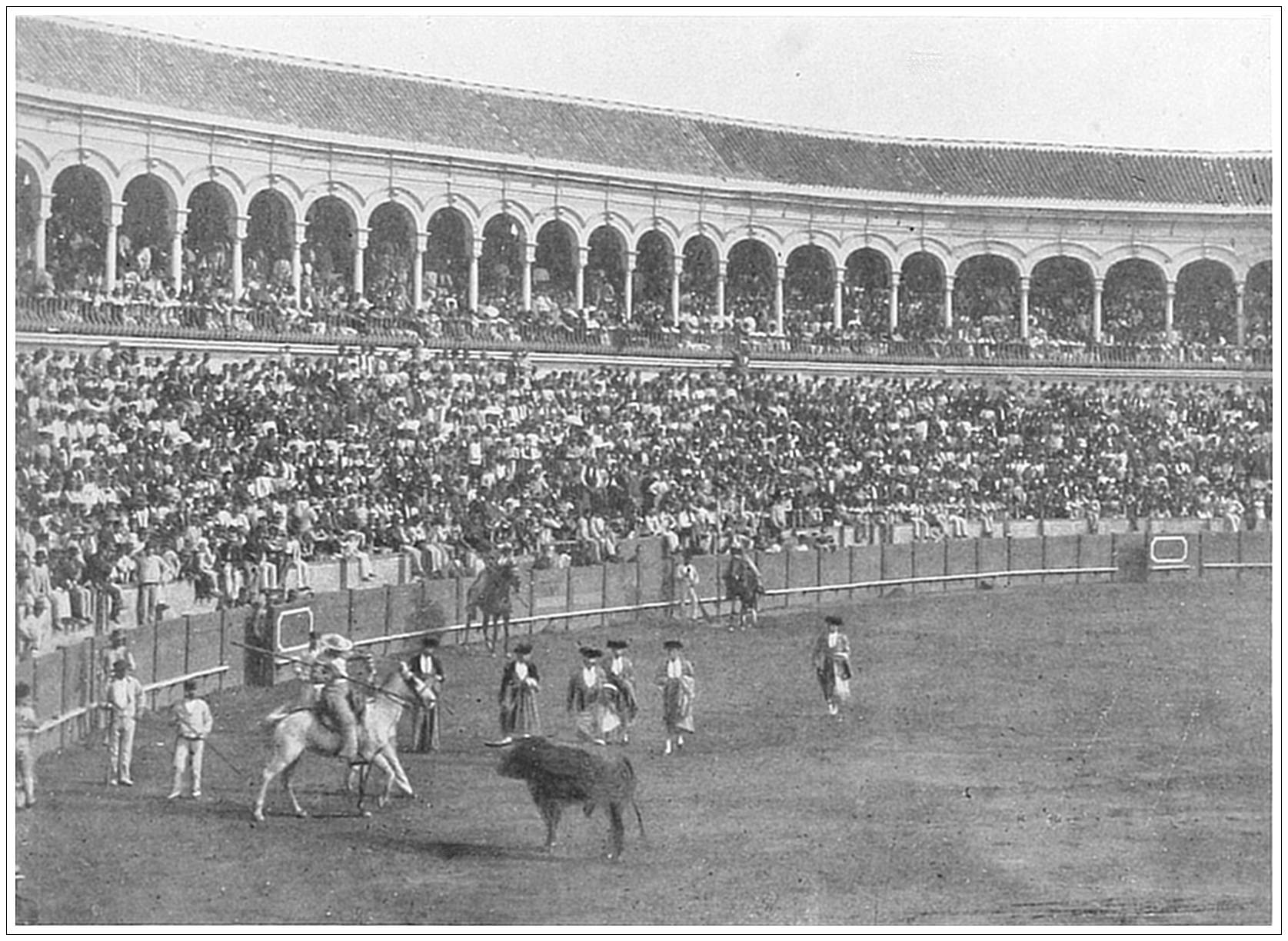
116
THE ALHAMBRA, GRANADA, SPAIN. Alhambra means the “Red Castle.” This fortress and palace of the ancient Moorish kings—“the pride of Granada and the boast of Spain”—is a vast and irregular collection of buildings built of bricks slightly reddened. The principal building was begun in 1248 and finished in 1314. Here the Moorish kings lived, surrounded by their court and nobility, a total population of some forty thousand souls. Its degradation dates from the day of the Castilian conquest, for the alterations and restorations made by the Spanish kings were without judgment. Philip V, early in the eighteenth century, was its last royal occupant. After his desertion the place was allowed to fall into decay until 1862, when the Spanish government took it in charge. Happily, the most important portions still exist, and present a bewildering array of pavilions, courts, colonnades, fountains, baths, gilded ceilings and every kind of Oriental decoration.
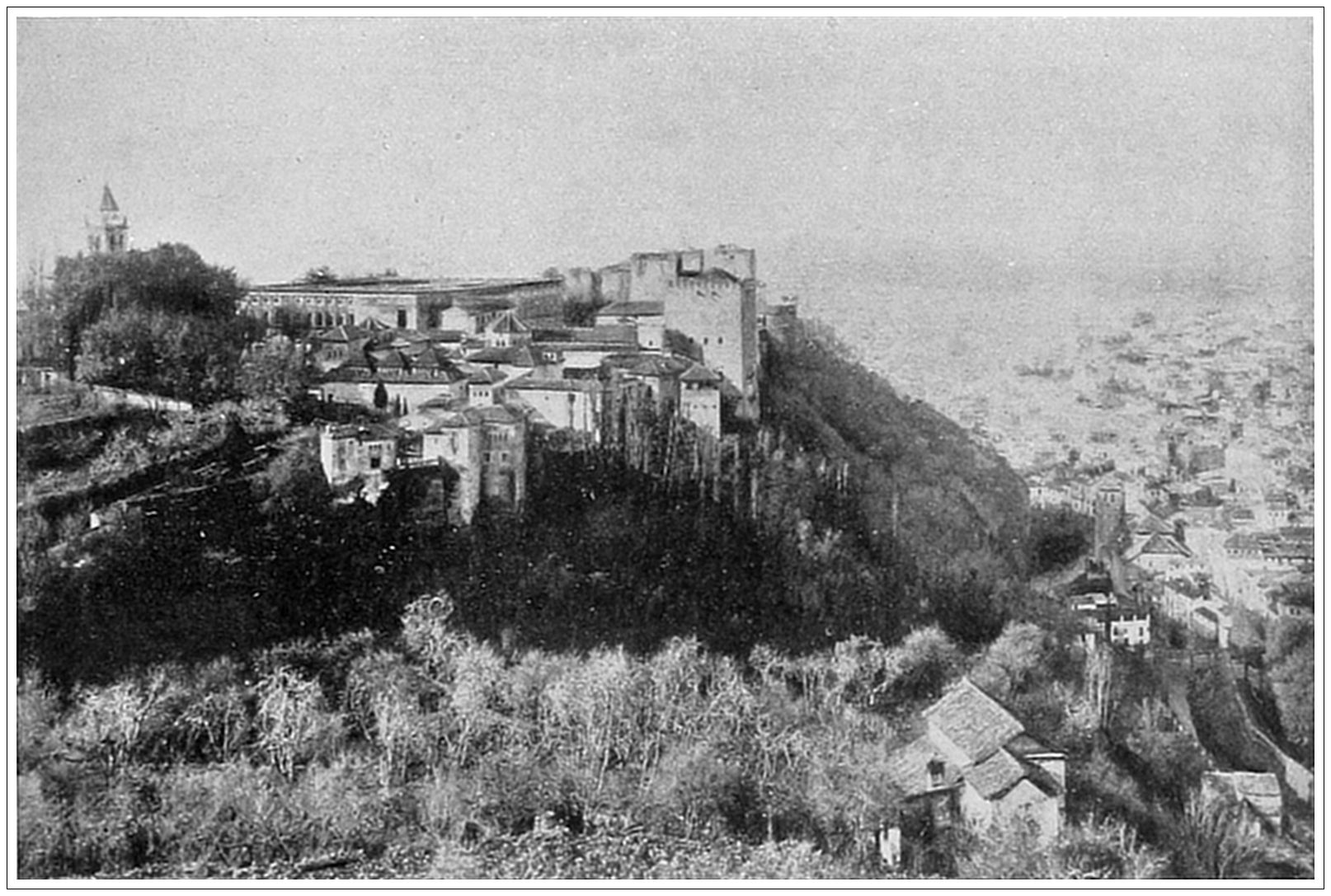
118
CORDOVA, SPAIN. This is one of the most ancient and picturesque of Spanish towns. Its walls, built on a Roman foundation with Moorish superstructure, inclose a large area, dotted with Roman and Moorish remains. Chief among the latter is the cathedral, which looms up almost in the centre of our picture. It dates from the eighth century, and was formerly a mosque. Authorities generally agree that it is the finest specimen of a Moorish mosque in all Europe. The southern suburb communicates with the town by means of an ancient bridge across the River Guadalquiver, whose sixteen arches exhibit the usual combination of Moorish and Roman architecture. At one end of the bridge is an elevated statue of the patron saint, St. Raphael, whose effigy abounds all through the city. Our picture is taken from the southern suburb.
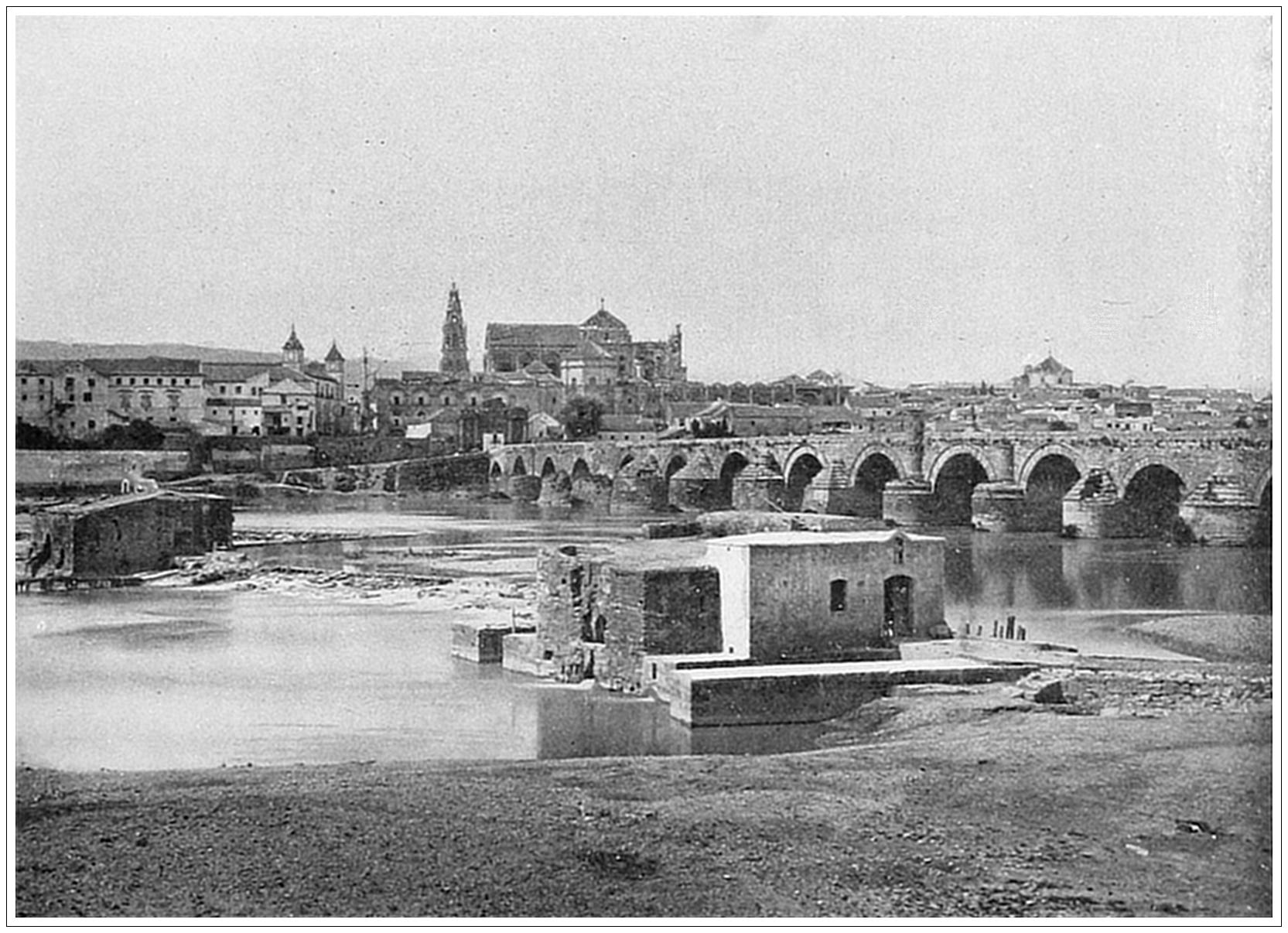
120
ROCK OF GIBRALTAR, SPAIN. An inaccessible rock, buttressed by an impregnable fortress, which juts out from the southern extremity of Spain, in Andulasia, gives to the English, who hold it, the virtual command of the Mediterranean. The rock is fourteen hundred and thirty feet high at its highest point; its length, from north to south, about three miles; its circumference about six. It is mainly composed of compact limestone and dense gray marble, varied by beds of red sandstone and tissues of osseous breccia. The north face is almost perpendicular, but the east side is full of tremendous precipices. It came into possession of the English by conquest during the war of the succession in 1704. Since then they have spent immense sums in its fortification, with so much success that they have retained it against the combined efforts of France and Spain. From the sea the rock presents a grim enough aspect with its immense cannon, its piles of balls and bombs, and its apparent lack of vegetation. But a closer view shows patches of fruit trees, together with a great variety of odoriferous shrubs.

122
MONTE CARLO, MONACO—THE CASINO. Monaco is a small principality on the Mediterranean, ruled by Prince Albert, of Monaco. It is chiefly famous for the notorious Casino at the small town of Monte Carlo, where alone in Europe public gaming is authorized by law. The first stone of the Casino was laid in 1858, and gambling tables had existed in Monaco two years previous to that date, but it was not till 1860, when M. Blanc, expelled from Homburg, took possession of the place, that Monte Carlo began to be famous. The gaming establishment is now in the hands of a joint stock company, with a capital of 15,000,000 francs, who leased the ground from the prince. It employs nearly one thousand people and is annually visited by about four hundred thousand visitors. The inhabitants of Monaco are not allowed at the tables. Their good will, however, is secured by their exemption from taxation and by the flood of paying visitors who are attracted hither. Monte Carlo is in itself a place of exquisite beauty, natural and artificial.
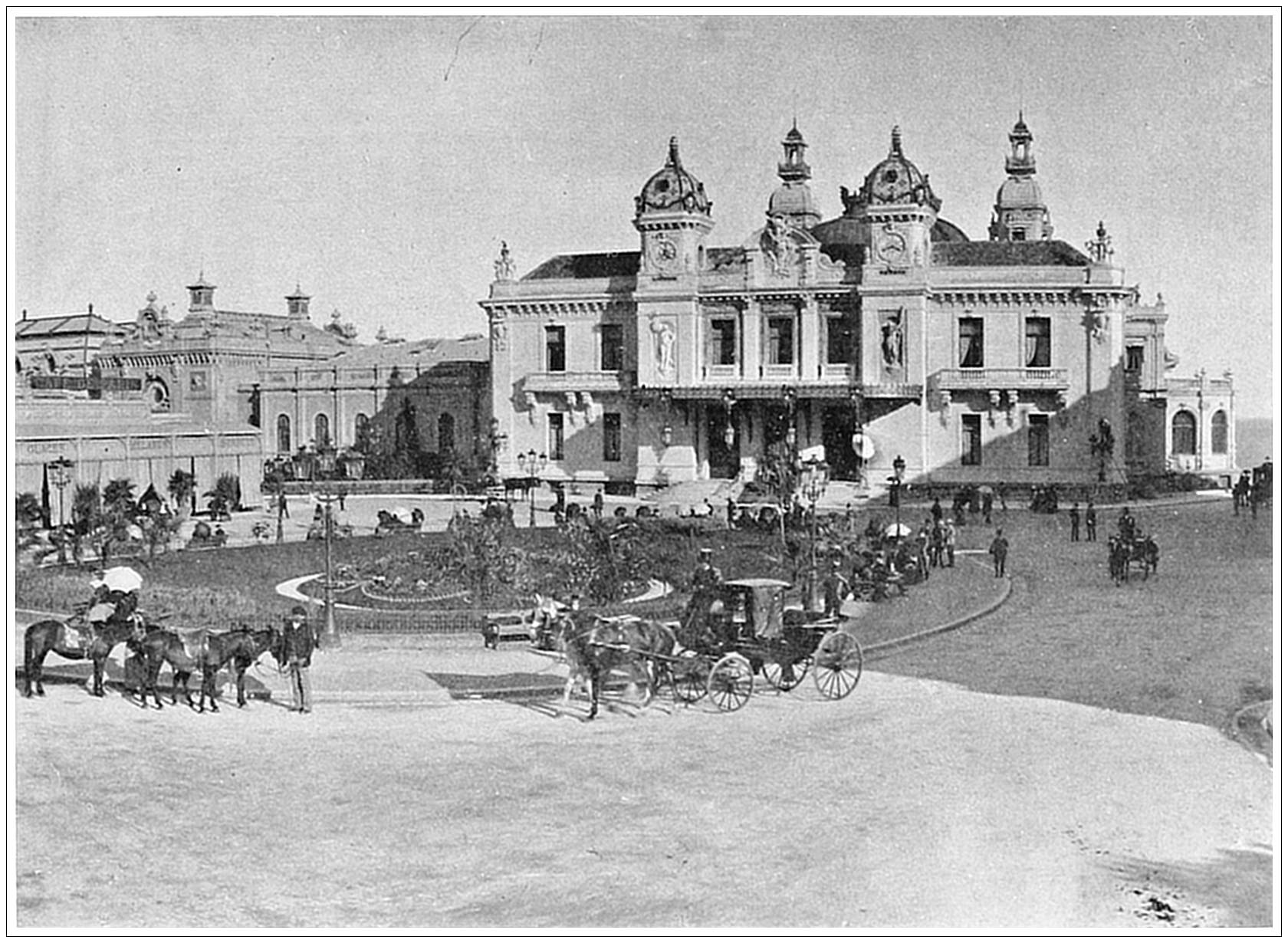
124
LAKE LUCERNE, SWITZERLAND. Not only in wild and picturesque scenery, but in its legendary and historical associations, this is one of the most interesting lakes in the world. In Switzerland it is alternatively known as the Lake of the Four Forest Cantons, because bounded by the cantons of Uri, Schwyz, Unterwalden and Lucerne. The mountain peaks surrounding it give it the form of a St. Andrew’s cross, whence comes that cross on the Swiss flag. Mounts Pilatus and Rigi stand at the north like sentinel outposts of the Alps. The beginning of the St. Gothard Pass over the Alps is at Fluelen to the south. The lake is intimately connected with the Tell legends, and at one of its most enchanting spots a small chapel, attributed to the fourteenth century, is said to mark the spot where he sprang out of Gessler’s boat as he was being carried away a prisoner.
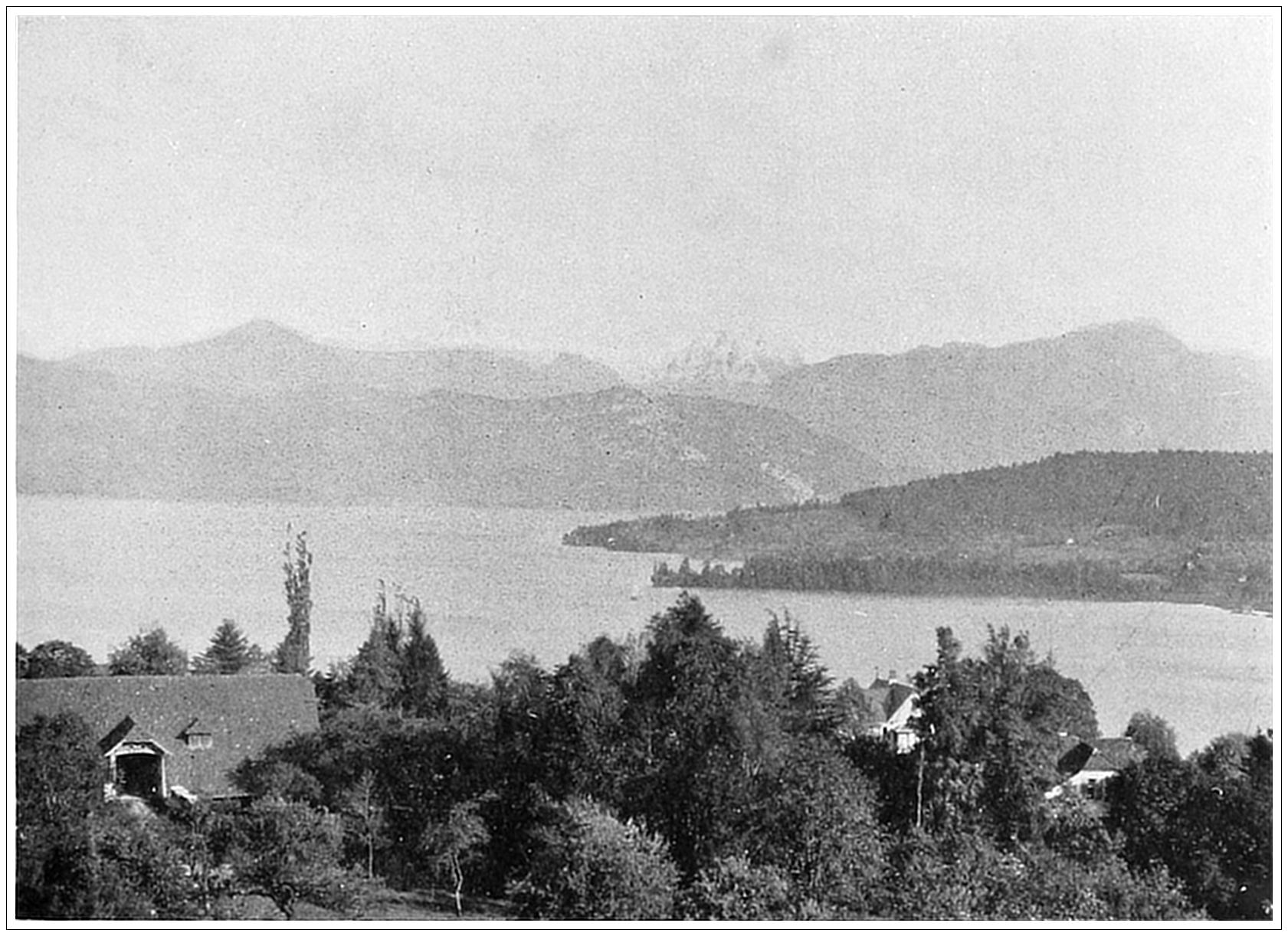
126
MONT BLANC FROM CHAMOUNI, SWITZERLAND. This, the highest mountain in Europe, and, by common consent, the most magnificent in its scenery, rises at the southern end of the valley of Chamouni, fifteen thousand seven hundred and eighty-one feet above sea level. During the last century and a half it has been a favorite resort of tourists, and especially of scientists, as its glaciers and other marvelous features are full of interest and instruction. But it was not till 1786 that Balmat and Paccard made the first ascension, followed in 1787 by Saussure. Many accidents have happened here in the past. In 1870 a party of eleven, two of them Americans, all perished in the snow-crowned heights. Nowadays the ascensions are more numerous, and, with proper precautions, are considered absolutely safe, though very fatiguing, and occupying three days. The view from the valley of Chamouni is of extraordinary beauty. It has been celebrated by Coleridge in one of his most famous poems, and has been the theme of countless other pens. Not always is the “monarch of mountains” visible from Chamouni, as his imperial front is frequently hidden from the sight of his worshipers. But the photograph here presented is taken on a fortunate day, when there was no cloud about the throne.
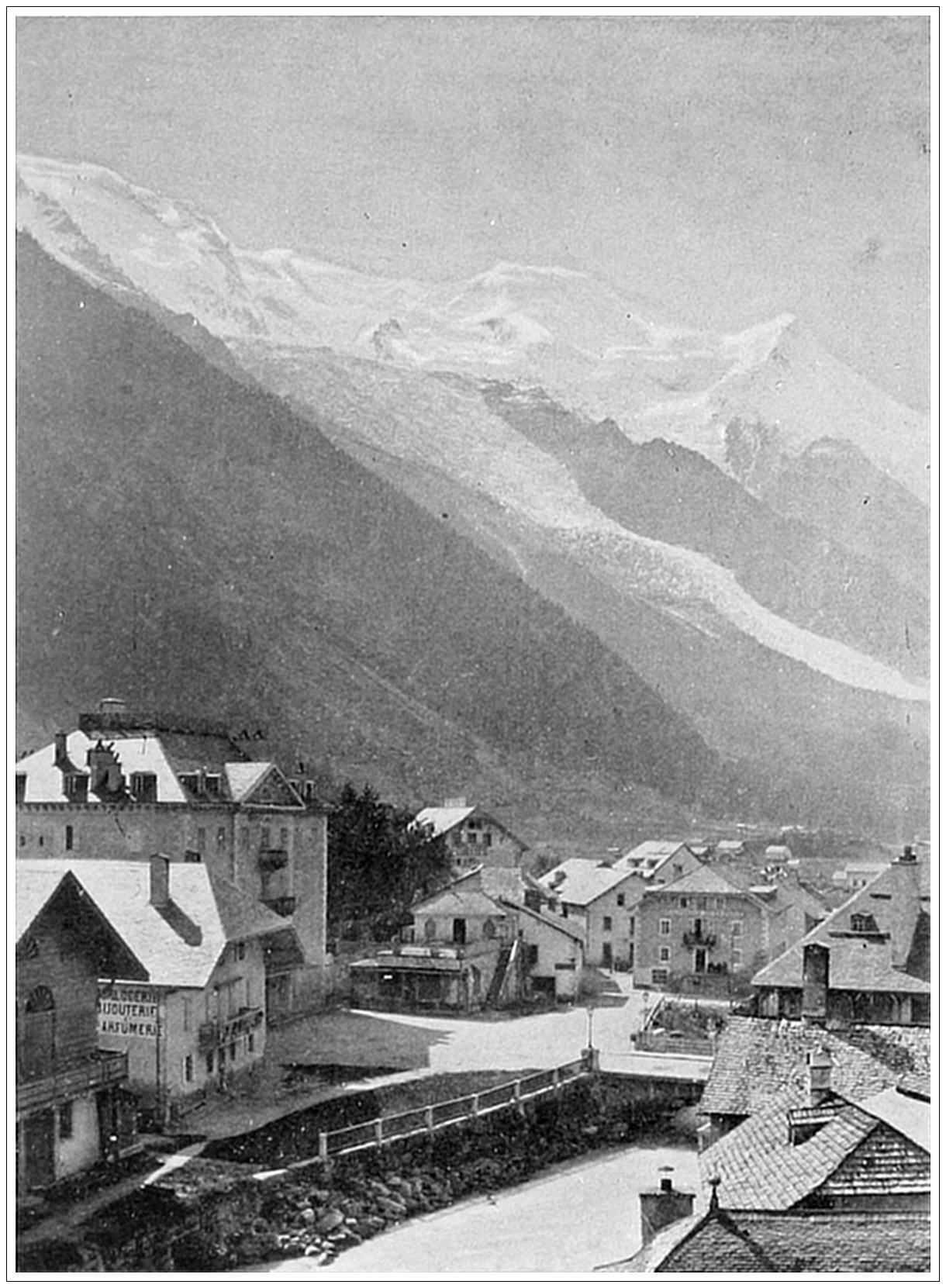
128
MER DE GLACE, MONT BLANC, SWITZERLAND. This immense glacier fills the highest gorges of the chain of Mont Blanc, and extends over a distance of twelve miles into the Valley of Chamouni. It is formed by the masses of snow and ice which collect during the long winters. In appearance it is just what its name implies, a Sea of Ice, whose tumultuous waves seem to have been suddenly frozen, not while they were being lashed to fury by a tempest, but at the very moment when the wind had subsided and left them high indeed, but rounded and blunted in outline. Slowly—so slowly that the motion is imperceptible—it flows down the inclined plane between two mountains cracking, groaning and melting until it resolves itself into a torrent, known as the Arveiron. There are other seas of ice among the Alps, but this by pre-eminence is known as the Mer de Glace. It was in the study of this region that Agassiz conceived his glacial theory.

130
THE MATTERHORN, SWITZERLAND. This famous Alpine height is situated in the canton of Valais, in Switzerland, overhanging the little village of Zermatt. It is fourteen thousand seven hundred and five feet high, and its peak is the sharpest and most acute in all the Alpine region, rising like a sort of triangular obelisk into the clouds. Its sides are so precipitous that the snow itself can hardly find a lodgment. For a long period it was deemed inaccessible to man. On the 14th of July, 1865, a party, consisting of Messrs. Hudson, Whymper and Hadow, with Lord Francis Douglas and three guides, succeeded in reaching the summit, but in the descent Mr. Hudson lost his footing, and all save Mr. Whymper and two guides, who escaped by the breaking of the rope, were precipitated to a depth of four thousand feet towards the Matterhorn Glacier. The ascent is now made several times annually. The rock has been blasted at the most difficult points and a rope attached to it.

132
RIGI-KULM, SWITZERLAND. The Rigi Mountain, five thousand nine hundred and five feet above sea level, or four thousand four hundred and seventy-two feet above Lake Lucerne, is not one of the highest mountains of Switzerland, but the beautiful and extensive view commanded from the Kulm, or summit, makes it one of the most popular. The famous Riggenbach cog-wheel railway brings travellers up to the Kulm, a small, bare space, whence the eye takes in a panorama of three hundred miles in circuit. Immediately below lie the lakes of Lucerne and Zug, their shores lined with picturesque little towns. Eight other lakes, including a bit of Zurich, may be counted in the distance. Snow-capped mountains—the Jungfrau, the Wetterhorn, the Schreckhorn, the grand snow-covered peaks of the Bernese Alps and countless other peaks of lesser note—stretch away on every side to the horizon. The railway up the mountain is of ordinary gauge. Along the centre runs a cogged track, into which a cog-wheel on the locomotive works, thus giving the power for the ascent. In going down the brakes are worked by atmospheric pressure. The construction of this five miles of line, which in its ascent overcomes about one mile of altitude, cost about $300,000.

134
THUN, SWITZERLAND. One of the most picturesque of Swiss towns is Thun, which is charmingly situated on the banks of the river Aar, three-quarters of a mile below its efflux from the lake. Many of the town’s buildings are very old. The Castle of Zahringen-Kyburg, whose large square tower forms a noted feature of the landscape, dates from 1182. The principal street is curious. In front of the houses projects a row of warehouses and cellars, on the flat roofs of which is the pavement for foot passengers, flanked with the shops. The view here presented is taken from the pavilion in the Bellevue Grounds, which overlooks the city, and commands the old-fashioned town, the lake, the Alps and the Valley of the Aar.
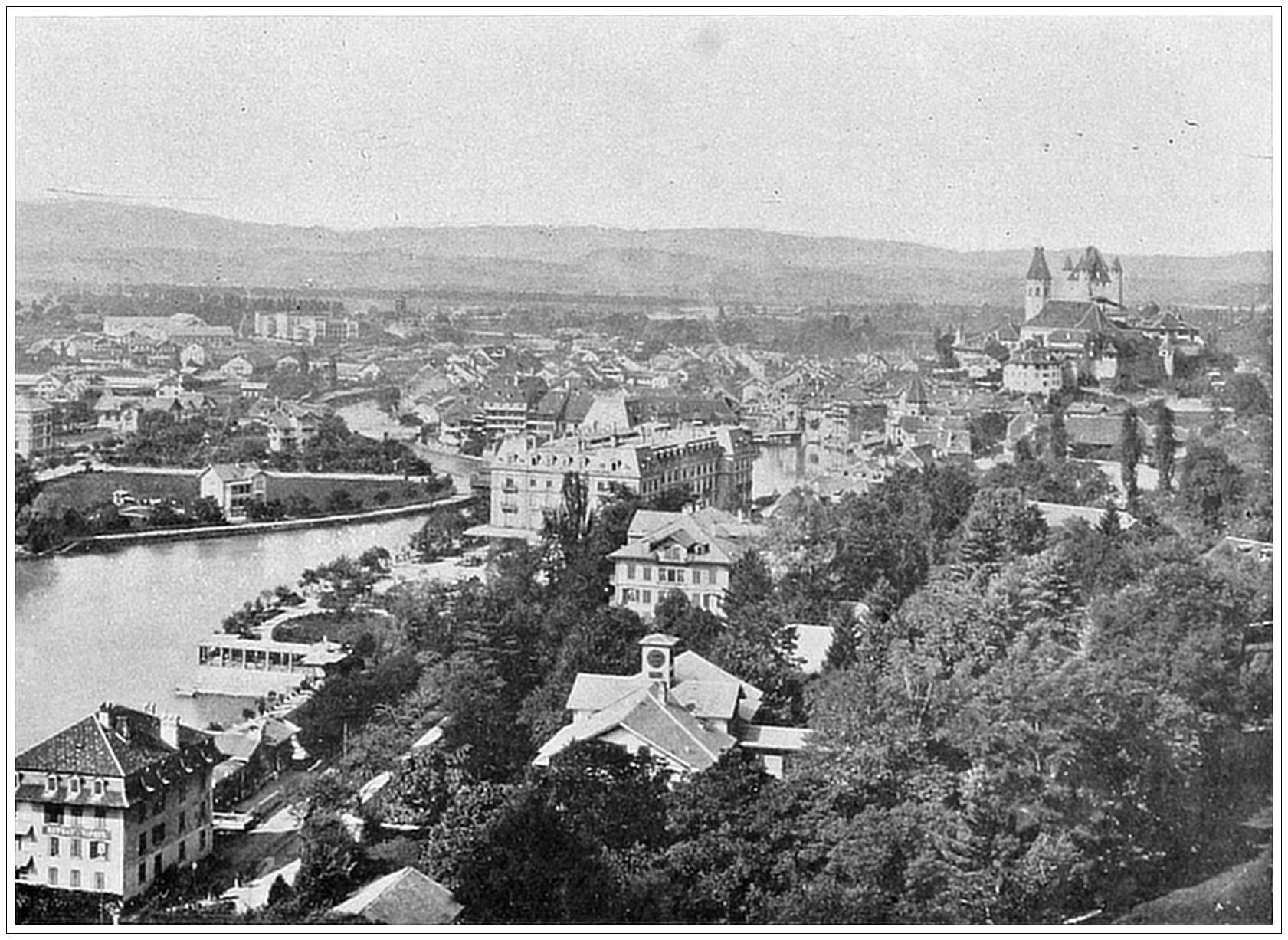
136
JUNGFRAU FROM INTERLAKEN, SWITZERLAND. The town of Interlaken, as its name indicates, is situated between two lakes (Brienz and Thun), in a valley about three miles wide, on either side of which rises a ridge of precipitous mountains six thousand feet high. The great attraction of the place is not the scenery either way along the valley, but a view that is caught through a depression in the mountains on the southern side, revealing the Jungfrau (“Young Maiden”) Mountain and her attendant galaxy of noble Alpine peaks, rearing their snow-crowned heads far above the horizon. The Jungfrau is the most imposing eminence in all the Bernese Alps. Surrounded by stupendous precipices, her surface is broken by valleys, ravines and glaciers, which from a distance look like creases in the mantle of snow that covers her enormous flanks. The first ascent of this mountain was made on August 3d, 1811.

138
CURSALON, VIENNA, AUSTRIA. This handsome structure, in the Italian renaissance style, was put up in 1865–67. With its surrounding gardens, it forms one of the most attractive spots in the city. Concerts are given here on Sundays and Thursdays, when large crowds are always sure to attend.
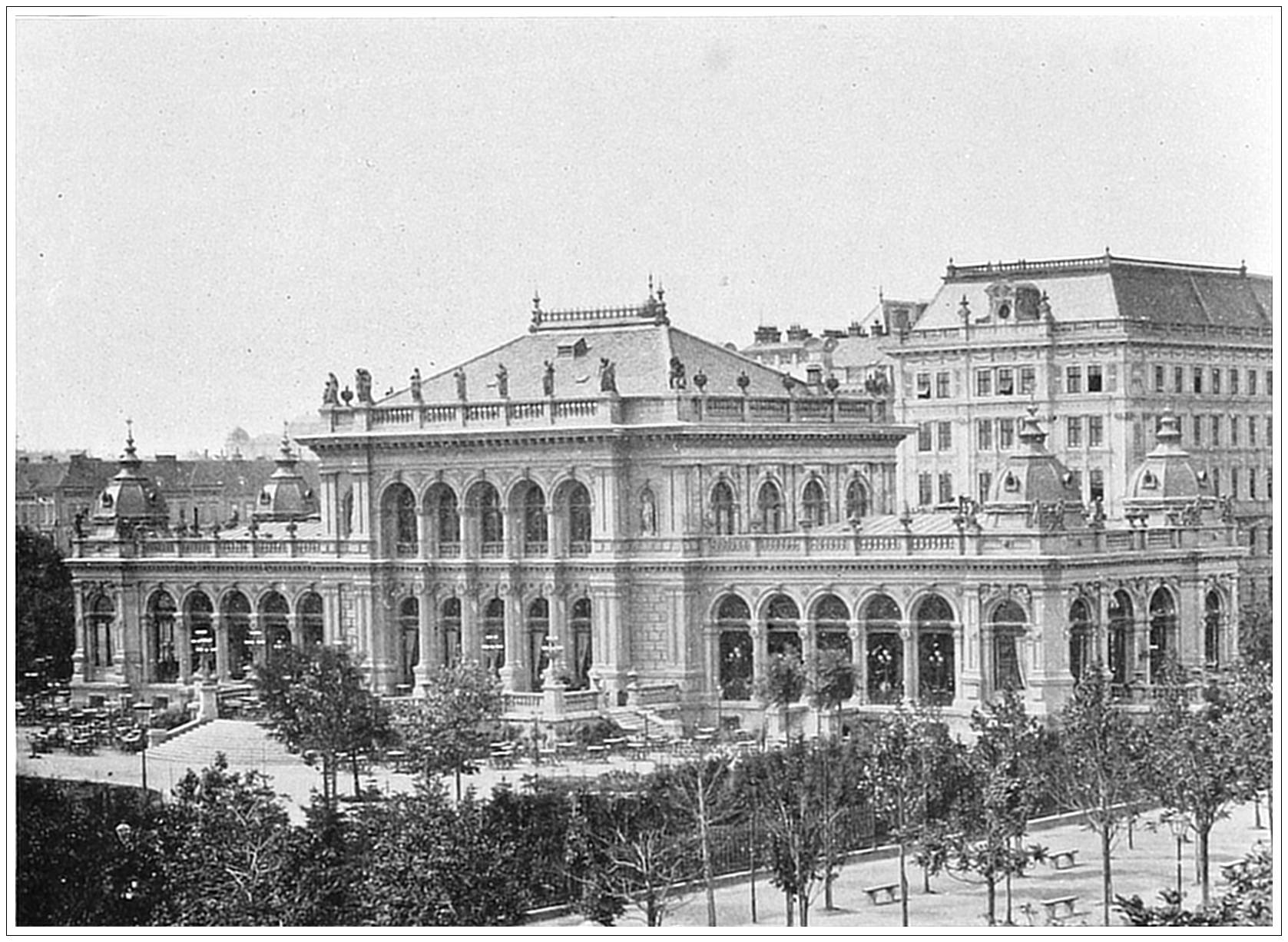
140
CATHEDRAL, MILAN, ITALY. The Milanese look upon this church as the eighth wonder of the world. In truth, it is a marvelous edifice. “Gothic art,” as Taine says, “here attains its triumph and its extravagance.” Nowhere else is it so pointed, so complex, so highly embroidered, so full of delicate detail. It differs from most Gothic cathedrals in being built, not of dark stone, but of beautiful, lustrous white Italian marble. Begun in 1386, it was not fully completed until 1805, at the direction of Napoleon. The design is said to be taken from Monte Rosa, one of the loftiest peaks of the Alps. Its ninety-eight sculptured pinnacles, rising from every part of the body of the church, certainly bear a striking resemblance to the splintered ice crags of Savoy. Next to St. Peter’s, at Rome, and the Cathedral at Seville, this is the largest church in Europe, covering, as it does, an area of fourteen thousand square yards.
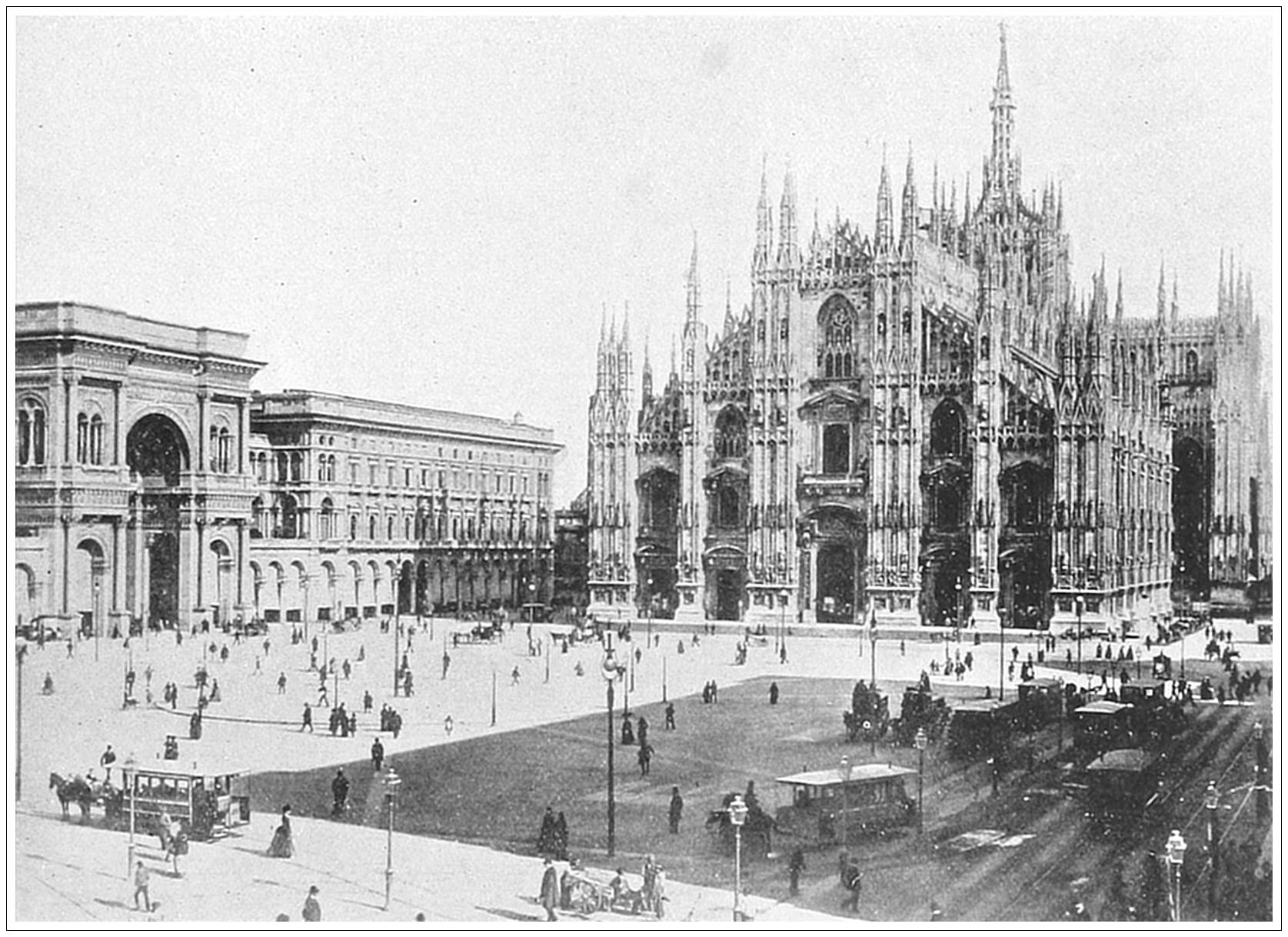
142
PANORAMA OF VENICE, ITALY. No city in the world is more fascinating than Venice. Its very situation makes it unique, built as it is on a cluster of small islands, a hundred or more in number, in the lagoon of the same name. A long, narrow sand-bank, divided by several inlets, separates the lagoon from the Adriatic. The largest of the islands is the Isola di Rialto, which gives its name to the famous bridge. The Grand Canal winds through the city in a double curve, like the letter S, and divides it into two unequal parts. The one hundred and forty-six smaller canals and a perfect network of small streets and bridges form the other thoroughfares. The splendid churches, the vast treasures of art and the magnificent palaces, remind one of the glories of the past, and fill the present with a surpassing beauty. By the fifteenth century Venice had become the greatest republic in Europe and the focus of its commerce. The immense wealth of its merchant princes enabled them to gratify their artistic sense in the superb monuments still extant.

144
ST. MARK’S, VENICE, ITALY. This famous cathedral church is a strange jumble of all styles of architecture, Christian as well as Saracenic, yet both without and within breathing a rich and wonderful harmony. The present building, dedicated in 1085, takes the place of an older and simpler structure, that was destroyed by fire in 976. In front of the church, to the southwest, rises the Square Campanile, surmounted with the figure of an angel. To the east of the church the famous Piazzetta, or “Little Square,” extends to the Grand Canal, glorified by the Palace of the Doges, or ancient rulers of the city, which some architects look upon as the finest building in the world. It is from this Piazzetta that the picture is taken. The square in front of St. Mark’s is the grand focus of attraction in Venice, and in summer nearly the entire population congregate here.
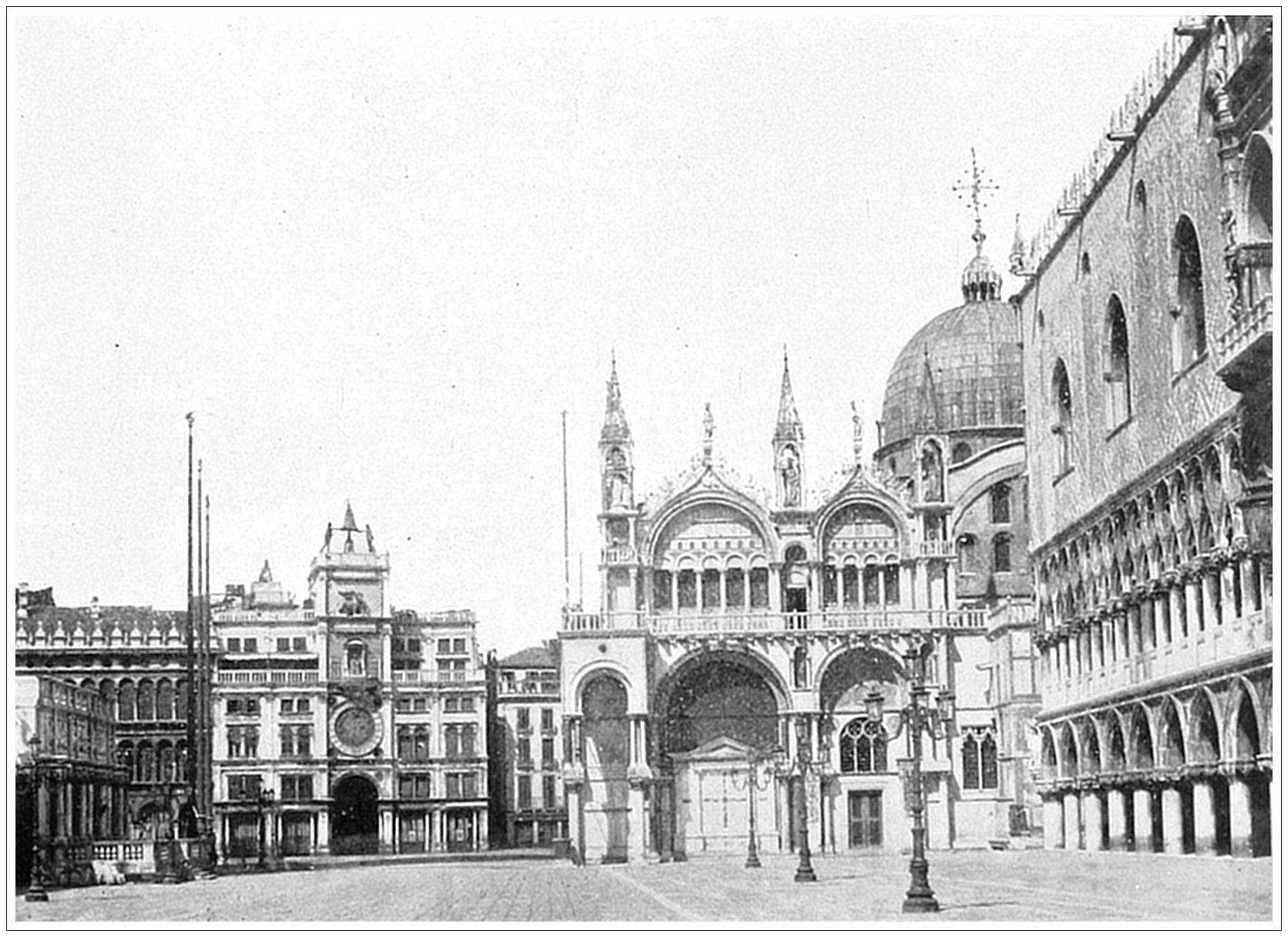
146
GRAND CANAL, VENICE, ITALY. This is the main thoroughfare of the city of the sea. On either side of its serpentine length it is lined by marble-fronted palaces, whose very names awaken a thrill of historic or romantic recollection. Gondolas dart up and down among the waters, and, alas! the disillusionizing modern steamboat puffs its vicious way through the complaining waters. About half-way in its course the canal is crossed by the famous Rialto bridge, a single arch of unique and elegant construction, seventy-four feet in length, resting on twelve thousand piles. This was built in 1588, subsequent therefore to the period of Venice’s greatest glory. The ancient Rialto, which Shakespeare speaks of as the meeting place of the merchants, was not this bridge, but the Exchange which used to go by the same name, and was long the centre of trade and commercial life in this city.
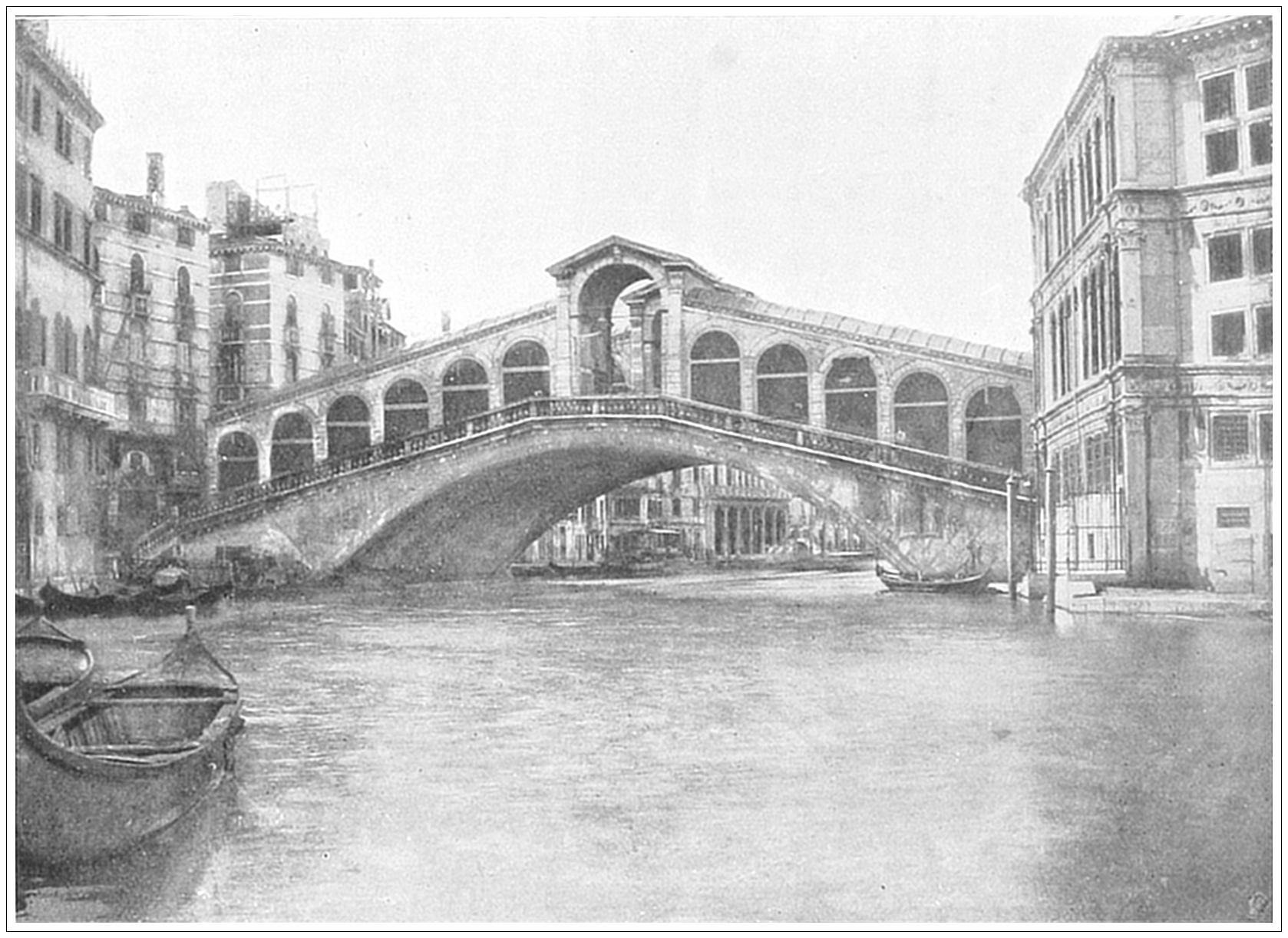
148
THE DOGE’S PALACE, VENICE, ITALY. At right angles to the Piazza San Marco, at the south-east end, runs the Piazzetta or little square, whereon is situated the former residence of the Doges, an ancient seat of government. Ruskin calls this “the principal work of Venice.” Originally built in 800, five times destroyed and as many times rebuilt in a style of greater magnificence, the present structure dates from the fourteenth century. It is in the Moorish-Gothic style. The form is an irregular square; the west side, facing the Piazzetta (two hundred and thirty feet in length), and the south side, facing the sea (two hundred and twenty feet in length), are flanked by two colonnades, one above the other, with exquisite traceries. The mouldings of the upper colonnade are especially rich. The interior court of the building presents a wilderness of elegant columns, cornices, arches, carvings, sculptures and bas-reliefs. A magnificent collection of Venetian paintings is housed within these walls. On the east side the palace is connected with the prisons by the so-called Bridge of Sighs, which owes most of its fame to Byron’s sentimentality.
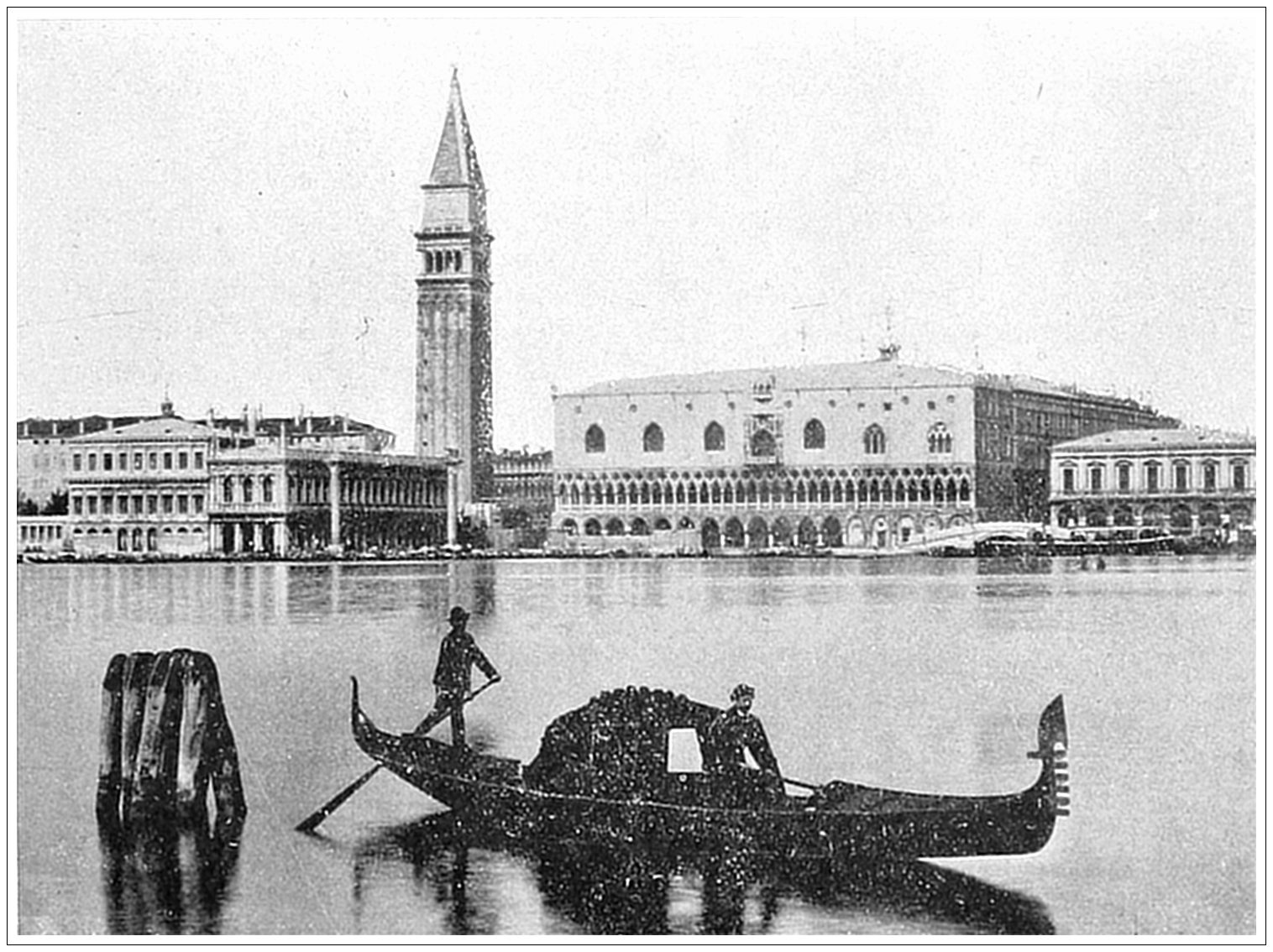
150
CATHEDRAL AND LEANING TOWER OF PISA, ITALY. The Cathedral of Pisa, begun in 1063, and consecrated in 1118, forms, with its Baptistery and Campanile, the most singular group of buildings in the world. Their beauty is equal to their singularity. The church itself is constructed entirely of white marble, with black and colored ornamentation. An elliptical dome covers the centre. The façade, adorned in the lower story with columns and arches, and in the upper story with four open galleries, is of exquisite and dainty beauty. So, likewise, is the Baptistery, a circular structure, surrounded by half columns below and a gallery of small, detached columns above, the whole crowned by a conical dome. But the strangest effect of all is produced by the Campanile, better known as the Leaning Tower, from the fact that it is thirteen feet out of the perpendicular. That this obliquity was accidental and due to the sagging of the foundations is now generally agreed. Aside from this peculiarity the Campanile would arrest attention by its winsome grace.
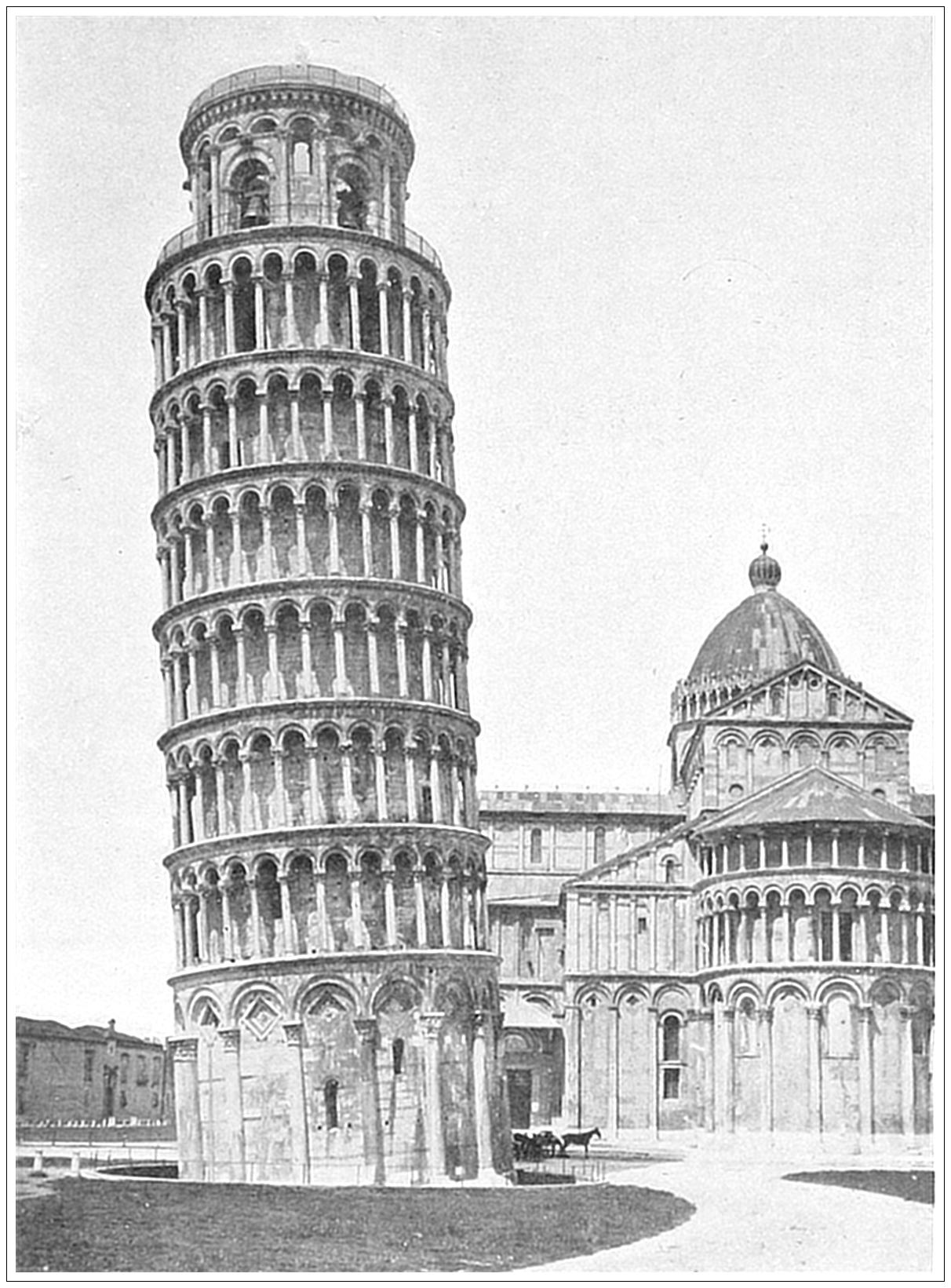
152
PONTE VECCHIO, FLORENCE, ITALY. There is no more picturesque bridge in the world than this. It spans the river Arno at a point where tradition asserts that a Roman predecessor used to exist. Certain it is, that bridges were built here and repeatedly demolished before Taddeo Gaddi erected the present structure of three arches. It is flanked by shops, which have belonged to the goldsmiths and jewelers since the fourteenth century, and is still the centre of their trade. Above the roofs of these shops runs the gallery of the Grand Duke, built as a secret passage between the Uffizi and the Pitti Palaces. The bridge itself might easily be mistaken for a continuous street by the stranger, except for the vacant space over the central arch, which gives a glimpse of the city and the river on each side.
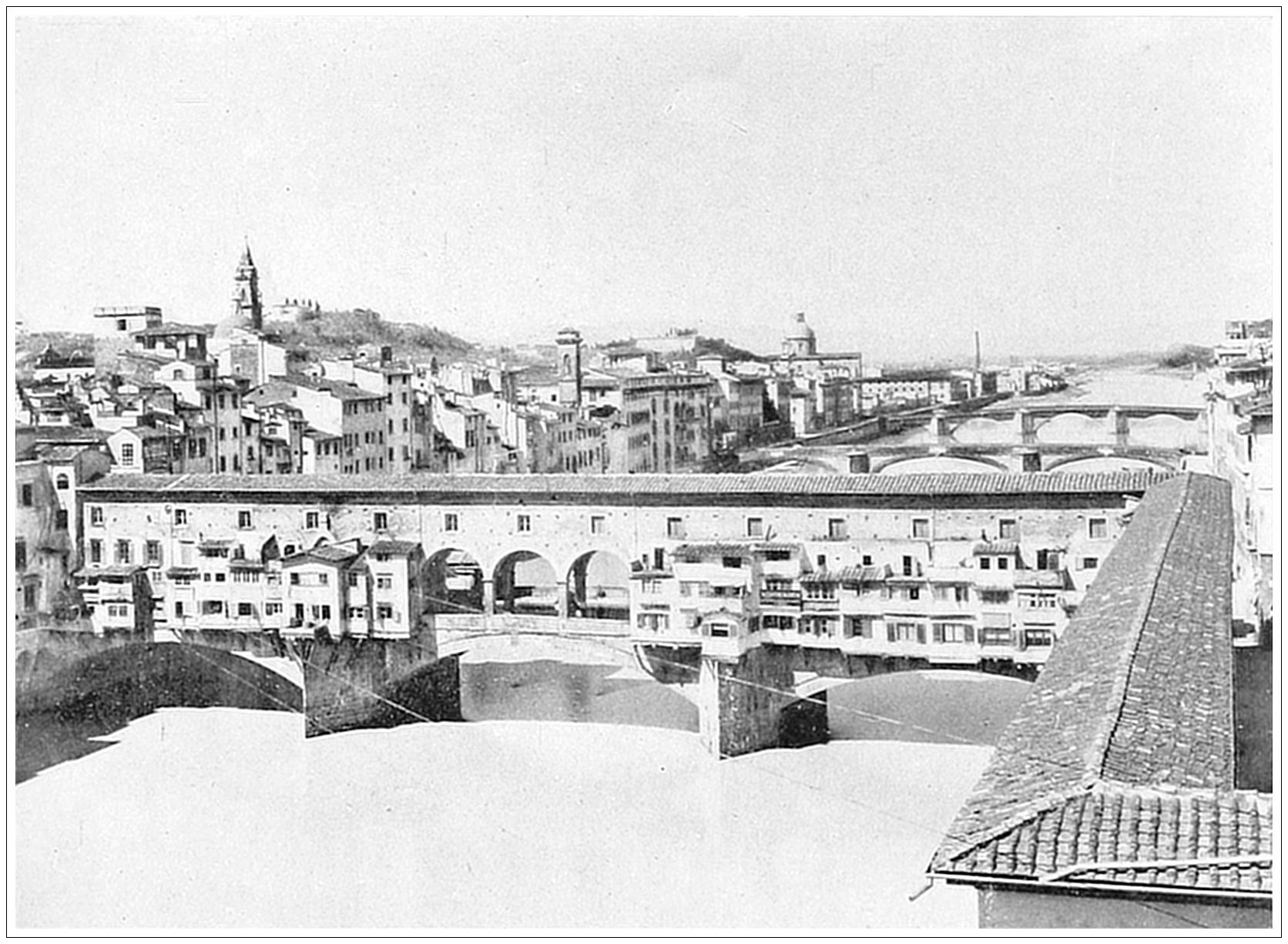
154
PALAZZO VECCHIO, FLORENCE, ITALY. The ancient capitol of the Republic of Florence, and subsequently the residence of Cosmo de’ Medici, is known as the Palazzo Vecchio, or Old Palace. Begun in 1298, it is a striking example of the Florentine castles of the Middle Ages, with its enormous projecting battlements and its disproportionate bell tower, defiantly stuck upon the walls without regard to symmetry, and almost overhanging the battlements. It is situated in the Piazza della Signoria, the historic, as well as the commercial, centre of Florence. The court is adorned with a fountain and sculptured columns. In front of the entrance is Bandinelli’s group of Hercules and Cacus. At right angles to the left is the Loggia dei Lanzi, an open arcade, famous for its own beauty and for the sculptured master-pieces which it enshrines. A large and elegant fountain is on the right.
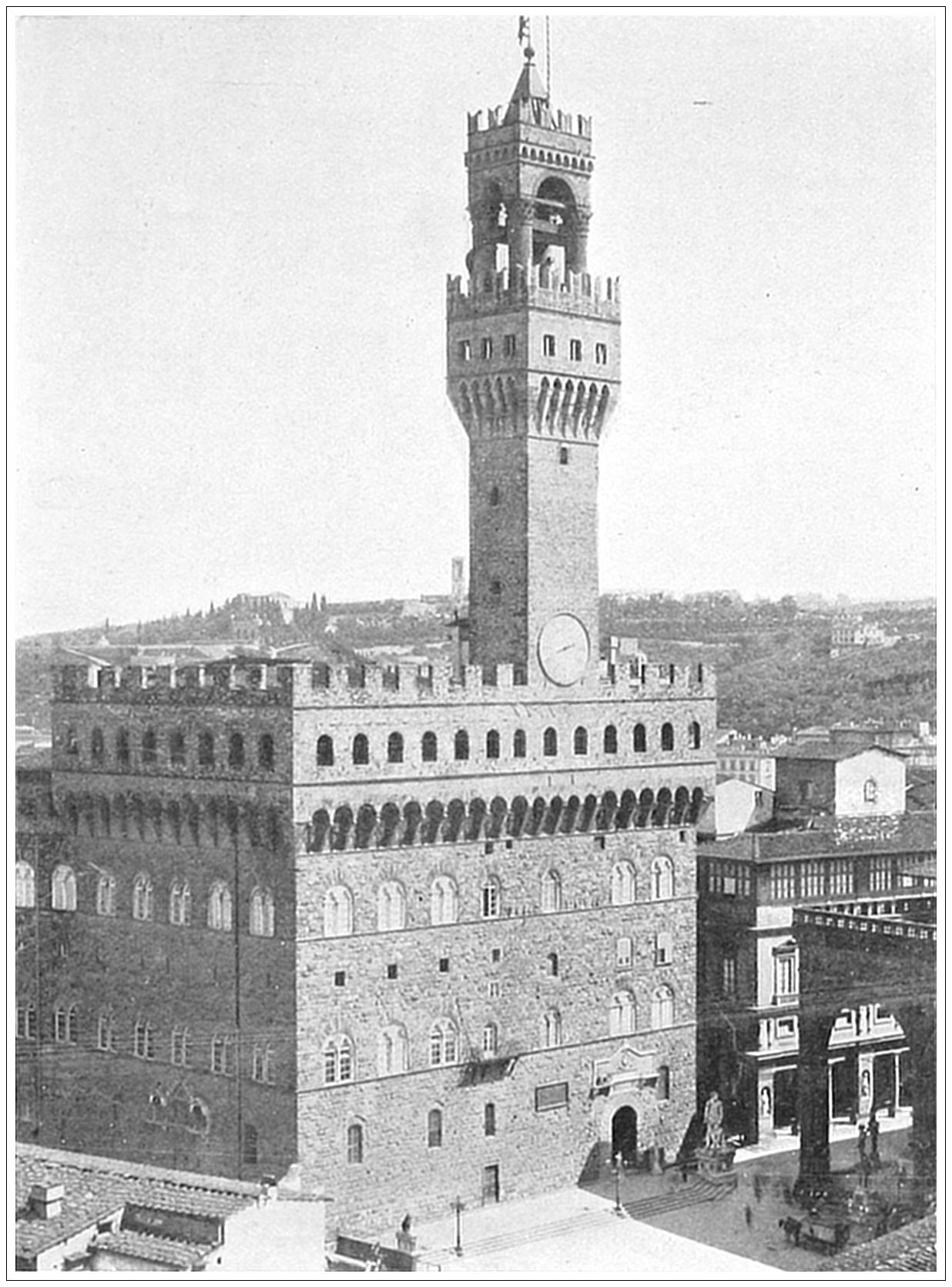
156
CATHEDRAL OF FLORENCE, ITALY. This is generally known as the Duomo or Dome, though its official designation is Santa Maria del Fiore. Arnolfo di Cambio began it in 1298; he was succeeded by Giotto, and the dome was added by Brunelleschi. The latter is not only beautiful in itself, but is interesting as the first of the great domes of the modern world. A half-finished façade was destroyed by fire, and the deficiency was not supplied until 1875–1884. The interior is impressive, though almost entirely devoid of ornamentation. Outside the church, to the left, is the Campanile, an exquisite work by Giotto; so exquisite that Charles V declared it ought to be kept in a glass case. In front is the Baptistery, an octagonal building, surmounted by a dome. It was begun in 1352 and finished in 1358. Its chief attraction lies in the bronze doors, especially those by Lorenzo Ghiberti, which Michael Angelo eulogized as worthy to be the gates of Paradise.

158
THE CAPITOL, ROME, ITALY. Anciently, the Capitoline Hill, in Rome, was surmounted by the Temple of Jupiter Capitolinus and the citadel of the city. Hence, here was the head of the Roman state and the shrine of their religion. But temple and citadel have vanished and in their place is a group of buildings erected by Paul III from the designs of Michael Angelo. On the right is the Palace of the Conservatori, on the left the Museum of the Capitol and between the two, occupying the third side of the square, is the Palace of the Senator, a modern Roman patrician with that title. The photograph shows the best approach to the square up the grand stair-case, known as La Cordonnata, which in its present form dates from 1736. At the foot of the stairs are two Egyptian lions, and at the summit, on the angles of the balustrades, two ancient colossal statues of Castor and Pollux, standing by the sides of their horses. These were found in the sixteenth century. In the centre of the square is the bronze equestrian statue of Marcus Aurelius.
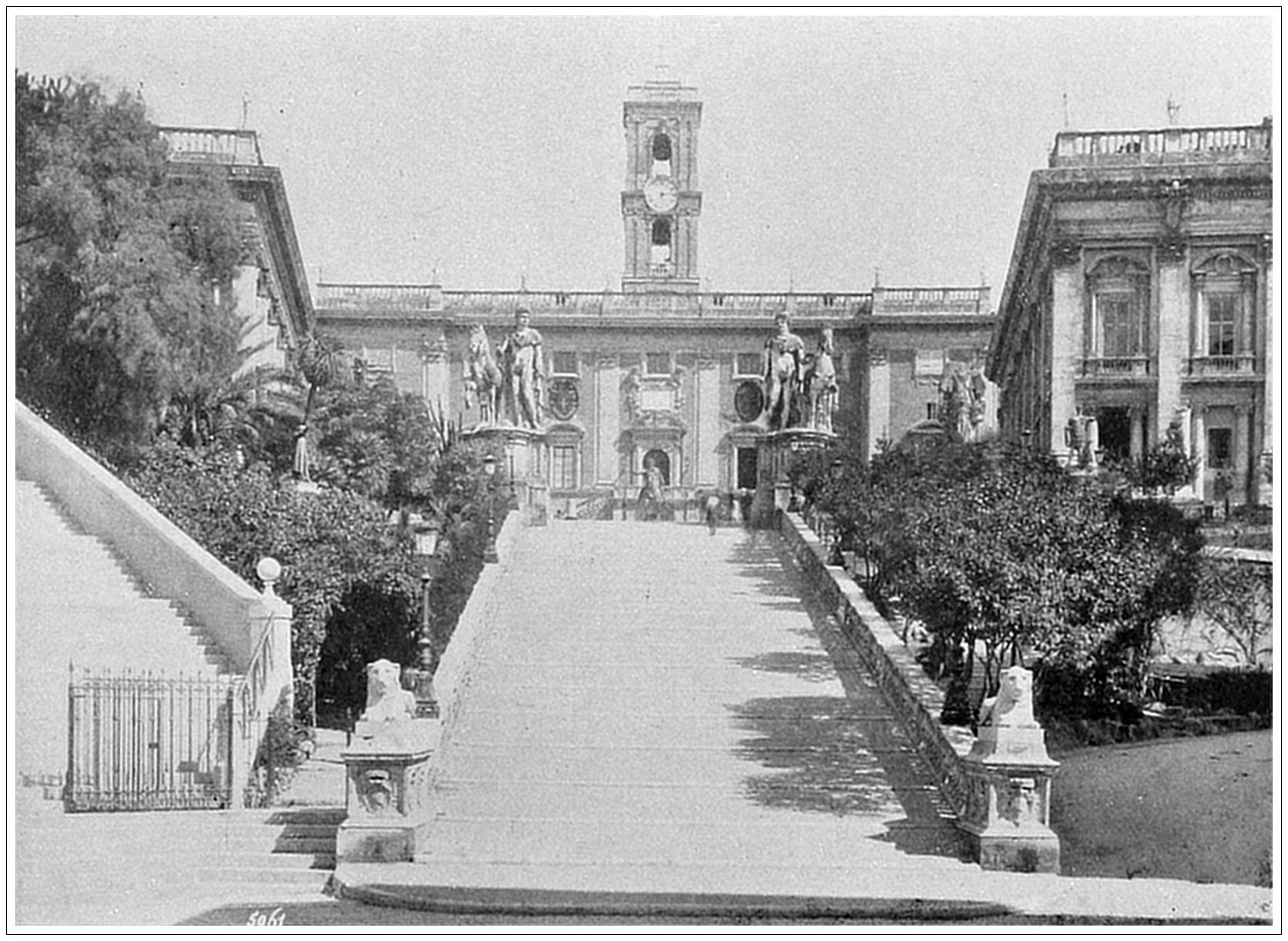
160
CASTLE OF ST. ANGELO, ROME. Originally this famous structure was built by the Emperor Hadrian as a mausoleum for himself and his family. The same emperor also erected the bridge now known as St. Angelo—anciently as the Pons Ælius—which crosses the Tiber opposite the castle. Tradition affirms that Gregory the Great in 589 changed the name in memory of a vision of the Archangel Michael, who appeared to him standing on the summit of the mausoleum. He built a chapel on the summit, but subsequently this was replaced by the statue still extant. During the Middle Ages this was the fortress of Papal Rome, and its history at that period is bound up in the history of the city itself. It has also served as a prison, and part of it was up to recent times still used for that purpose. It has suffered much from sieges and the ravages of time, and is now but the skeleton of the magnificent pile erected by Hadrian. No vestige remains of the shell of Parian marble which encircled it, while the statues were torn off to be used as missiles against the Goths, and later as cannon balls.
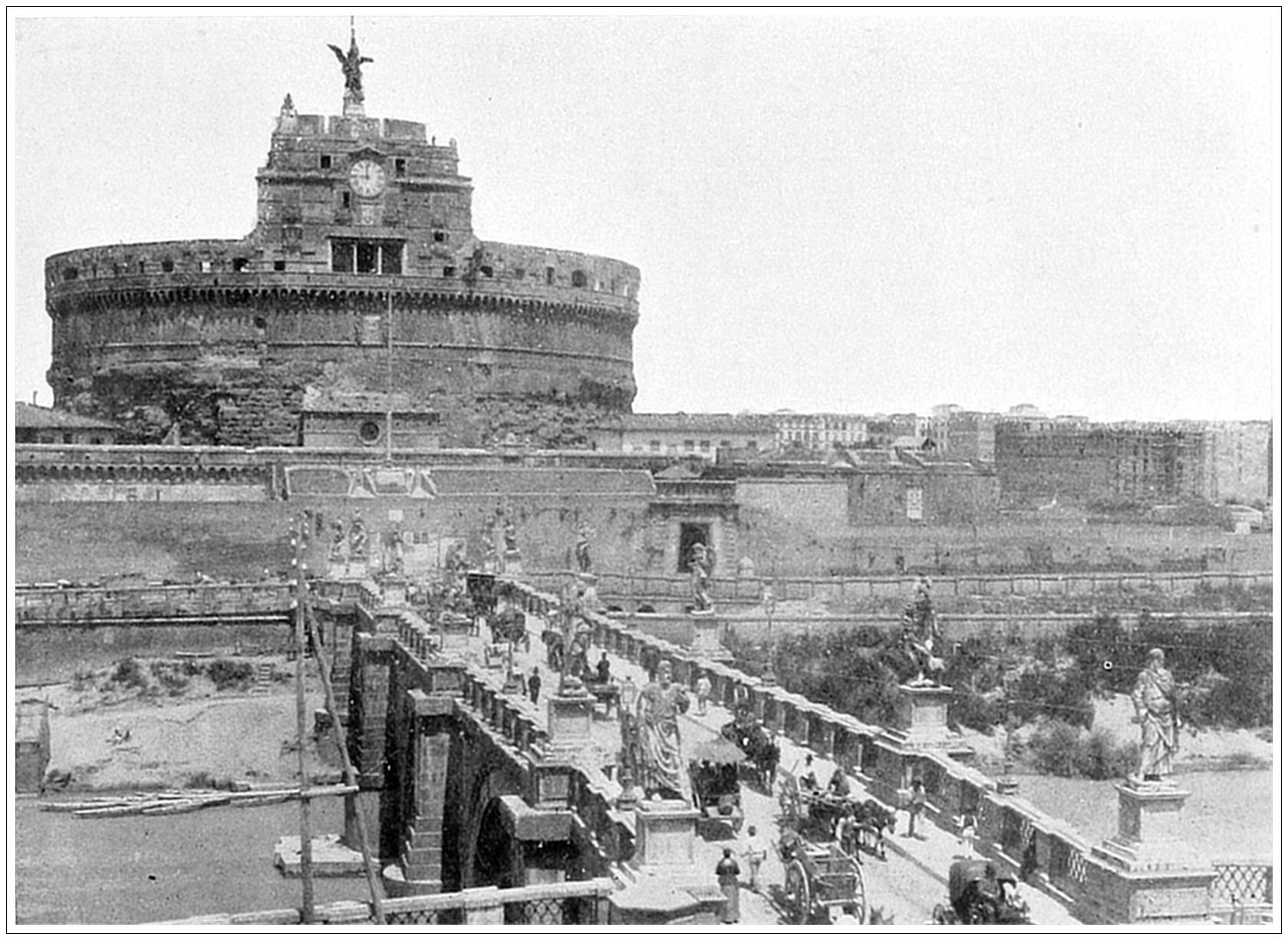
162
ST. PETER’S, ROME, ITALY. This is the largest and most magnificent of all Christian temples. It is built on the supposed site of the burial-place of St. Peter. As early as A. D. 90 an oratory was raised on the spot; in 306 this was followed by a basilica. The present edifice was begun in 1506, and after employing the talents of Bramante, Michel Angelo and other architects, was dedicated by Urban III in 1626. The magnificent dome was mainly the work of Michael Angelo, though his plan was somewhat modified by Giacomo della Porta. The impressive colonnades, which almost encircle the square and lead up to the front, were added in 1667. The façade is confessedly a failure. But nothing can mar the beauty of this extraordinary edifice. Although it occupies some two hundred and forty thousand square feet, the interior, from its exquisite proportions, does not at once impress the beholder with a sense of its vastness. That grows upon one by degrees. The Vatican, which adjoins St. Peter’s, is an equally enormous and beautiful building, which comprises the residence of the popes, an astounding museum of pictures and statues and a library of unexampled historic interest.
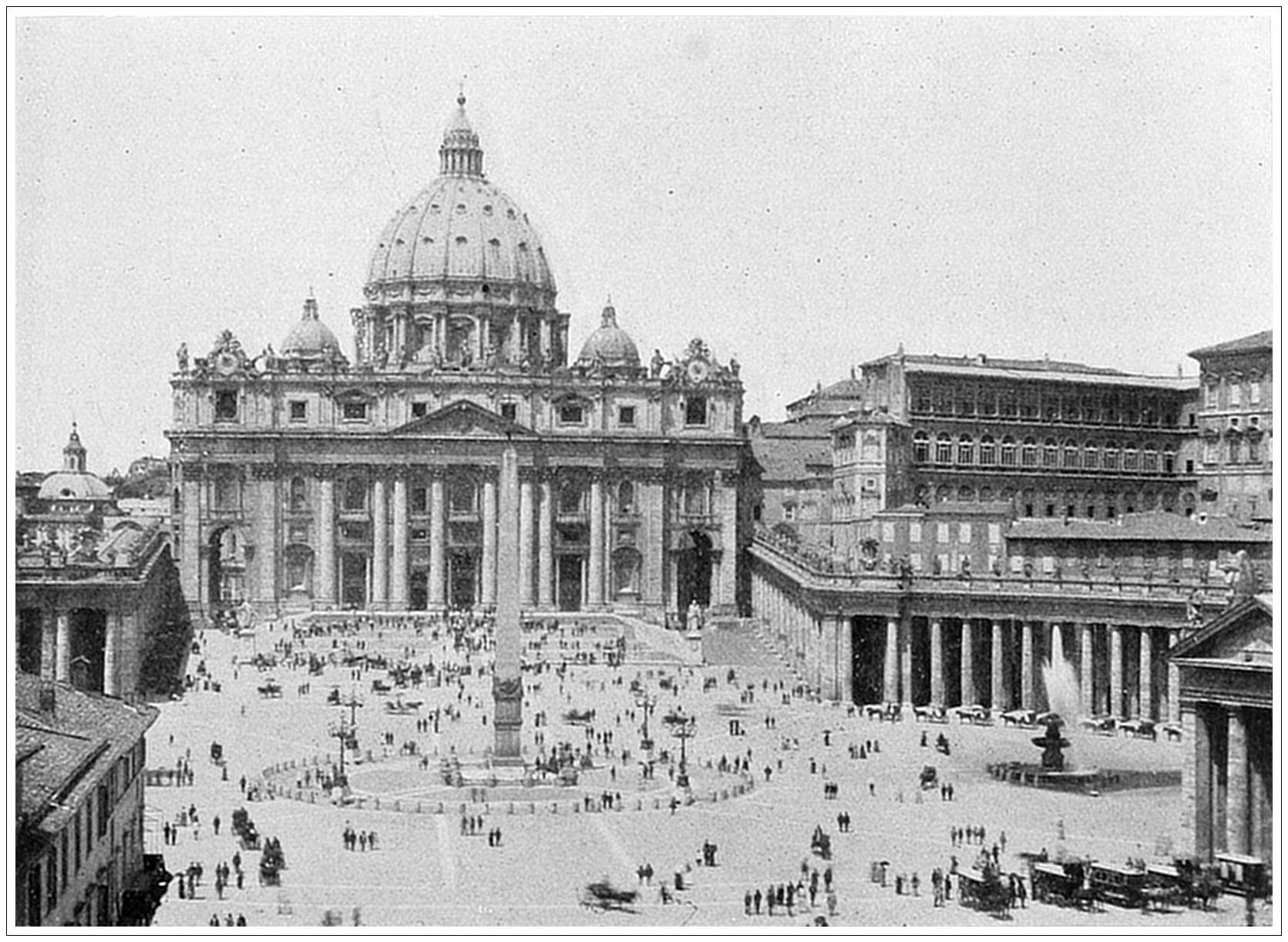
164
THE COLOSSEUM, ROME. This mammoth ruin, originally known as the Flavian amphitheatre, is the most magnificent relic of ancient Rome. Begun by Vespasian in A. D. 72, it was dedicated by Titus in A. D. 80 and was subsequently added to by Domitian. As the circus of the public games for nearly four hundred years, it was the scene of gladiatorial conflicts and of the persecution of the Christian martyrs. After the triumph of Christianity it fell into neglect, and suffered continuous spoliation as a quarry for the material of new buildings. Finally, in 1750, Benedict XIV rescued it in its present condition by dedicating it to the memory of the Christian martyrs who had suffered therein. A cross in the middle of the amphitheatre is continually visited by the pious. “As it now stands,” says Forsyth, “the Colosseum is a striking image of Rome itself, decayed, vacant, serious, yet grand, half gray and half green, exact on one side and fallen on another, with consecrated ground in its bosom.” Hillard calls it “a great tragedy in stone.” It was originally built to seat ten thousand spectators. There were three orders of architecture used in the four stories; the first, Doric; second, Ionic; third and fourth, Corinthian. In each of the lower tiers there were eighty arches. The height of the outer wall was one hundred and fifty-seven feet, the circumference one thousand six hundred and forty-one feet, the entire superficial area being six acres.

166
THE PANTHEON, ROME. This is one of the grandest, as it is the most perfectly preserved, of all the ancient monuments of Rome. Except for the ridiculous belfries superimposed by Bernini on the outside, it is to-day substantially in the same condition as when Marcus Agrippa in B. C. 27, after the establishment of universal peace, consecrated it to all the gods. In A. D. 608 it was dedicated as a Christian church by Pope Boniface IV, under the name of Santa Maria ad Martyres. The portico is of faultless beauty, and the interior, as the picture shows, is a perfect rotunda, impressive in its grand simplicity. The domed ceiling is lighted solely by an aperture twenty-three feet in diameter, the wall being supported by a huge bronze ring. An additional interest for moderns lies in the tombs of Raphael, Caracci and other painters who are buried therein, and more recently the remains of Victor Emmanuel have been added to those of the artistic brotherhood.
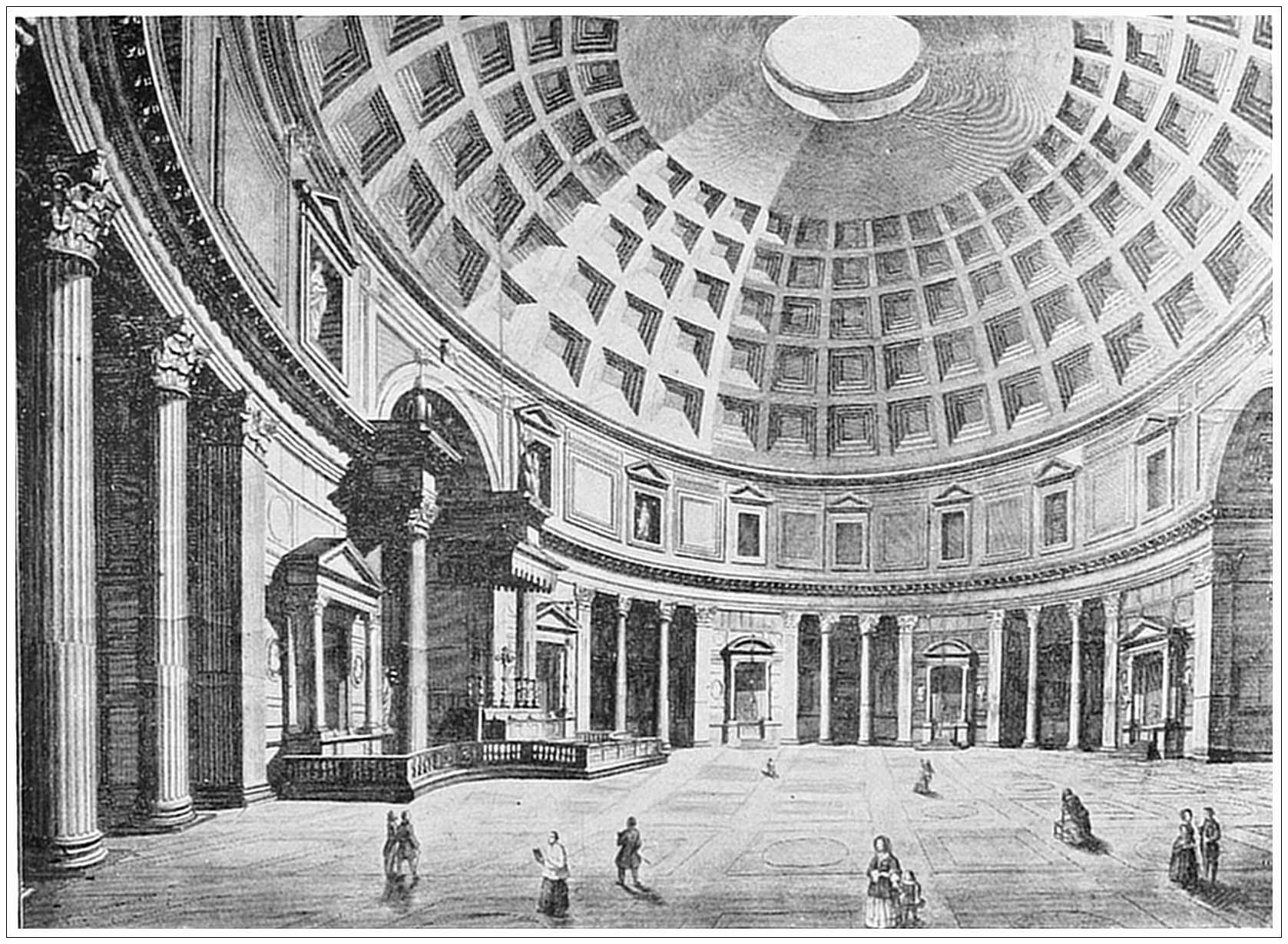
168
TOMB OF CECILIA METELLA, ROME, ITALY. The Via Appia of ancient Rome was one of the great avenues leading out from the city, and the principal line of communication with the South. It is named after Appius Claudius Caecus, the censor, who began its construction in B. C. 312. Under Pius IX the ancient road was once more laid open. To-day it presents the appearance of an avenue, eleven Roman miles in length, lined on each side by ruins, mostly of magnificent tombs, which were built by the patrician families of ancient Rome to the memory of their dead. The best preserved of these is the tomb of Cecilia Metella, the wife of Crassus, a circular tower seventy feet in diameter, resting upon a quadrangular base. The battlements upon it are mediæval additions, made for the purpose of defense by the Caetanis.
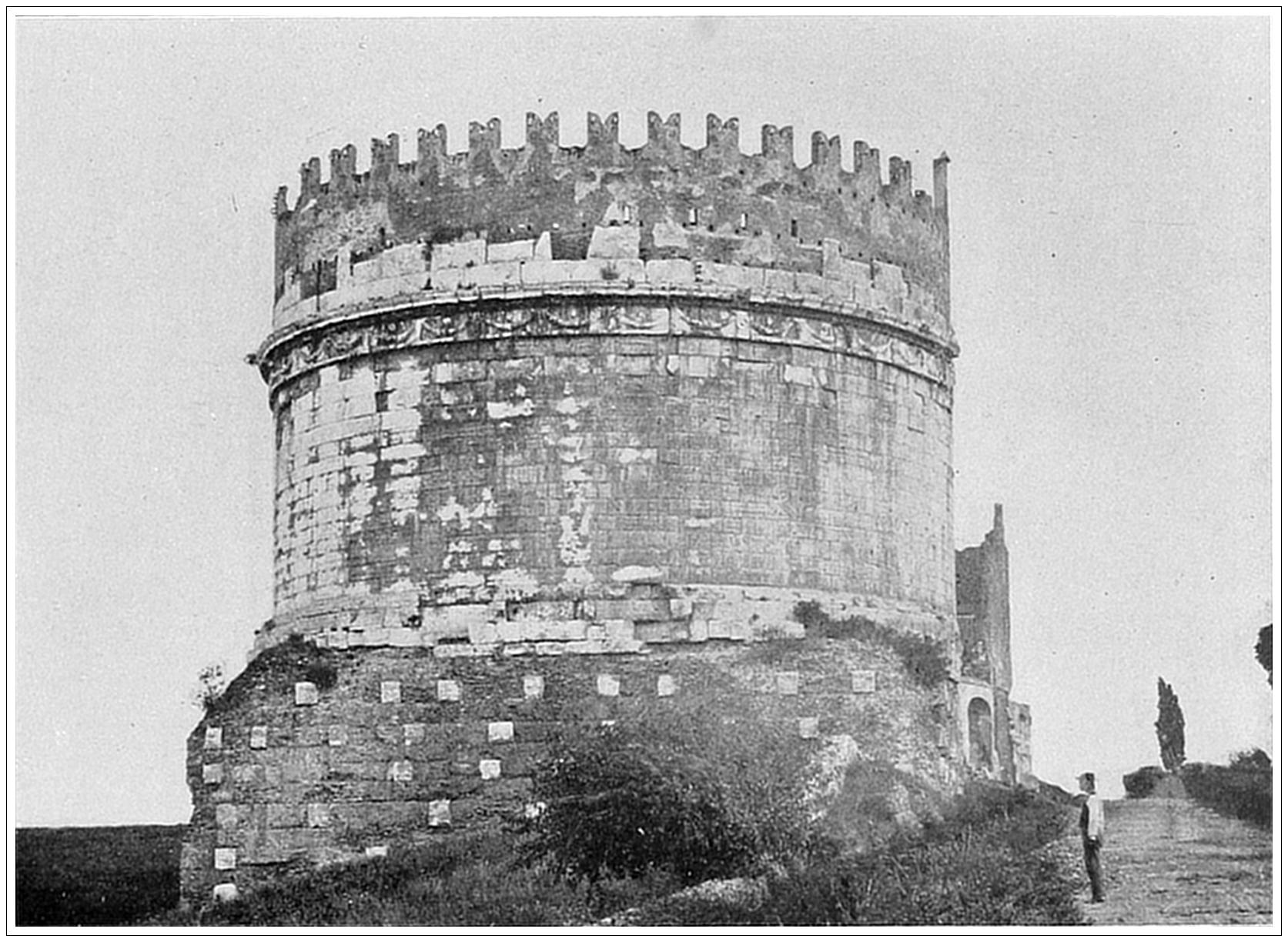
170
FORUM ROMANUM, ROME, ITALY. The ancient Forum of Rome exists only in ruins. That it lay at the foot of the Capitoline and Palatine Hills in Rome is certain from the remnants that survive. But the exact area it occupied and the true situation of the various buildings which once covered it are matters of dispute and uncertainty. Conspicuous among the ruins are three beautiful Corinthian columns of white marble belonging to the temple raised to Vespasian by Domitian; eight granite columns belonging to the Temple of Saturn, a beautiful fragment, consisting of three Corinthian columns with a rich entablature, a solitary column which Byron calls,
The nameless column with a buried base,
but whose now excavated base reveals that it was erected to the Emperor Phocas, the arches of Septimus Severus and of Titus, and a profusion of columns, pavements, foundations and walls of other structures.

172
BAY OF NAPLES AND MOUNT VESUVIUS, ITALY. Naples, in itself one of the least interesting of Italian cities, attracts the attention of the tourist by its transcendent beauty of situation and by the historical and picturesque interest of its surroundings. The Bay of Naples is the most glorious spot in the Mediterranean. Its circuit is more than fifty-two miles, including the islands of Ischia, at the north-west, and of Capri, at the south entrance. At its opening, between these two islands, it is fourteen miles broad, and from the opening to its head, at Portici, the distance is fifteen miles. On the north-east shore, east of Naples, is an extensive flat, whence rises Vesuvius, the most famous of European volcanoes, at the base of which are several villages and the classic sites of Herculaneum and Pompeii. The Italian proverb, “See Naples and die,” is a tribute to the beauty of the city and its environment.
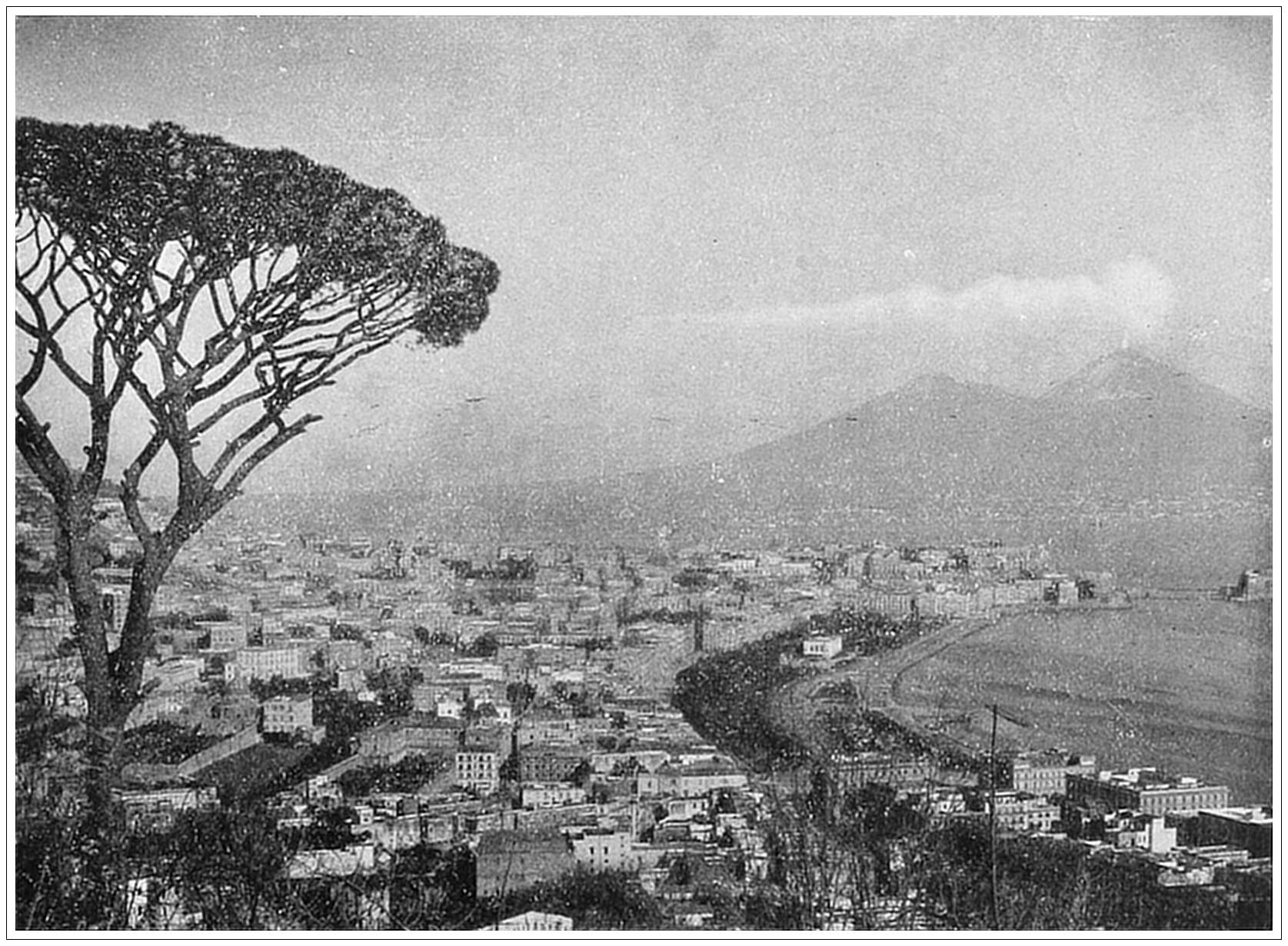
174
POMPEII, ITALY. The volcanic eruption which overwhelmed Pompeii on August 24th, A. D. 79, has afforded us our most important, indeed, almost our only source of acquaintance with the domestic life of the ancient Romans. To be sure it represents one definite epoch of antiquity only, that of the glories of the early empire when Pompeii became the favorite retreat of Romans of the wealthier classes. But the study of the various phases of life at this epoch forms a pursuit of inexhaustible interest. The ashes from Vesuvius completely covered over the town to the depth of about twenty feet until the year 1748, when the accidental discovery of some statues led to the excavations. They have been continued up to the present time, and will not be completed for half a century more.
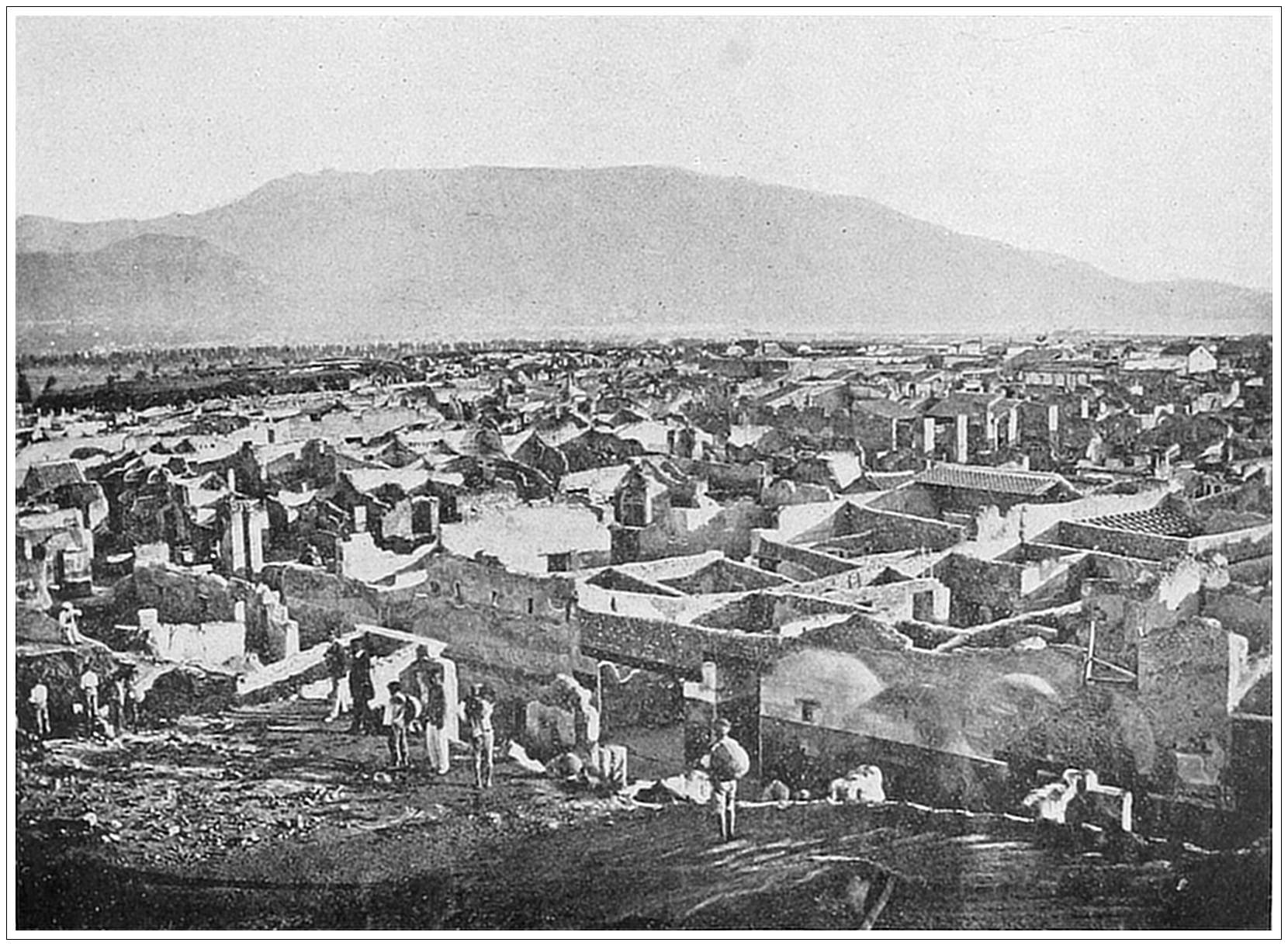
176
ACROPOLIS, ATHENS, GREECE. This famous building, at once the citadel, the sanctuary, the treasury and the museum of art of the ancient Athenian people, crowns the summit of the rocky height which abruptly rises three hundred and fifty feet out of the plain in the midst of the city, inaccessible on all save the western side. The walls, built on the edge of the perpendicular rock, form a circuit of nearly seven thousand feet. These are of immense antiquity. They were founded by the Pelagians, and the work was continued by Themistocles, Cymon, Valerian, and later, by the Venetians and the Turks. Here are the remains of three temples, the Temple of Victory, the Erechtheum and the Parthenon, the latter the architectural glory of Athens, the only octastyle Doric temple in Greece, and in its own class the most beautiful building in the world. It was built in the time of Pericles, and was once adorned with masterpieces of sculpture of which it was long ago plundered.
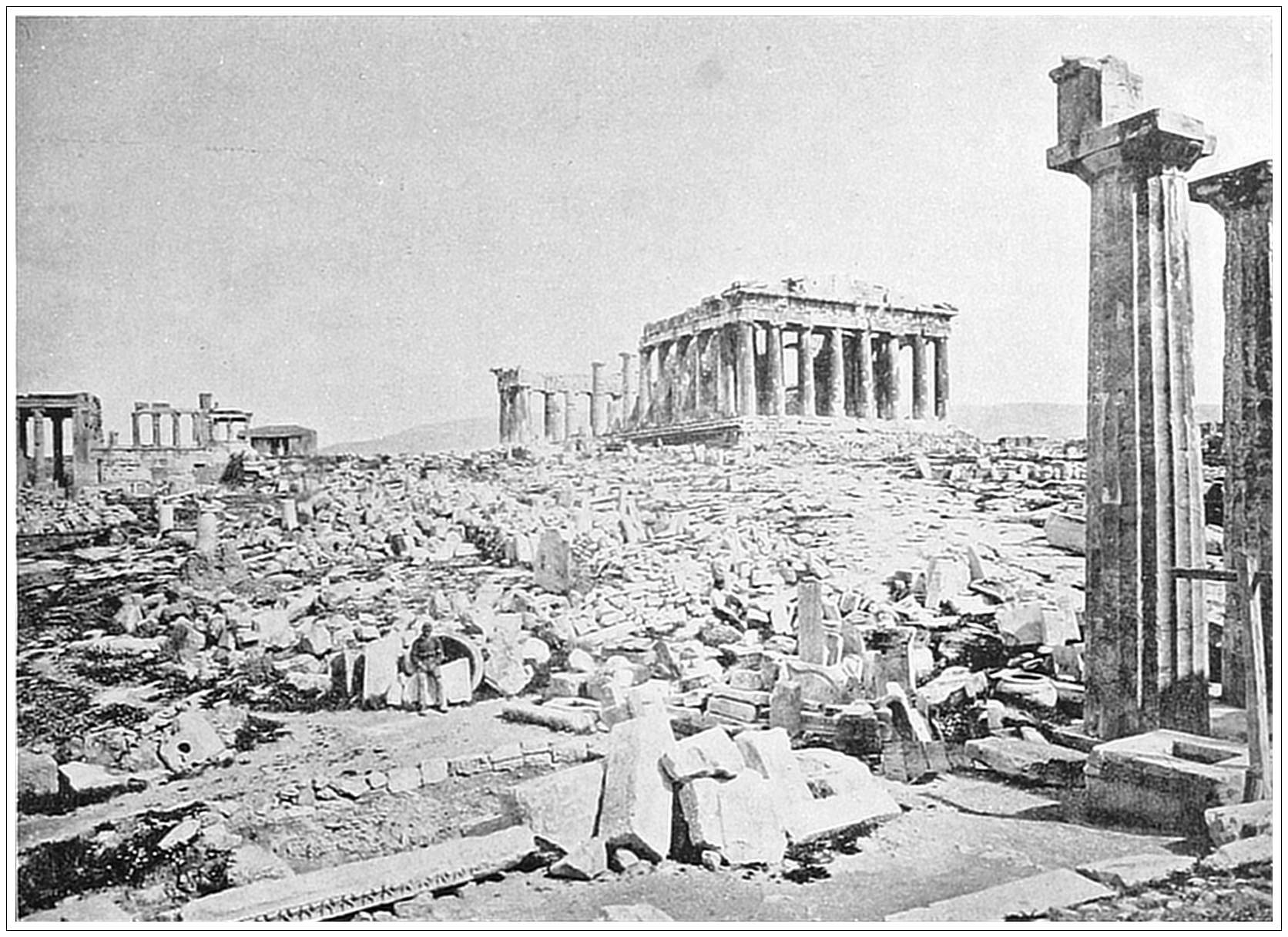
178
THE BOSPHORUS, FROM CONSTANTINOPLE, TURKEY. No city in the world occupies a more magnificent natural position than the capital of Turkey. It is made up of three cities, each distinct and different from the others. Stamboul, the old city, lies upon a tongue of land of triangular shape, having the sea of Marmora on the south, the Bosphorus on its eastern apex and the Golden Horn on the north. Its seven hills are crowned with domes and minarets and fantastic houses, backed by the dark foliage of the cypress and other trees in the cemeteries beyond the walls. To the north is the European quarter, Galata being the business centre, while Pera is studded all over with the splendid residences of the foreign ambassadors, &c., and lined along its shores with the palaces and gardens of the Sultan and the adjoining mosques. Skutari, the Asiatic quarter of Constantinople, is on the eastern side of the Bosphorus. Nowhere else is there a picture so bright, so varied in outline, so gorgeous in color, so heterogeneous in its component parts.

180
THE MOSQUE OF ST. SOPHIA, CONSTANTINOPLE, TURKEY. This is the principal place of Mahommedan worship in the world. Anciently a Christian temple, built in 532 by Justinian, it was converted into a Moslem mosque in 1453 by Mohammed II, the conqueror of Constantinople. The building is in the form of a Greek cross, two hundred and seventy feet long by two hundred and forty-three wide, surmounted by a flattened dome one hundred and eighty feet high, with several smaller domes and minarets. The style of architecture is Byzantine. The exterior is not as imposing as the interior, which even now is rivaled by few Christian churches, and at the time of its erection made this masterpiece of Byzantine architecture the greatest temple in the world. Well may Justinian have exclaimed: “I have surpassed thee, O Solomon!” The changes made by the Moslems are greater inside than out. In the interior the mosaics have been partially covered up and replaced by inscriptions from the Koran, but there is no structural change. Outside most of the older annexes have been swept away and replaced by Turkish buildings, lofty minarets rise at each corner, and the crescent replaces the cross on the dome.

182
THE SPHINX, EGYPT. This unique monument, situated near Cairo, in the neighborhood of the Pyramids, is one of the most characteristic and probably the oldest of Egyptian remains. As such it is the oldest monument in the world. Recent researches show that it is more ancient than even the Pyramid of Cheops. Originally it was a recumbent figure, representing an andro-sphinx, or man-headed lion, one hundred and eighty-eight feet nine and one-half inches in length, hewn out of the solid rock. Steps led down to its front, where there was a sanctuary and tablets. But the sands covered all save the head, shoulders and back, which rose from the surrounding desert with a startling and almost fearsome abruptness. In this condition the monument was allowed to remain for centuries. But more recently excavations have been started to restore it to its pristine state, and before long the entire colossal figure will be bared to view.

184
PYRAMIDS OF GIZEH, EGYPT. Gizeh is about twelve miles from Cairo. It contains the largest and most famous of those mysterious sepulchral monuments known as Pyramids, which the ancient Egyptians were fond of raising. Three of these are especially famous—the Great Pyramid called the “Splendid,” which is the mausoleum of Cheops, and is four hundred and fifty feet nine inches high; the scarcely inferior Pyramid of Chepheren, and the Pyramid of Mycerinus, which is much smaller. These mountains of masonry, built of stones whose huge size perplexes modern engineers to account for the method of their handling, were designed by the kings of the early Egyptian dynasties as their tombs. Their leading idea was durability, and by concealment of the entrance, and tortuous and complicated passages, they strove to baffle the vandal. Yet all these tombs have been shamefully profaned.

186
RUINS OF KARNAK, EGYPT. Most guide-books advise the traveller in Egypt to leave Karnak to the last, as the crown of his explorations. It is, indeed, the most marvelous ruin along the Nile. Yet, though in ruins, it preserves all its original character. It lies amid the ruins of Thebes. It was intended for a temple. But it is not so much a temple as a city of temples, of palaces, courts, columns and obelisks enclosed by a great wall of circuit about a mile and a half in circumference. The Great Hall alone, which is the largest of all the monuments, measures three hundred and forty feet by one hundred and seventy. The Temple of Amenophis, here represented, is one of the finest of the smaller remains.

188
CHURCH OF THE HOLY SEPULCHRE, JERUSALEM. This church, situated on a hill called Acra, purports to be built over the site of Calvary and the actual tomb of Jesus. Not only that tomb itself, but the tombs of Joseph and Nicodemus, the places where the Saviour appeared after His resurrection to Mary Magdalene and to Mary, His mother; where Constantine’s mother found the true cross, &c., &c., are pointed out to visitors. Not everybody accepts the genuineness of the site. But, at least, it was for the reconquest of the Holy Sepulchre that the Crusades were instituted, and for fifteen hundred years kings and queens, knights and pilgrims have knelt and prayed here. The church is a Byzantine structure, which was commenced in 1103 A. D., was partly destroyed by fire in 1808, and has since been restored. Some parts of it, however, are said to date back to the Empress Helena.
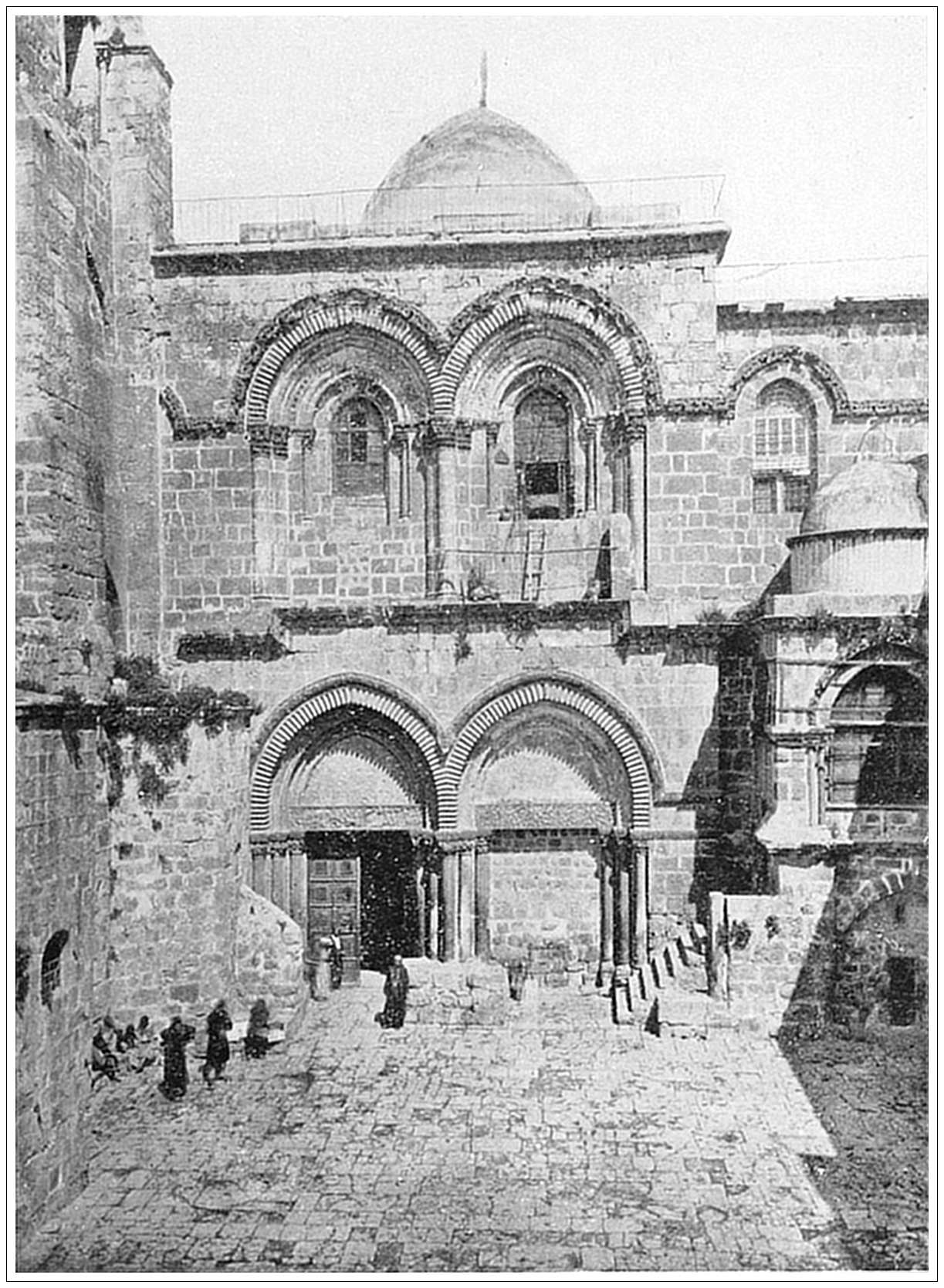
190
GARDEN OF GETHSEMANE, JERUSALEM. No spot in the whole world could have more interest for the Christian traveler than the Garden of Gethsemane, the scene of our Lord’s agony on the eve of His crucifixion. It is known that it was a garden or orchard belonging to a small estate at the foot of Mount Olivet, somewhere on the east slope of the Kedron Valley and about half a mile from Jerusalem. But whether the present enclosure which is pointed out as the identical garden be so or not is a matter which archæologists have not yet settled. Certainly, the garden is very old and very venerable; its few olive trees date back to an unknown antiquity, and it may very well have been extant in almost its present condition in the time of Christ.
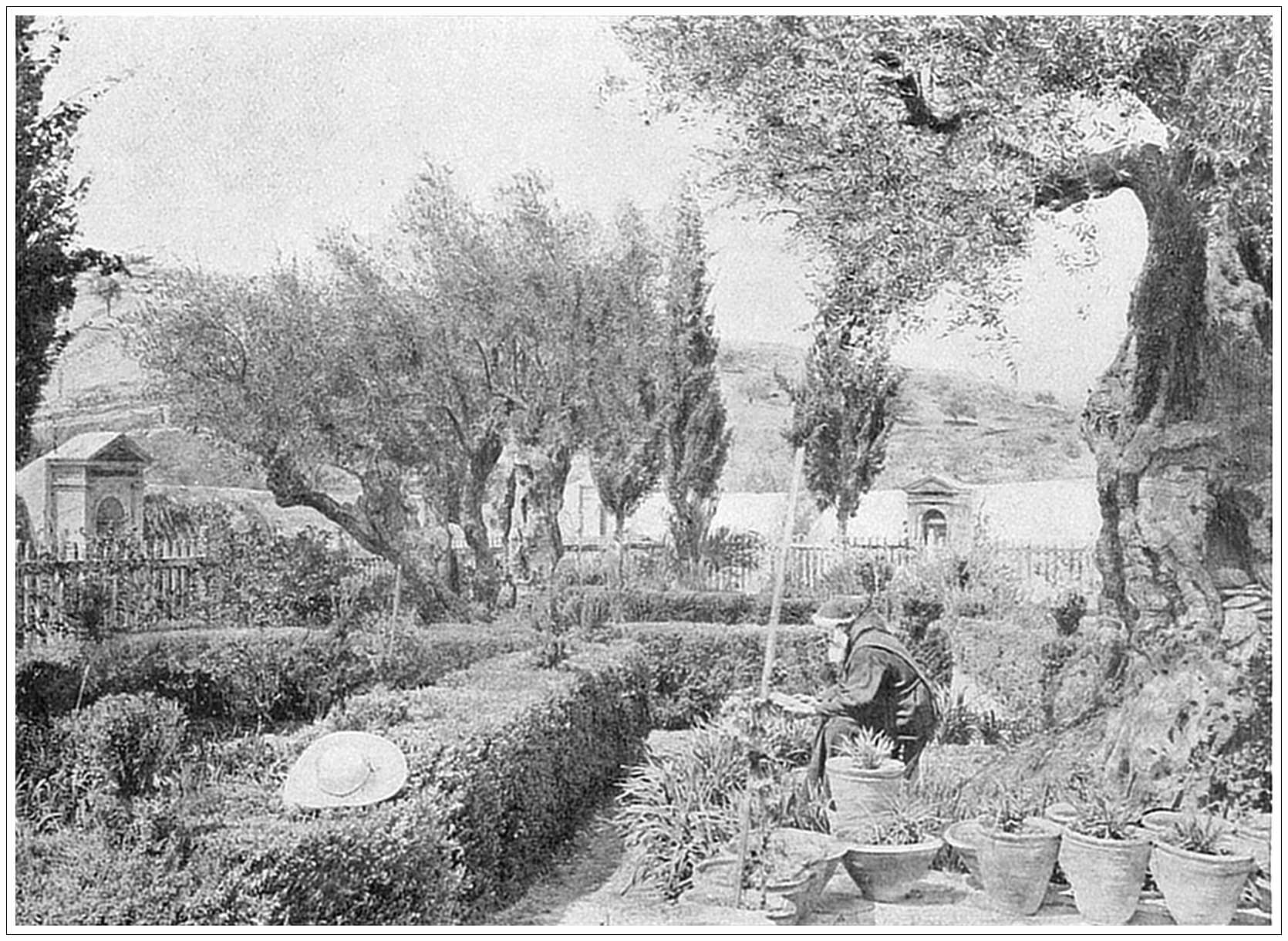
192
RUINS OF BAALBEK, SYRIA. Baalbek,—the city of Baal or the Sun, the Heliopolis of the Greeks, once famous as the most magnificent of Syrian cities, which passed successively under the rule of the Persians, Greeks and Romans, was plundered by the Arabs in A. D. 639, by the Christians and others during the Crusades, and was finally sacked and dismantled by the Tartars, under Tamerlane.—Baalbek to-day exists only as a mass of ruins; but its very ruins are of the utmost magnificence. The most imposing are the remains of the Great Temple. But the most beautiful is the Circular Temple—a semi-circular cella surrounded on the outside by eight Corinthian columns. Within there is a double tier of smaller pillars, the lower row being Ionic and the upper Corinthian. In modern times, and, indeed, up to the present century, this was used as a Greek church, but it is now deserted and choked with débris.

194
TAJ MAHAL, AGRA, HINDOSTAN. This magnificent mausoleum is the glory of Indo-Mussulman architecture. It was built by the Emperor Shah Jehan for himself and his favorite wife, Nourmahal, who died in child-birth in 1629. For twenty-two years twenty thousand men were employed in its construction, the total cost reaching $16,000,000. Built of white marble, it forms a quadrangle of one hundred and ninety square yards, surmounted by a lofty dome, with smaller domes at each corner and four graceful minarets one hundred and thirty-three feet high. The great central hall is paved with squares of various-colored marbles, while the walls, tombs and screens are ornamented by exquisite mosaic work. The elegance and delicacy of the design and the elaborate perfection in every detail of the workmanship are alike marvelous. It seems almost like a castle built in a dream, a fabric of mist and sunbeams, which would dissolve at a touch. Yet it has resisted the encroachments of time and the barbarian despoiler, and has come down to our day almost perfect.

196
PEARL MOSQUE, AGRA, HINDOSTAN. The very name of the building is a tribute to its beauty. It is undoubtedly the most elegant mosque of Indian-Mahometan architecture. Although it gives the general impression of lightness, grace, delicacy, it is by no means a small building. Externally it is two hundred and thirty-five feet east and west by one hundred and ninety feet north and south. The court yard is one hundred and fifty-five feet square. The mass is also considerable, as the whole is raised on a terrace of artificial construction, by the aid of which it stands well out from the surrounding buildings. Its chief beauty consists in its court yard, which is wholly of white marble from the pavement to the summit of its domes. The interior is a bewildering maze of columns of exquisite proportions.

198
EL CAPITAN, YOSEMITE VALLEY, CALIFORNIA. The Yosemite Valley is one of the most marvelous natural parks in the world. About nine miles in length and from three-quarters of a mile to a mile and a quarter in width, it is sunk almost a mile below the level of the surrounding country. High granite walls rise sheer and inaccessible on each side. Cataracts of the wildest and strangest beauty abound. Flowers of every hue cover the ground. Where all is wonderful it might seem hard to select. Yet by common consent the surpassing feature of the valley scenery is the great cliff, known as El Capitan or The Captain. “It is doubtful,” says Professor J. D. Whitney, “if anywhere in the world there is presented so squarely cut, so lofty and so imposing a face of rock.” Not indeed that it is the highest of the gigantic brotherhood. Its three thousand three hundred feet are exceeded in its own vicinity by over thousands of feet. But no other rock, here or elsewhere, has so majestic and awe-compelling a presence.
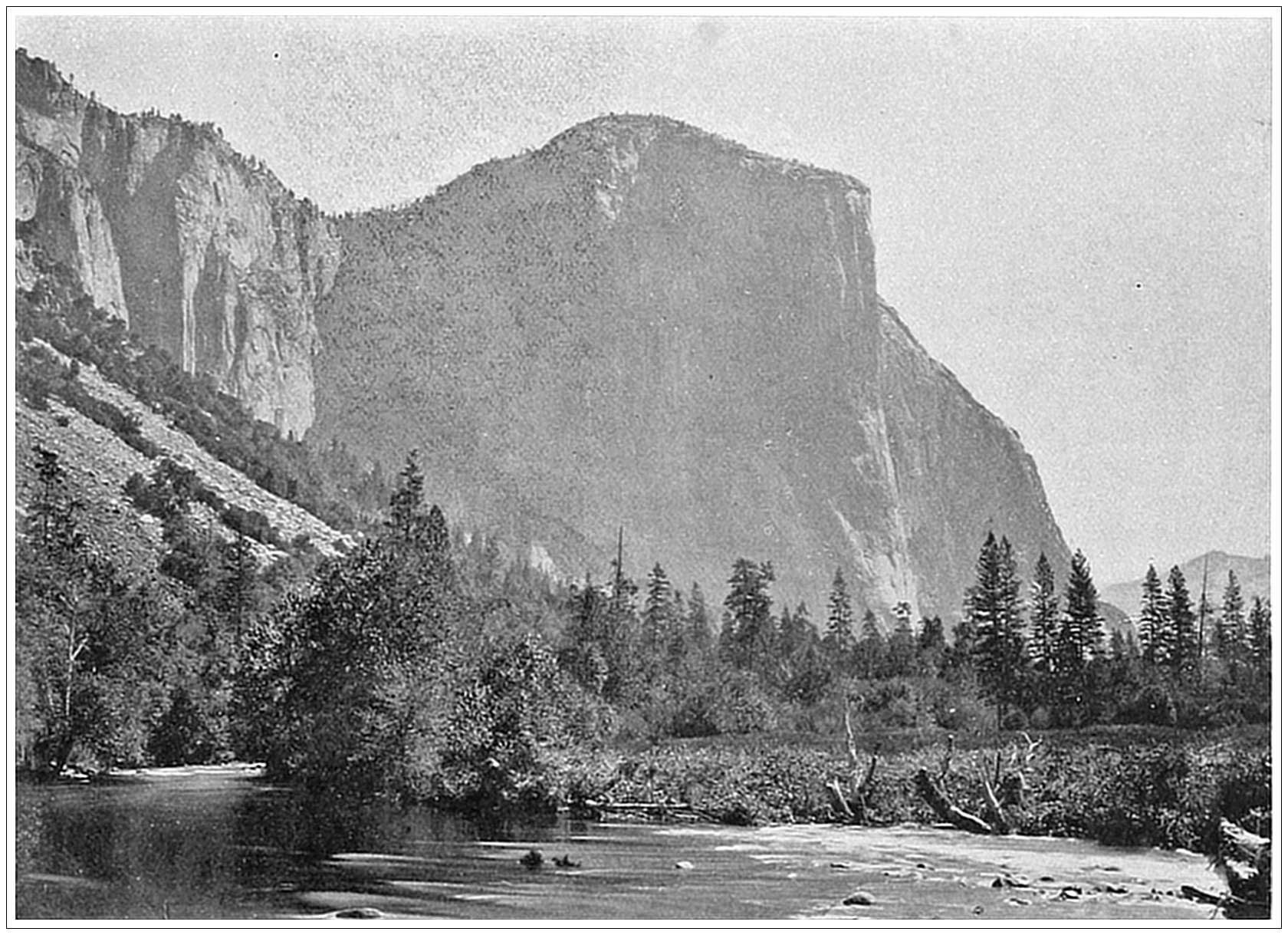
200
BIG TREES, CALIFORNIA. Rigid scientists call these trees Sequoia gigantea. In England they are sometimes known as Wellingtonia, in America as Washingtonia. But the pride of science and of patriotism have had to bow to the will of the populace, which has been satisfied with the simpler and therefore more energetic title of Big Trees. They are confined to the western portion of the California range, occurring in detached groups or groves at an altitude of from four thousand to five thousand feet above the sea. Some of these vast vegetable columns are upwards of thirty feet in diameter, and from three to four hundred feet in height. One of the trees in the Mariposa Grove, represented in the accompanying engraving—some twenty-five feet in diameter—stands directly arching the roadway, and a miniature tunnel has been cut through it which admits of the passage of a four-horse stage coach.
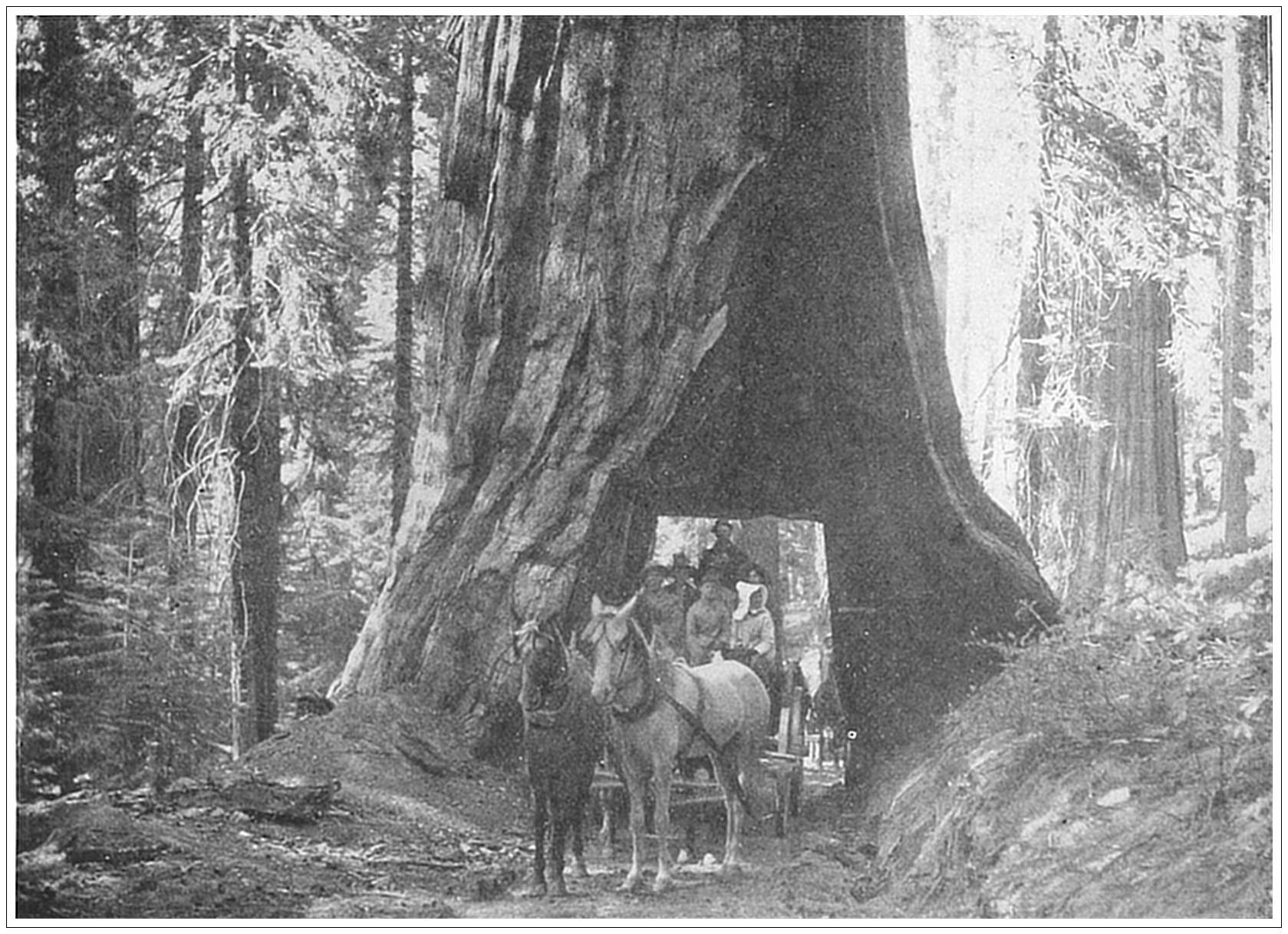
202
GEYSERS, YELLOWSTONE PARK, WYOMING. The Geyser region in the Yellowstone occupies some thirty square miles. Within this comparatively limited area is a most stupendous exhibition of hot springs, water geysers, mud geysers and steaming caldrons of boiling water. No two of the geysers are alike. The Grotto simply churns and makes a great noise. The others go off at various intervals; some every hour, some all the time and some once a month; some on alternate days, yet the day they are active going over ninety minutes. Nor is their style of action the same. Some play with labored pumping, others throw an unbroken stream; some wear themselves out in a continuous effort, others subside only to recommence again repeatedly. An eruption may extend from two to twenty minutes, the approximate time occupied by the Grand, or even to one hour and twenty minutes, a period that the Giant has been timed to play. The Grand is the largest geyser in the world, shooting a vast column of water over two hundred feet into the air.

204
GRAND CANON, YELLOWSTONE PARK. The Yellowstone Park is one of the great natural marvels of the world. Within a compass of one hundred square miles there are here gathered the loveliest valleys, the grandest canons, the most marvelous mountains, lakes, rivers, springs and cascades. In addition there are all sorts of natural phenomena: Sulphur mountains, a mud volcano, petrified forests and over ten thousand active geysers, hot springs, salfataras and boiling pools. Greatest of all the sights is the Grand Canon, a ravine varying in depth from one thousand to two thousand feet. The shelving sides of precipitous crags slope down, presenting an endless variety of form and color, until they meet at the bed of the Yellowstone River, which flings itself impetuously along to meet the lake. “A great gulch let down into the eternities,” such is the opinion of De Witt Talmage on this miracle of nature.

206
CLIFF-DWELLINGS, NEW MEXICO. Cliff-dwellers is the name given to more or less savage people in the past who inhabited dwellings built on projections from the face of cliffs, or cut out of the solid rock. Sometimes the houses are four stories high, and divided into many rooms. Often they are not to be distinguished from the rest of the cliff. Such dwellings are found in various parts of the world, but nowhere are they so abundant and so interesting as in Arizona, New Mexico and California. It is generally supposed that the American cliff-dwellers were the ancestors of the Pueblo Indians. In some respects the cliff-dweller appears to have been better off than his modern descendants; the canon walls sheltered him from cyclones and the overhanging shelves of rock protected him from attack from above. A series of cliff villages, lining the walls of Walnut Canon, in Northeastern Arizona, for a length of five miles, was discovered in 1884.
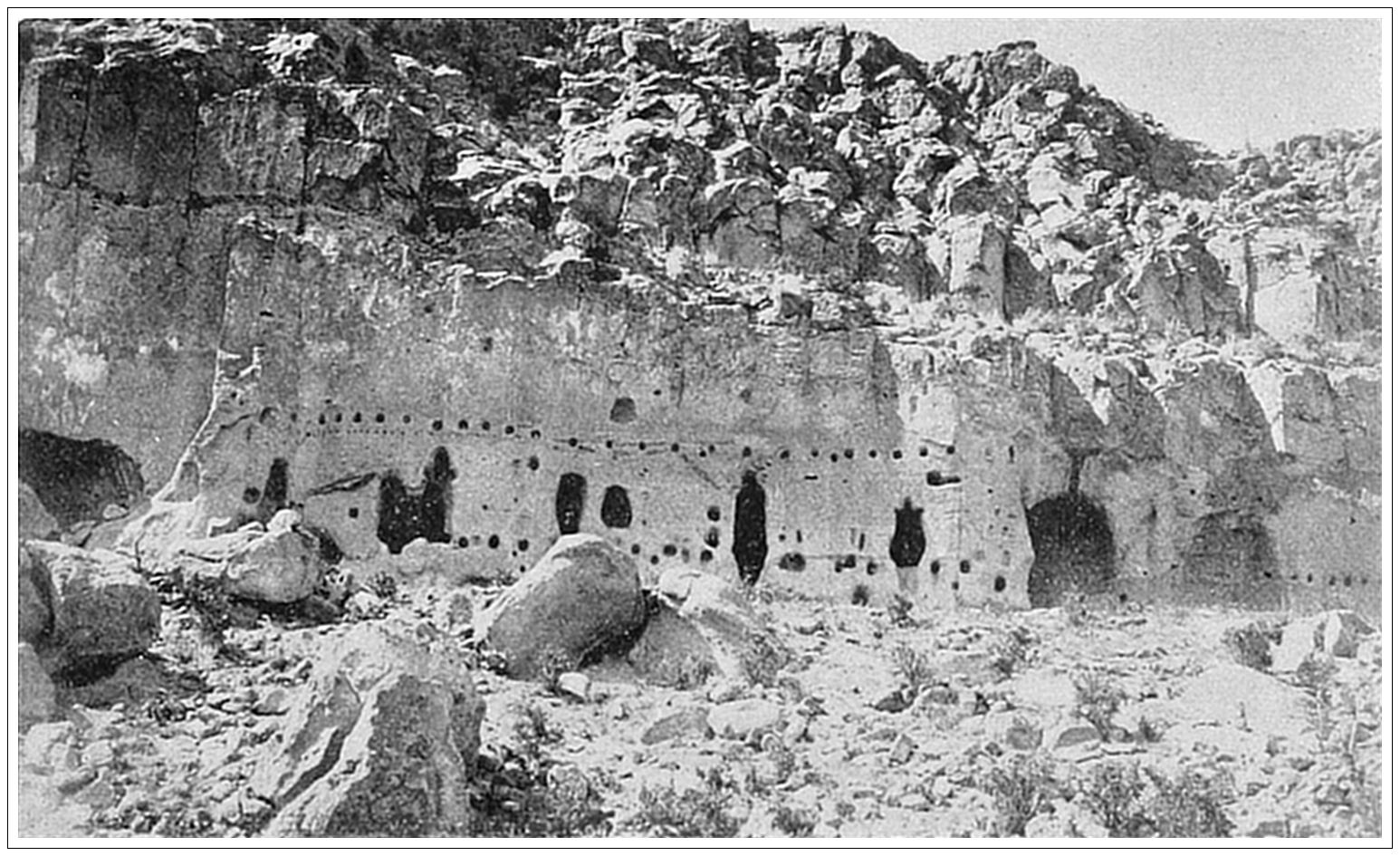
208
MASONIC TEMPLE, CHICAGO. For a long time it was held that Philadelphia had the finest Masonic Temple in the world. Now that honor belongs to Chicago. But it has only belonged to it since 1890, when the gorgeous new building was begun at the corner of State and Randolph Streets. The site measures one hundred and seventy feet on State Street and by one hundred and fourteen on Randolph. Every inch of this space is covered by the building, whose twenty stories tower up to the height of two hundred and sixty-five feet. It rests on cement and iron foundations, and its superstructure is of steel. The first three stories are faced with red granite from Wisconsin, the remainder with gray brick that is indistinguishable from the granite. An immense granite arch in the centre of the State Street front forms the entrance, and opens into an interior court, faced from bottom to top with different colored marble. The first eleven stories are fitted up for shops, from the eleventh to the sixteenth inclusive are business offices, while above the sixteenth floor everything is devoted to Masonry.
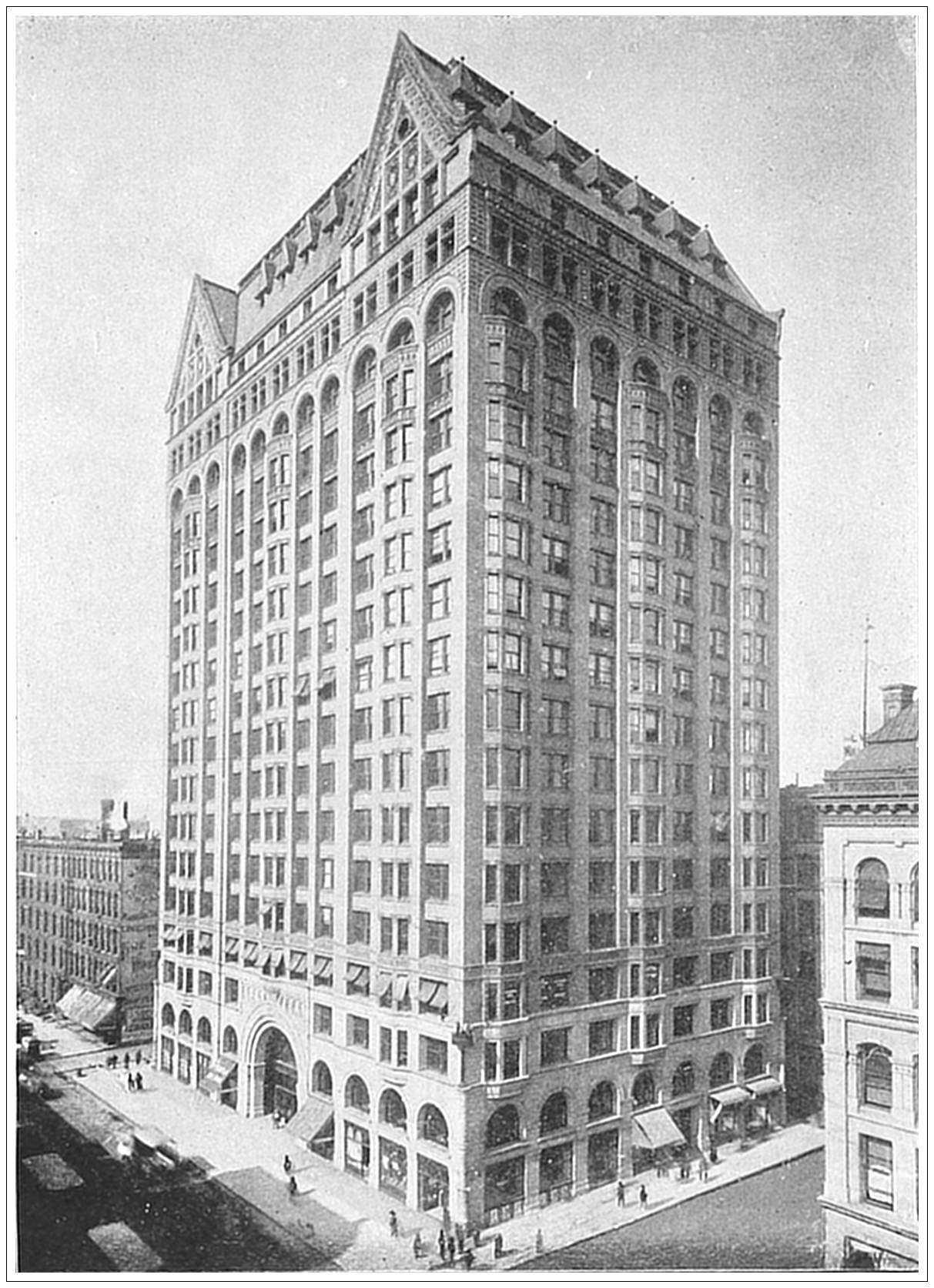
210
NIAGARA FALLS. The most stupendous cataract in the world is that formed in the Niagara River, four miles below Grand Island. Here the current begins to grow narrow and develops into rapids, which continue for about a mile, with a descent of fifty-two feet, until the river plunges over a mighty chasm. Goat Island, at the very verge of the cataract, divides it into two sheets of water—the Horse-shoe, or Canadian fall, with a descent of one hundred and fifty-eight feet, and a width of about twenty-six hundred and forty; and the American fall, one hundred and sixty-two to one hundred and sixty-nine feet deep, and about one thousand wide. The volume of water thus precipitated is about fifteen million cubic feet a minute. Nearly nine-tenths of this passes over the Canadian fall. For some distance below the Falls there is still water, the mass which has hurled itself into the abyss sinking and only reappearing two miles below, where the whirlpool rapids begin.
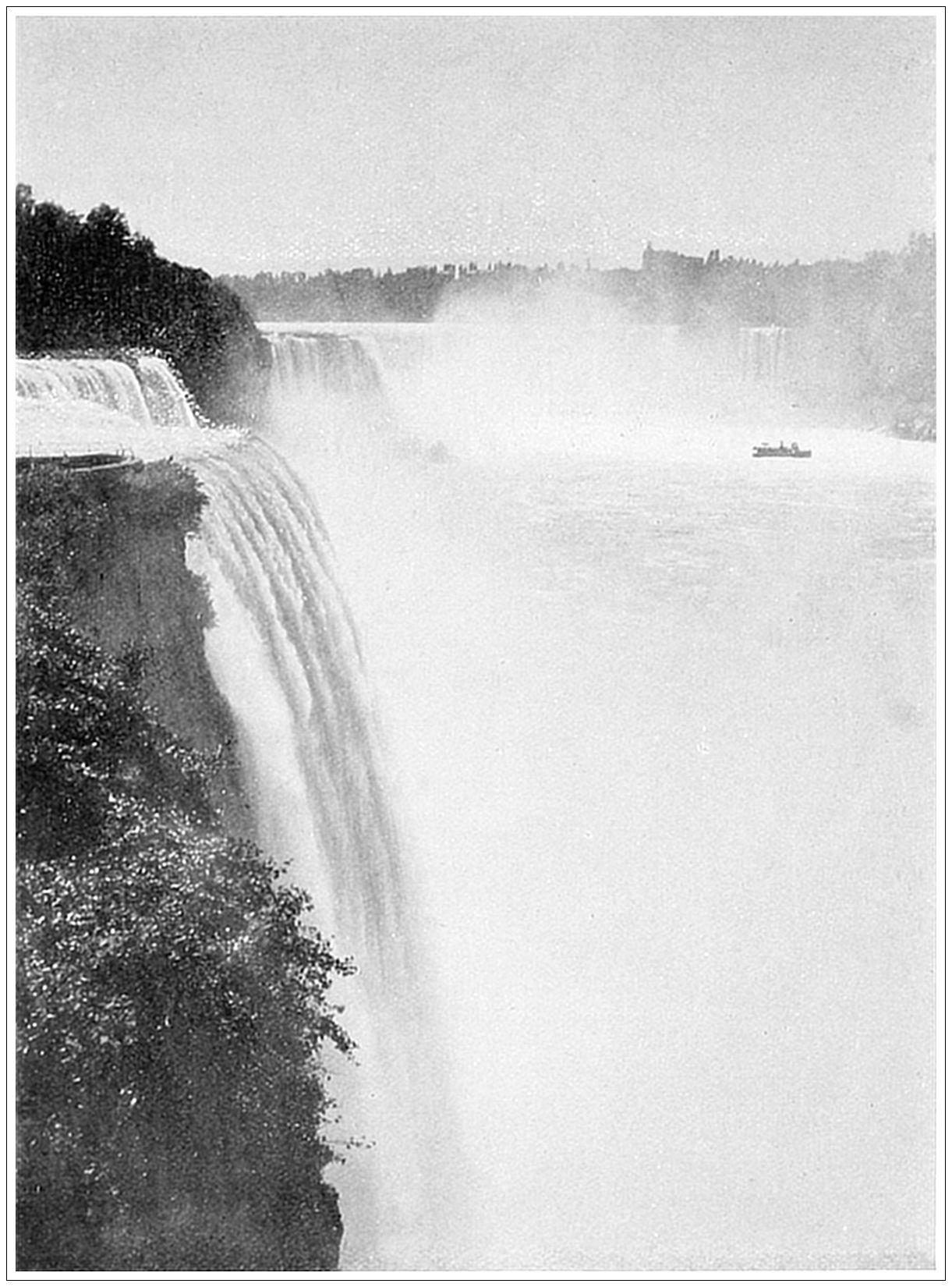
212
THE THOUSAND ISLANDS, CANADA. This, the largest group of river islands in the world, lies in an expansion of the River St. Lawrence at its emergence from Lake Ontario. New York State is on one side and the Province of Ontario, Canada, on the other. The name is not an exaggeration. On the contrary, the group consists of about fifteen hundred rocky islands, remarkable for their great and varied beauty. They are of all shapes and sizes, some just peeping above the surface of the waters, others extending several miles in length, some wild and bare and rocky, others covered with the most luxuriant foliage. Hence, a trip through the St. Lawrence River at this point is full of the most bewildering yet enchanting surprises.

214
VICTORIA BRIDGE, MONTREAL, CANADA. Montreal is situated on the south side of the island of the same name, at the confluence of the Ottawa and the St. Lawrence Rivers. To connect it with the mainland the Victoria Bridge was thrown across the St. Lawrence. Work was begun in 1854. In 1860 the bridge was formally opened by the Prince of Wales during his tour through Canada and the United States. This is one of the greatest triumphs of engineering and architectural skill. The total length is nearly two miles, or, to be exact, nine thousand one hundred and ninety-four feet. It rests upon twenty-four piers and two abutments of solid masonry. The central span is three hundred and thirty feet long.
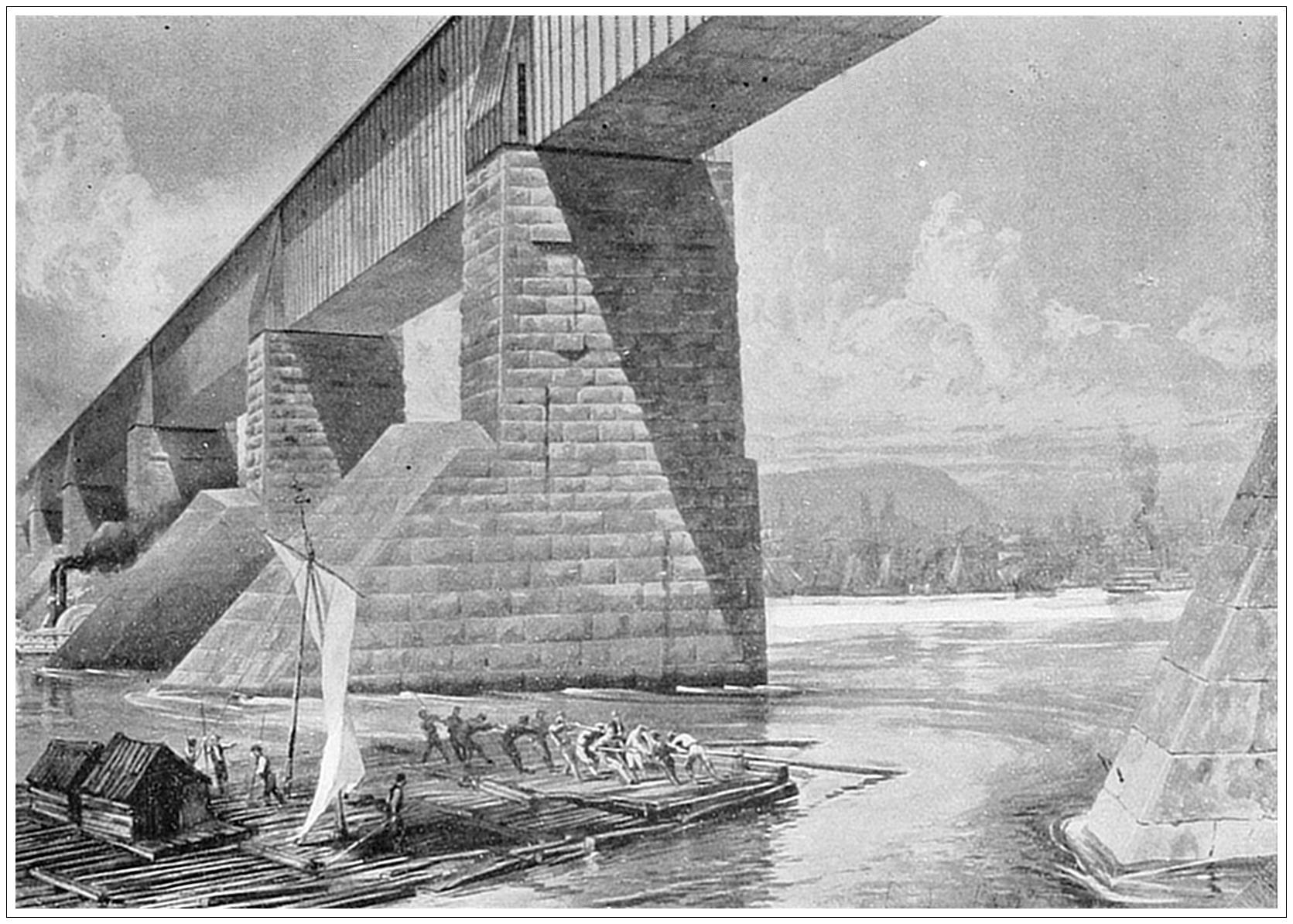
216
THE CAPITOL, WASHINGTON, D. C. A stately and magnificent building devoted to both branches of Congress—the Senate and the House of Representatives—as well as to the United States Supreme Court and the Library of Congress. It stands upon an eminence commanding a beautiful view of the city, and itself forms the most impressive feature in the landscape. The centre building of freestone is flanked by two wings, mainly of marble, and crowned by an iron dome, painted white. From the ground to the top of the nineteen-foot Statue of Liberty, which surmounts the dome, is three hundred and seven and a half feet; the diameter of the dome is one hundred and thirty-five and a half feet. Thus only four domes in Europe can surpass it: St. Peter’s at Rome, St. Paul’s in London, St. Isaac’s in St. Petersburg, and the Invalides in Paris. The building covers an area of about three and a half acres. Its total cost has been over $13,000,000. The corner-stone was laid by Washington in 1792. The marble extensions were begun in 1851.

218
THE WHITE HOUSE, WASHINGTON, D. C. As the official residence of the President of the United States, this mansion has a unique interest. It is not in itself, however, a pretentious or imposing structure. Yet it has some elegance in its very democratic simplicity. Built of freestone, like the original Capitol, and painted white like that, its color has given it its name. The model which the architect had in view was the Palace of the Duke of Leinster in London, and he has followed his prototype very closely. The corner-stone was laid in 1792; the building was first occupied by President John Adams in 1800; it was burned by the British in 1814, and restored and re-occupied in 1818. Since that time there have been staccato clamors for a more magnificent entourage for the chief executive officer of the United States, but nothing further has been accomplished.

220
INDEPENDENCE HALL, PHILADELPHIA. This plain, but substantial brick building, which stands on Chestnut Street, Philadelphia, is ever memorable as the birthplace of the American republic. Here the General Assembly of Pennsylvania gave way to the Continental Congress. Here George Washington was elected commander of the American forces (June, 1775). And here, on July 4th, 1776, the Declaration of Independence was adopted by Congress. Four days later it was read from before the building to an excited and exultant multitude. The halls have been restored as far as possible to their original condition; the east room, where the Declaration was signed, is ornamented with portraits of the signers and the west room is a museum of revolutionary and other relics. The famous Liberty Bell, which was rung as a signal to the people that the Declaration had been adopted, is now suspended under the tower in full view of the public. The building dates from 1729–34.

222
THE EAST RIVER BRIDGE, between New York City and Brooklyn, more familiarly known as the Brooklyn Bridge, is a massive suspension bridge, the largest in the world, which connects New York with Brooklyn. Its colossal towers and ponderous cables loom up conspicuously before the stranger who approaches New York from the riverside. Begun in 1870, it was opened for traffic May 24th, 1883, at a total cost of $15,000,000. The whole length of the bridge is five thousand nine hundred and eighty-nine feet. From high water mark to the floor of the bridge is one hundred and thirty-five feet. The central span (itself measuring one thousand five hundred and ninety-five and a half feet) is suspended to four cables of steel wire, each fifteen and three-quarter inches in diameter. The width of the structure is eighty-five feet, which includes a promenade for foot passengers, two roadways for vehicles, and two railway tracks on which run passenger cars propelled by a stationary engine from the Brooklyn side.

Punctuation, hyphenation, and spelling were made consistent when a predominant preference was found in the original book; otherwise they were not changed.
A few very simple typographical errors were corrected.
This book always uses “Canon,” never “Canyon.” It contains several likely typographical errors or misspellings, most of which have not been changed by the Transcribers. Some are noted below.
Page 42: “mertons” was printed that way.
Page 72: “Propylacum” was printed that way.
Page 120: “Andulasia” was printed that way.
Page 162: “Michel Angelo” was printed that way.
Page 178: “sea of Marmora” was printed that way.